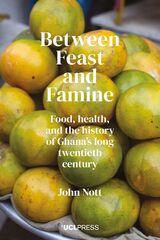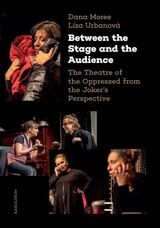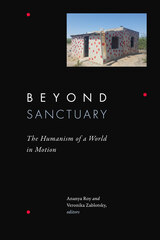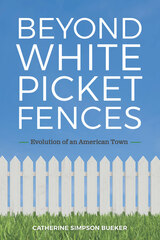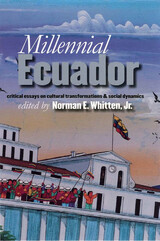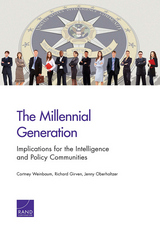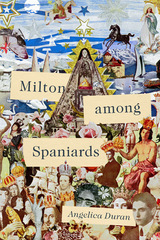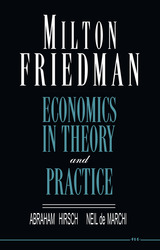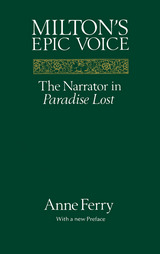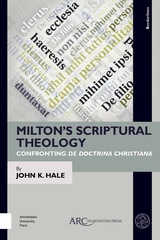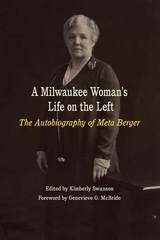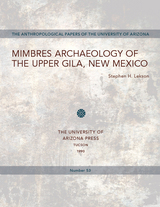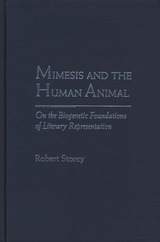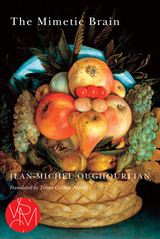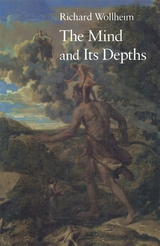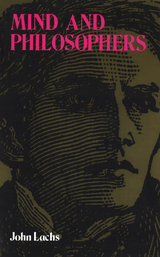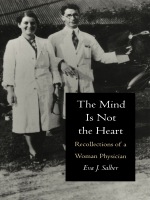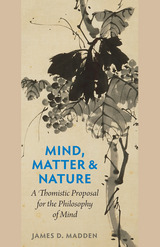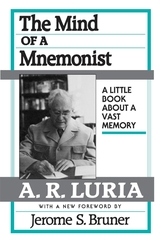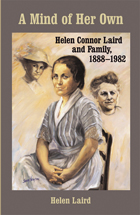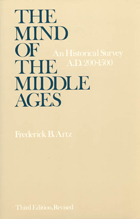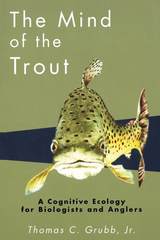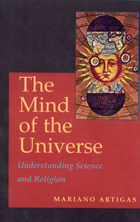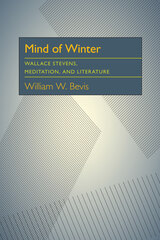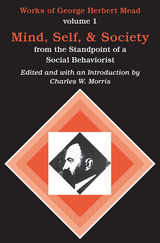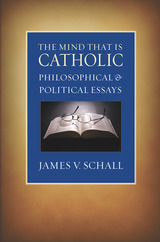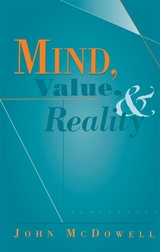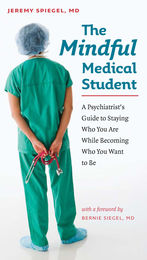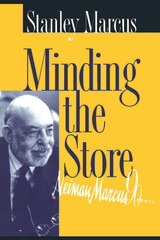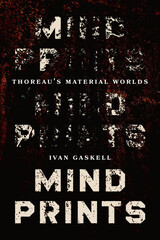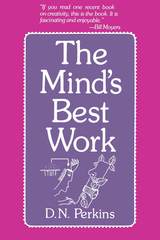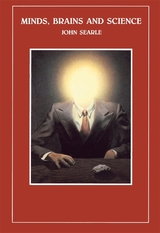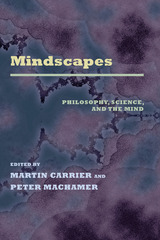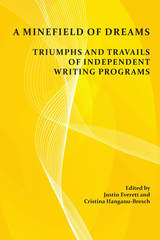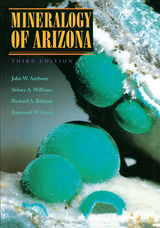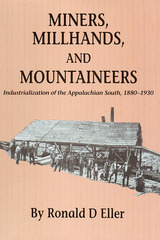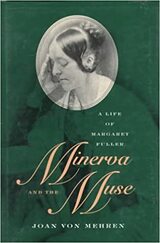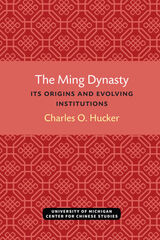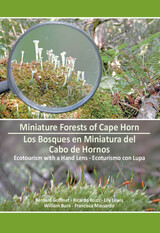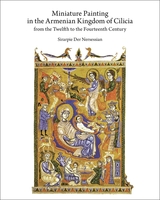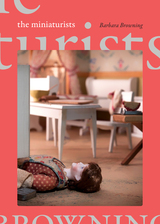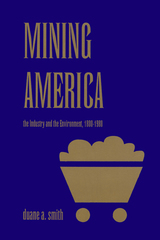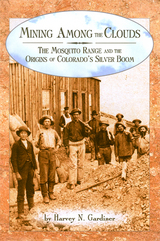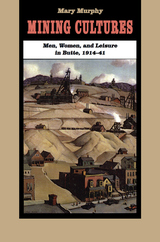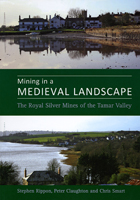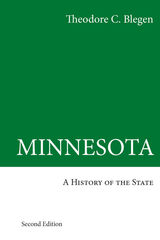 The Millenarian World of Early Mormonism
Grant Underwood
University of Illinois Press, 1994 The most detailed study yet of early Mormon thought about the "end times," The Millenarian World of Early Mormonism shows how early LDS interpretation of the Bible and the Book of Mormon affected, and was affected by, Mormon millennial doctrines. Grant Underwood provides the first comprehensive linkage of the history of early Mormonism and millennial thought, reassessing Mormonism's relationship to the dominant culture and placing Mormon millennial thought in the broader context of Judeo-Christian ideas about the end of the world.
"A model of first-rate scholarship and balanced interpretation; it has much to say not only to those interested in Mormon history but also to anyone seeking to understand the role of millenarian ideas in the American experience." -- Michael Barkun, Journal of American History
"No serious student of early Mormon history should fail to read this book." -- L. B. Tipson, Choice
"A signal contribution to Mormon studies. Anyone who wishes to explore the core of the Mormon identity in the nineteenth century will have to come to terms with this book." -- Richard T. Hughes, author of Reviving the Ancient Faith: The Story of Churches of Christ in America
 Millenarianism and Peasant Politics in Vietnam
Hue-Tam Ho Tai
Harvard University Press, 1983 Millenarianism—the belief in the coming of an ideal society—provided nineteenth century Vietnamese peasants with a total, holistic solution to the hardships of their frontier environment. It gave religious meaning to their sufferings and promised them salvation and rebirth in a world made perfect through cataclysmic change. Transcending the conventional tendency to view millenarian movements merely as forms of protest, the author weaves together the temporal, spatial, and mythic patterns of Vietnamese millenarianism to recreate the moral and religious universe of its followers.
Hue-Tam Ho Tai traces the impact of millenarianism on Vietnamese society as its believers strove for salvation through both piety and violence. She shows how the dream of a perfect world helped the twentieth century Hoa Hao sect build a huge peasant following and how its apocalyptic vision of change eventually drove the sect into conflict with Communist revolutionaries.
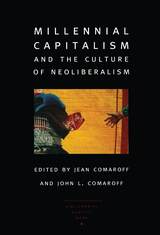 Millennial Capitalism and the Culture of Neoliberalism
Jean Comaroff and John L. Comaroff, eds.
Duke University Press, 2001 The essays in Millennial Capitalism and the Culture of Neoliberalism pose a series of related questions: How are we to understand capitalism at the millennium? Is it a singular or polythetic creature? What are we to make of the culture of neoliberalism that appears to accompany it, taking on simultaneously local and translocal forms? To what extent does it make sense to describe the present juncture in world history as an “age of revolution,” one not unlike 1789–1848 in its transformative potential? In exploring the material and cultural dimensions of the Age of Millennial Capitalism, the contributors interrogate the so-called crisis of the nation-state, how the triumph of the free market obscures rising tides of violence and cultures of exclusion, and the growth of new forms of identity politics. The collection also investigates the tendency of neoliberal capitalism to produce a world of increasing differences in wealth, environmental catastrophes, heightened flows of people and value across space and time, moral panics and social impossibilities, bitter generational antagonisms and gender conflicts, invisible class distinction, and “pariah” forms of economic activity. In the process, the volume opens up an empirically grounded, conceptual discussion about the world-at-large at a particularly momentous historical time—when the social sciences and humanities are in danger of ceding intellectual initiative to the masters of the market and the media. In addition to its crossdisciplinary essays, Millennial Capitalism and the Culture of Neoliberalism—originally the third installment of the journal Public Culture’s “Millennial Quartet”—features several photographic essays. The book will interest anthropologists, political geographers, economists, sociologists, and political theorists. Contributors. Scott Bradwell, Jean Comaroff, John L. Comaroff, Fernando Coronil, Peter Geschiere, David Harvey, Luiz Paulo Lima, Caitrin Lynch, Rosalind C. Morris, David G. Nicholls, Francis Nyamnjoh, Elizabeth A. Povinelli, Paul Ryer, Allan Sekula, Irene Stengs, Michael Storper, Seamus Walsh, Robert P. Weller, Hylton White, Melissa W. Wright, Jeffrey A. Zimmerman
Millennial Countdown in New Guinea, Volume 47
Pamela J. Stewart and Andrew Strathern, eds.
Duke University Press In parts of the world where Christianity and indigenous practices have been integrated into hybrid religions, the advent of the new millennium produced an immense stir. "Millennial Countdown in New Guinea" provides a unique set of studies based on recent fieldwork that deal with perceptions of the new millennium in New Guinea.
The articles collected here represent a rich ethnographic record of events leading up to the new millennium, exploring "end times" versus "new world" notions among New Guinea societies. Unlike other published collections on New Guinea, this special issue of Ethnohistory focuses on the entire island, with essays on both Irian Jaya and Papua New Guinea. It makes a distinguished contribution to a classic theme in anthropology and the history of religion.
Millennial Ecuador: Critical Essays Cultural Transformations
Norman E Whitten
University of Iowa Press, 2003 In the past decade, Ecuador has seen five indigenous uprisings, the emergence of the powerful Pachakutik political movement, and the strengthening of the Confederation of Indigenous Nationalities of Ecuador and the Association of Black Ecuadorians, all of which have contributed substantially to a new constitution proclaiming the country to be “multiethnic and multicultural.” Furthermore, January 2003 saw the inauguration of a new populist president, who immediately appointed two indigenous persons to his cabinet. In this volume, eleven critical essays plus a lengthy introduction and a timely epilogue explore the multicultural forces that have allowed Ecuador's indigenous peoples to have such dramatic effects on the nation's political structure.
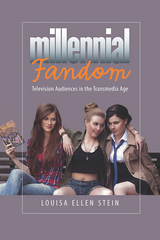 Millennial Fandom: Television Audiences in the Transmedia Age
Louisa Ellen Stein
University of Iowa Press, 2015 No longer a niche or cult identity, fandom now colors our notions of an expansive generational construct—the millennial generation. Like fans, millennials are frequently cast as active participants in media culture, spectators who expect opportunities to intervene, control, and create. At the same time, long-standing fears about fans’ cultural unruliness manifest in rampant stories of millennials’ technological over-dependence and lack of moral boundaries.
These conflicting narratives of entrepreneurial creativity and digital immorality operate to quell the growing threat represented by millennials’ media agency. With fan activities becoming ever more visible on social media platforms including YouTube, Facebook, LiveJournal, Twitter, Polyvore, and Tumblr, the fan has become the avatar of our digital hopes and fears.
In an ambitious study encompassing a wide range of media texts, including popular television series like Kyle XY, Glee, Gossip Girl, Veronica Mars, and Pretty Little Liars and online works like The Lizzie Bennet Diaries, as well as fan texts from blog posts and tweets to remix videos, YouTube posts, and image-sharing streams, author Louisa Ellen Stein traces the circulation of the contradictory tropes of millennial hope and millennial noir. Looking at what millennials do with digital technology demonstrates the molding impact of commercial representations, and at the same time reveals how millennials are undermining, negotiating, and changing those narratives.
This generation—and the fans it represents—is actively transforming the media landscape into a dynamic, culturally transgressive space of collective authorship. Offering a rich and complex vision of the relationship between fandom and millennial culture, Millennial Fandom will interest fans, millennials, students, and scholars of contemporary media culture alike.
The Millennial Generation: Implications for the Intelligence and Policy Communities
Cortney Weinbaum
RAND Corporation, 2016 In 2015, for the first time, millennials outnumbered baby boomers as the largest generational segment of the U.S. population. This report describes how the intelligence community must engage millennials across multiple segments to succeed in the future: millennials as intelligence clients, employees, and partners and as members of the public.
Millennial Japan: Rethinking the Nation in the Age of Recession, Volume 99
Tomiko Yoda and Harry Harootunian, eds.
Duke University Press Roughly a decade has passed since the bursting of Japan’s bubble economy, and despite some intermittent signs of recovery, the nation’s economic downturn that began in the early 1990s continues in the present. This special issue of South Atlantic Quarterly, "Millennial Japan," was conceived as an attempt to take stock of the so-called Heisei recession in terms of its construction as a moment of major historical transition. The articles collected here examine the discourse surrounding the recession and the ways this discourse has influenced the production of scholarship on Japan.
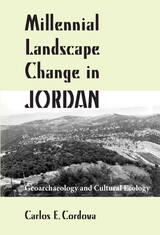 Millennial Landscape Change in Jordan: Geoarchaeology and Cultural Ecology
Carlos E. Cordova
University of Arizona Press, 2007 Stands of relict vegetation, soil horizons, and sedimentary deposits along with archaeological evidence suggest that during certain time spans within the past twenty millennia, Jordan was endowed with moister and more vegetated landscapes than the ones we see today. In this detailed volume, Carlos E. Cordova synthesizes diverse information on multiple topics to provide a comprehensive view of the changes in the Jordanian landscape and the many ways it has been affected by human habitation and the forces of nature.
Cordova focuses on geoarchaeological and cultural ecological aspects of research, presenting data from physical, chemical, and biological sources. He examines the changing influence of climate, vegetation, and hunting opportunities on cultural exploitation tactics, as well as the effects of the growing population and agriculture on the environment. Cordova argues that an interdisciplinary approach to studying the area is crucial to achieving a true understanding of Jordan’s changing landscape.
Chapter topics include approaches to the study of ancient Jordanian landscapes in the Near Eastern context; the physical scene; endowed landscapes of the woodlands; the encroaching drylands; the current and future state of the paleoecological and geoarchaeological record; patterns of millennial landscape change; and the process of interpreting millennial landscape change. The text is abundantly illustrated with photos, line illustrations, tables, and maps, providing a valuable assessment of archaeological developments over the prehistory and history of what today is the Hashemite Kingdom of Jordan. This volume will be especially welcomed by scholars interested in the archaeology, history, and geography of Jordan, the Levant, and the Near East and by field-school students working on archaeological projects in Jordan.
 Millennial Makeover: MySpace, YouTube, and the Future of American Politics
Winograd, Morley
Rutgers University Press, 2008 A 2008 New York Times Notable Book of the Year
It happens in America every four decades and it is about to happen again. America’s demand for change in the 2008 election will cause another of our country’s periodic political makeovers. This realignment, like all others before it, will result from the coming of age of a new generation of young Americans—the Millennial Generation—and the full emergence of the Internet-based communications technology that this generation uses so well. Beginning in 2008, almost everything about American politics and government will transform—voting patterns, the fortunes of the two political parties, the issues that engage the nation, and our government and its public policy.
Building on the seminal work of previous generational theorists,Morley Winograd and Michael D. Hais demonstrate and describe, for the first time, the two types of realignments—“idealist” and “civic”—that have alternated with one another throughout the nation’s history. Based on these patterns, Winograd and Hais predict that the next realignment will be very different from the last one that occurred in 1968. “Idealist” realignments, like the one put into motion forty years ago by the Baby Boomer Generation, produce, among other things, a political emphasis on divisive social issues and governmental gridlock. “Civic” realignments, like the one that is coming, and the one produced by the famous GI or “Greatest” Generation in the 1930s, by contrast, tend to produce societal unity, increased attention to and successful resolution of basic economic and foreign policy issues, and institution-building.
The authors detail the contours and causes of the country’s five previous political makeovers, before delving deeply into the generational and technological trends that will shape the next. The book’s final section forecasts the impact of the Millennial Makeover on the elections, issues, and public policies that will characterize America’s politics in the decades ahead.
For additional information go to:
Millennial Makeover website.
 Millennial Makeover: MySpace, YouTube, and the Future of American Politics
Winograd, Morley
Rutgers University Press, 2008 A 2008 New York Times Notable Book of the Year
It happens in America every four decades and it is about to happen again. America’s demand for change in the 2008 election will cause another of our country’s periodic political makeovers. This realignment, like all others before it, will result from the coming of age of a new generation of young Americans—the Millennial Generation—and the full emergence of the Internet-based communications technology that this generation uses so well. Beginning in 2008, almost everything about American politics and government will transform—voting patterns, the fortunes of the two political parties, the issues that engage the nation, and our government and its public policy.
Building on the seminal work of previous generational theorists,Morley Winograd and Michael D. Hais demonstrate and describe, for the first time, the two types of realignments—“idealist” and “civic”—that have alternated with one another throughout the nation’s history. Based on these patterns, Winograd and Hais predict that the next realignment will be very different from the last one that occurred in 1968. “Idealist” realignments, like the one put into motion forty years ago by the Baby Boomer Generation, produce, among other things, a political emphasis on divisive social issues and governmental gridlock. “Civic” realignments, like the one that is coming, and the one produced by the famous GI or “Greatest” Generation in the 1930s, by contrast, tend to produce societal unity, increased attention to and successful resolution of basic economic and foreign policy issues, and institution-building.
The authors detail the contours and causes of the country’s five previous political makeovers, before delving deeply into the generational and technological trends that will shape the next. The book’s final section forecasts the impact of the Millennial Makeover on the elections, issues, and public policies that will characterize America’s politics in the decades ahead.
For additional information go to:
Millennial Makeover website.
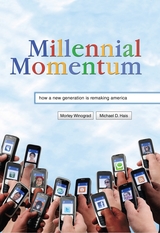 Millennial Momentum: How a New Generation Is Remaking America
Winograd, Morley
Rutgers University Press, 2011 About every eight decades, coincident with the most stressful and perilous events in U.S. history—the Revolutionary and Civil Wars and the Great Depression and World War II—a new, positive, accomplished, and group-oriented “civic generation” emerges to change the course of history and remake America. The Millennial Generation (born 1982–2003) is America’s newest civic generation. In their 2008 book, Millennial Makeover, Morley Winograd and Michael D. Hais made a prescient argument that the Millennial Generation would change American politics for good. Later that year, a huge surge of participation from young voters helped to launch Barack Obama into the White House. Now, in Millennial Momentum, Winograd and Hais investigate how the beliefs and practices of the Millennials are transforming other areas of American culture, from education to entertainment, from the workplace to the home, and from business to politics and government. The Millennials’ cooperative ethic and can-do spirit have only just begun to make their mark, and are likely to continue to reshape American values for decades to come. Drawing from an impressive array of demographic data, popular texts, and personal interviews, the authors show how the ethnically diverse, socially tolerant, and technologically fluent Millennials can help guide the United States to retain its leadership of the world community and the global marketplace. They also illustrate why this generation’s unique blend of civic idealism and savvy pragmatism will enable us to overcome the internal culture wars and institutional malaise currently plaguing the country. Millennial Momentum offers a message of hope for a deeply divided nation.
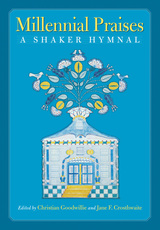 Millennial Praises: A Shaker Hymnal
Christian Goodwillie
University of Massachusetts Press, 2009 From the very beginning in the 1770s, singing was an important part of the worship services of the Shakers, formally known as the United Society of Believers in Christ's Second Appearing. Yet until the early nineteenth century, nearly all Shaker songs were wordless—expressed in unknown tongues or as enthusiastic vocalizations. Only when Shaker missionaries moved west into Ohio and Kentucky did they begin composing hymn texts, chiefly as a means of conveying the sect's unconventional religious ideas to new converts. In 1812–13, the Shakers published their first hymnal. This venture, titled Millennial Praises, included the texts without music for one hundred and forty hymns and elucidated the radical and feminist theology of the Shakers, neatly distilled in verse. This scholarly edition of the hymnal joins the texts to original Shaker tunes for the first time. One hundred and twenty-six of the tunes preserved in the Society's manuscript hymnals have been transcribed from Shaker musical notation into modern standard notation, thus opening this important religious and folk repertoire to modern scholars. Many texts are presented with a wide range of variant tunes from Shaker communities in New England, New York, Ohio, and Kentucky. Introductory essays by volume editors Christian Goodwillie and Jane F. Crosthwaite place Millennial Praises in the context of Shaker history and offer a thorough explication of the Society's theology. They track the use of the hymnal from the point of publication up to the present day, beginning with the use of the hymns by both Shaker missionaries and anti-Shaker apostates and ending with the current use of the hymns by the last remaining Shaker family at Sabbathday Lake, Maine. The volume includes a CD of historical recordings of six Shaker songs by Brother Ricardo Belden, the last member of the Society at Hancock Shaker Village.
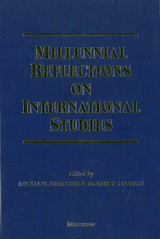 Millennial Reflections on International Studies
Michael Brecher and Frank P. Harvey, Editors
University of Michigan Press, 2002 Forty-five prominent scholars engage in self-critical, state-of-the-art reflection on international studies to stimulate debates about successes and failures and to address the larger question of progress in the discipline. Written especially for the collection, these essays are in hardcover in the form of an easy-to-use handbook, and in paperback as a number of separate titles, each of which consists of a particular thematic cluster to merge with the range of topics taught in undergraduate and graduate courses in international studies. The themes addressed are realism, institutionalism, critical perspectives, feminist theory and gender studies, methodology (formal modeling, quantitative, and qualitative), foreign policy analysis, international security and peace studies, and international political economy. This collection provides an accessible and wide-ranging survey of the issues in the field as well as an invaluable bibliography, and will undoubtedly determine the shape of future research in international studies for the millennium. Paperbacks for course adoption: Realism and Institutionalism in International Studies
Michael Brecher and Frank P. Harvey, Editors Conflict, Security, Foreign Policy, and International Political Economy:Past Paths and Future Directions in International Studies
Michael Brecher and Frank P. Harvey, Editors Evaluating Methodology in International Studies
Frank P. Harvey and Michael Brecher, Editors Critical Perspectives in International Studies
Frank P. Harvey and Michael Brecher, Editors Contributors are: Steve J. Brams, Davis B. Bobrow, Michael Cox, Robert W. Cox, Bruce Bueno de Mesquita, Joseph M. Grieco, Ernst B. Haas , Peter M. Haas, Kal J. Holsti, Ole R. Holsti, Patrick James, Robert O. Keohane, Edward A. Kolodziej, Louis Kriesberg Robert T. Kudrle, David A. Lake, Yosef Lapid, Russell Leng , Jack S. Levy, L. H. M. Ling, Zeev Maoz, Lisa L. Martin, John J. Mearsheimer, Manus I. Midlarsky, Linda B. Miller, Helen Milner , Michael Nicholson, Joseph Nye, V. Spike Peterson , Jan Jindy Pettman, James Lee Ray , James Rosenau, Harvey Starr, J. David Singer, Steve Smith, Christine Sylvester, J. Ann Tickner, John Vasquez, Yaacov Y. I. Vertzberger, R. B. J. Walker, Stephen G. Walker , Jonathan Wilkenfeld, Oran Young, Marysia Zalewski, and Dina A. Zinnes. Michael Brecher is R. B. Angus Professor of Political Science, McGill University, and former president of the International Studies Association. Frank P. Harvey is Professor of Political Science and Director, Center for Foreign Policy Studies, Dalhousie University.
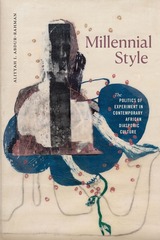 Millennial Style: The Politics of Experiment in Contemporary African Diasporic Culture
Aliyyah I. Abdur-Rahman
Duke University Press, 2024 In Millennial Style, Aliyyah I. Abdur-Rahman looks at recent experiments in black expressive culture that begin in the place of ruin. By ruin, Abdur-Rahman means the political terror and social abjection that constitute the ongoing peril of black lives. Whereas earlier black writers and artists have employed realist modes of expression to represent racial harm and to imaginatively remediate it, the black avant-garde of today displays more experimental methods. Abdur-Rahman outlines four widely employed modes in contemporary African diasporic cultural production: Black Grotesquerie, Hollowed Blackness, Black Cacophony, and the Black Ecstatic. Mobilizing black feminist and black radical thought, she considers work by such cultural practitioners as Wangechi Mutu, Marci Blackman, Alexandria Smith, Colson Whitehead, Toni Morrison, Harmony Holiday, and Essex Hemphill. Writerly and experimental, Millennial Style theorizes contemporary black art as the holding (or hoarding) of black mortal and material resources against the injuries of social death, as the fashioning of relational ethics, and as exuberant black world-building in ruinous times.
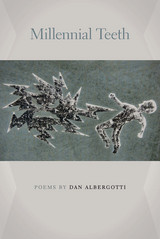 Millennial Teeth
Dan Albergotti
Southern Illinois University Press, 2014 Both bleak and bewildering, Millennial Teeth, the visceral new collection by poet Dan Albergotti, maps a contradictory journey filled with longing and dread, cynicism and hope. A heady mix of traditional forms and more experimental verse, Albergotti’s volume lures readers inexorably into the poet’s obsessions with mystery, doubt, ephemerality, and silence. The poetry in Millennial Teeth will feel both refreshingly new and strangely familiar to Albergotti’s audience. Some poems pay direct tribute to such literary luminaries as Wallace Stevens and Philip Larkin, while others give nods to icons of pop culture, from Radiohead to Roman Polanski. The narrator muses on the resurrection of Christina the Astonishing, the works of Coleridge, and the mindless duties of minor players in Shakespeare’s Hamlet. Yet these familiar faces are not our friends; they are juxtaposed with the heartbreaking apocalypses, both natural and man-made, that have plagued the world since the first plane flew into the World Trade Center. A reluctant witness to such events, the narrator of these poems attempts to navigate his own personal crises, including the mental illness and dementia of loved ones and the inability to connect with others, from the darkness of a personal orbit far from the sun. As he vehemently rejects the notions of religious succor, immortality, and the passive acceptance of fate, he simultaneously yearns to be proven wrong. Yet despite his trials, Albergotti’s narrator maintains a gallows humor and wry insight that balance his despair. A riveting exploration of the all-too-human struggle between faith and doubt, skepticism and obsession, Millennial Teeth has both heart and bite in plenty.
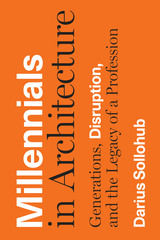 Millennials in Architecture: Generations, Disruption, and the Legacy of a Profession
Darius Sollohub
University of Texas Press, 2019 Much has been written about Millennials, but until now their growing presence in the field of architecture has not been examined in depth. In an era of significant challenges stemming from explosive population growth, climate change, and the density of cities, Millennials in Architecture embraces the digitally savvy disruptors who are joining the field at a crucial time as it grapples with the best ways to respond to a changing physical world. Taking a clear-eyed look at the new generation in the context of the design professions, Darius Sollohub begins by situating Millennials in a line of generations stretching back to early Modernism, exploring how each generation negotiates the ones before and after. He then considers the present moment, closely evaluating the significance of Millennial behaviors and characteristics (from civic-mindedness to collaboration, and time management in a 24/7 culture), all underpinned by fluency in the digital world. The book concludes with an assessment of the profound changes and opportunities that Millennial disruption will bring to education, licensure, and firm management. Encouraging new alliances, Millennials in Architecture is an essential resource for the architectural community and its stakeholders.
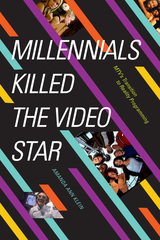 Millennials Killed the Video Star: MTV's Transition to Reality Programming
Amanda Ann Klein
Duke University Press, 2021 Between 1995 and 2000, the number of music videos airing on MTV dropped by 36 percent. As an alternative to the twenty-four-hour video jukebox the channel had offered during its early years, MTV created an original cycle of scripted reality shows, including Laguna Beach, The Hills, The City, Catfish, and Jersey Shore, which were aimed at predominantly white youth audiences. In Millennials Killed the Video Star Amanda Ann Klein examines the historical, cultural, and industrial factors leading to MTV's shift away from music videos to reality programming in the early 2000s and 2010s. Drawing on interviews with industry workers from programs such as The Real World and Teen Mom, Klein demonstrates how MTV generated a coherent discourse on youth and identity by intentionally leveraging stereotypes about race, ethnicity, gender, and class. Klein explores how this production cycle, which showcased a variety of ways of being in the world, has played a role in identity construction in contemporary youth culture—ultimately shaping the ways in which Millennial audiences of the 2000s thought about, talked about, and embraced a variety of identities.
 Millennium Park Chicago
Cheryl Kent
Northwestern University Press, 2011 Since it opened in 2004, Millennium Park has become an essential destination for visitors to and residents of Chicago, second only to Navy Pier. As with many of Chicago’s architectural and artistic marvels, how the park came to be is a story of outsize ambition, luck, political maneuvering, and turning obstacles into opportunities. Cheryl Kent’s lavishly illustrated book is the best general introduction to the park’s history and each of its attractions.
Each chapter describes a conceptual, design, and construction process that defied the odds. From Anish Kapoor’s Cloud Gate (affectionately called “the Bean”) to Frank Gehry’s Jay Pritzker Pavilion, projects that could have been modest and conventional instead blossomed into trophy pieces to rival Picasso’s sculpture in Daley Plaza. In every case, the story of how that transformation occurred shows individuals who invested themselves in the spirit of the enterprise and accomplished more than they ever thought they could. Its millions of visitors attest to Millennium Park’s enduring appeal. Cheryl Kent’s book will be both an essential guide to the park and a keepsake for those who have enjoyed its unique attractions.
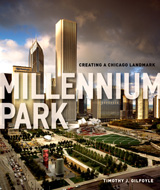 Millennium Park: Creating a Chicago Landmark
Timothy J. Gilfoyle
University of Chicago Press, 2006 At its opening on July 16, 2004, Chicago’s Millennium Park was hailed as one of the most important millennium projects in the world. “Politicians come and go; business leaders come and go,” proclaimed mayor Richard M. Daley, “but artists really define a city.” Part park, part outdoor art museum, part cultural center, and part performance space, Millennium Park is now an unprecedented combination of distinctive architecture, monumental sculpture, and innovative landscaping. Including structures and works by Frank Gehry, Anish Kapoor, Jaume Plensa, and Kathryn Gustafson, the park represents the collaborative efforts of hundreds to turn an unused railroad yard in the heart of the city into a world-class civic space—and, in the process, to create an entirely new kind of cultural philanthropy.
Timothy Gilfoyle here offers a biography of this phenomenal undertaking, beginning before 1850 when the site of the park, the “city’s front yard,” was part of Lake Michigan. Gilfoyle studied the history of downtown; spent years with the planners, artists, and public officials behind Millennium Park; documented it at every stage of its construction; and traced the skeins of financing through municipal government, global corporations, private foundations, and wealthy civic leaders. The result is a thoroughly readable and lavishly illustrated testament to the park, the city, and all those attempting to think and act on a monumental scale. And underlying Gilfoyle’s history is also a revealing study of the globalization of art, the use of culture as an engine of economic expansion, and the nature of political and philanthropic power.
Born out of civic idealism, raised in political controversy, and maturing into a
symbol of the new Chicago, Millennium Park is truly a twenty-first-century
landmark, and it now has the history it deserves.
 Millicent Fenwick: Her Way
Schapiro, Amy
Rutgers University Press, 2003 Amy Schapiro has written the first biography of Millicent Fenwick, the popular and colorful New Jersey congresswoman. Affectionately remembered as the pipe-smoking grandmother who served as the model for Garry Trudeau’s Doonesbury character Lacey Davenport, Fenwick defied such simplistic expectations to become, in the words of Walter Cronkite, “the conscience of Congress.”
Born in 1910 into comfortable circumstances, Fenwick faced tragedy at an early age when her mother was lost in the sinking of the Lusitania. Following an upper-class childhood and a failed marriage, she began a fourteen-year career at Vogue magazine.
In the 1960s, Fenwick became involved in the civil rights movement and took part in local and state politics in New Jersey. Blessed with striking good looks and a sharp wit, she cut a glamorous figure, rising quickly through the ranks of the state Republican Party at a time when most of her peers were retiring. When this colorful, outspoken figure—one of only five New Jersey women ever elected to Congress— went to Washington in 1974 at age sixty-four, her victory was portrayed by the media as a “geriatric triumph.”
Schapiro’s extensive interviews with Fenwick’s son, Hugh, who granted her exclusive rights to Fenwick’s personal papers, oral histories, letters, and photographs, provide rare insight into the life and career of one of America’s most memorable politicians.
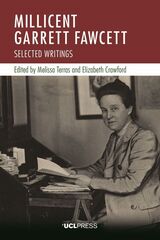 Millicent Garrett Fawcett: Selected Writings
Edited by Melissa Terras and Elizabeth Crawford
University College London, 2022 The first scholarly appraisal of suffragette Dame Millicent Garrett Fawcett in more than 30 years.
“Courage calls to courage everywhere” is the best-known phrase associated with Millicent Garrett Fawcett (1847–1929), the leading UK suffragist and women’s rights campaigner of the late nineteenth and early twentieth centuries. But what is the source of her quote, and what is its context?
This book reproduces Fawcett’s essential speeches, pamphlets, and newspaper columns to tell the story of her dynamic contribution to public life. Thirty-five texts and twenty-two images are contextualized and linked to contemporary news coverage as well as to historical and literary references. These speeches, articles, artworks, and photographs cover both the advances and the defeats in the campaign for women’s votes. They also demonstrate a variety of the topics and causes Fawcett pursued: the provision of education for women, feminist history, a love of literature (and Fawcett’s own attempt at fiction), purity and temperance, the campaign against the employment of children, the British Army’s approach to the South African War, the Unionist cause against Home Rule for Ireland, and the role of suffrage organizations during World War I. This volume offers a rich, intertextual web of literary works, preferred reading material, organizations, contacts, friends, and sometimes enemies, that reveals Fawcett the individual throughout sixty-one years of campaigning.
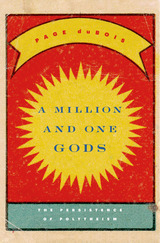 A Million and One Gods: The Persistence of Polytheism
Page duBois
Harvard University Press, 2014 Many people worship not just one but many gods. Yet a relentless prejudice against polytheism denies legitimacy to some of the world’s oldest and richest religious traditions. In her examination of polytheistic cultures both ancient and contemporary—those of Greece and Rome, the Bible and the Quran, as well as modern India—Page duBois refutes the idea that the worship of multiple gods naturally evolves over time into the “higher” belief in a single deity. In A Million and One Gods, she shows that polytheism has endured intact for millennia even in the West, despite the many hidden ways that monotheistic thought continues to shape Western outlooks.
In English usage, the word “polytheism” comes from the seventeenth-century writings of Samuel Purchas. It was pejorative from the beginning—a word to distinguish the belief system of backward peoples from the more theologically advanced religion of Protestant Christians. Today, when monotheistic fundamentalisms too often drive people to commit violent acts, polytheism remains a scandalous presence in societies still oriented according to Jewish, Christian, and Muslim beliefs. Even in the multicultural milieus of twenty-first-century America and Great Britain, polytheism finds itself marginalized. Yet it persists, perhaps because polytheism corresponds to unconscious needs and deeply held values of tolerance, diversity, and equality that are central to civilized societies.
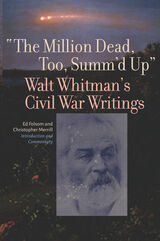 "The Million Dead, Too, Summ'd Up": Walt Whitman's Civil War Writings
Walt Whitman
University of Iowa Press, 2021 This book is the first to offer a comprehensive selection of Walt Whitman’s Civil War poetry and prose with a full commentary on each work. Ed Folsom and Christopher Merrill carry on a dialogue with Whitman (and with each other) as they invite readers to trace how Whitman’s writing about the Civil War develops, shifts, and manifests itself in different genres throughout the years of the war. The book offers forty selections of Whitman’s war writings, including not only the well-known war poems but also his prose and personal letters. Each are followed by Folsom’s critical examination and then by Merrill’s afterword, suggesting broader contexts for thinking about the selection.
The real democratic reader, Whitman said, “must himself or herself construct indeed the poem, argument, history, metaphysical essay—the text furnishing the hints, the clue, the start or frame-work,” because what is needed for democracy to flourish is “a nation of supple and athletic minds.” Folsom and Merrill model this kind of active reading and encourage both seasoned and new readers of Whitman’s war writings to enter into the challenging and exhilarating mode of talking back to Whitman, arguing with him, and learning from him.
A Million Miles: My Peace Corps Journey
Jody Olsen
University of Utah Press, 2024 When Jody Olsen enlisted as a Peace Corps volunteer in Tunisia in 1966, she was fleeing familial tragedy and the stifling societal norms of her Salt Lake City upbringing. However, her service in Tunisia upended her religious and cultural beliefs and propelled her into a six-decade career with the Peace Corps, culminating in her directorship of the agency.
Olsen’s captivating memoir, A Million Miles, reveals the personal and professional challenges she faced throughout her career, which spanned the Reagan era, 9/11, and the Trump administration. She writes candidly about her struggles as a woman in leadership, as well as personal hardships such as the
sudden death of her brother and her emotionally difficult divorce after her husband’s coming out. This memoir is a sharp, vulnerable portrait, a testament to the transformative power of leadership and self-discovery.
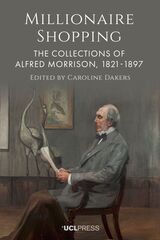 Millionaire Shopping: The Collections of Alfred Morrison, 1821–1897
Edited by Caroline Dakers
University College London, 2025 The first detailed account of Alfred Morrison, the enigmatic Victorian collector and patron of the arts.
Although his fame has faded with time, Alfred Morrison was one of the most influential and avid collectors and patrons of the arts in Victorian England. Morrison was an obsessive and comprehensive collector, using his extravagant wealth to accumulate old master paintings, autograph manuscripts, coins and medals, imperial Chinese porcelain, and other treasures, and his commissions were equally eclectic. Millionaire Shopping includes contributions by contemporary museum curators, scholars, and dealers in painting, sculpture, and decorative arts, with each chapter dedicated to a particular aspect of Morrison’s collecting and patronage. Extensive illustrations, including many never-before-seen images from private archives, help bring his impressive artistic footprint to life.
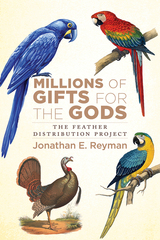 Millions of Gifts for the Gods: The Feather Distribution Project
Jonathan Reyman
University Press of Colorado, 2025 In Millions of Gifts for the Gods, Jonathan E. Reyman chronicles a remarkable thirty-four-year applied anthropology initiative that bridged ancient traditions with contemporary conservation challenges. From 1982 to 2015 the Feather Distribution Project addressed the critical need for macaw, parrot, and wild turkey feathers essential to Pueblo religious practices, directly supporting their constitutional right to freedom of religion.
Grounded in Sol Tax’s concept of “action anthropology,” the project facilitated community-driven decision-making rather than imposing external solutions. This collaborative approach enabled Indigenous communities to maintain cultural practices that have persisted for over a millennium, dating back to the Ancestral Pueblo people and the Mogollon and Sinagua tribes, who viewed birds as sacred beings that helped humans emerge from the underworld. Yet the project’s impact extended far beyond cultural preservation. Over three decades, it distributed approximately 14.5 million feathers, valued at $20 million, to the Southwest Pueblos and other Indigenous Americans at no cost to them. Through partnerships with turkey hunters, zoos, bird clubs, the National Wild Turkey Federation, and dozens of volunteers, the initiative reduced illegal bird smuggling from Latin America, alleviated pressure on threatened bird populations, and eliminated harmful plucking practices.
Millions of Gifts for the Gods is an extended case study in applied anthropology, demonstrating how sustained collaboration between anthropologists and Indigenous communities can effectively address complex cultural, legal, and environmental challenges while preserving sacred traditions. This unique project is of special interest to anthropologists working in the American Southwest, as well as students and scholars of archaeology, ethnography, and ethnohistory.
 Millions of Monarchs, Bunches of Beetles: How Bugs Find Strength in Numbers
Gilbert Waldbauer
Harvard University Press, 2000 Insects that are the least bit social may gather in modest groups, like the dozen or so sawfly larvae feeding on a pine needle, or they may form huge masses, like a swarm of migratory locusts in Africa or a cloud of mayflies at the edge of a midwestern lake or river. Why these insects get together and what they get out of their associations are questions finely and fully considered in this learned and entertaining look at the group behavior and social lives of a wide array of bugs.
The groups that Gilbert Waldbauer discusses here are not as complex or tightly organized as the better-known societies of termites, wasps, ants, and bees. Some, like the mayflies, come together merely because they emerge from the water in the same place at the same time. But others, like swarms of locusts, are loosely organized, the individual insects congregating to migrate together for distances of hundreds of miles. And yet others form a simple cooperative society, such as the colony of tent caterpillars that weaves a silken tent to house the whole group.
Waldbauer tells us how individuals in these and other insect aggregations communicate (or don't), how they coordinate their efforts, how some congregate the better to mate, how some groups improve the temperature and humidity of their microenvironment, and how others safeguard themselves (or the future of their kind) by amassing in such vast numbers as to confound predators.
As engaging and authoritative as Waldbauer's previous books, Millions of Monarchs, Bunches of Beetles will enlighten and delight those who know their insects well and those who wish to know them better.
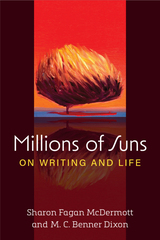 Millions of Suns: On Writing and Life
Sharon Fagan McDermott and M. C. Benner Dixon
University of Michigan Press, 2023 Millions of Suns is an open invitation for all writers to create something new. Each chapter features a pair of essays-in-dialogue between two working artists, Sharon Fagan McDermott and M. C. Benner Dixon, which addresses a specific writing element such as metaphor, inspiration, place, surprise, or imagery. These hybrid essays reveal how two very different writers approach the building blocks of their craft. Explore how white space intersects with grief, how the act of reading changes over a lifetime, or how “familiarity, in life and in stories, invites us in and gives us a hand to hold.” Witness the ways that race and climate change find their way onto the page. Learn how memory can be an act of betrayal or healing.
With decades of combined teaching experience, McDermott and Benner Dixon share practical craft-of-writing advice with the reader, including over fifty engaging writing prompts to spark the creative process. These prompts guide readers toward the freedom and joy that comes with finding one’s authentic voice. Embracing both the painful and the playful, Millions of Suns is an ideal text for classrooms, professional development, or daily writing practice. Through humor, lyricism, and poignancy, the fundamental message of the book remains the same for newcomers and career authors, whether they write poetry, fiction, non-fiction, or memoir. Let Millions of Suns open a door for you into your creative work, inviting imagination, memory, and inspiration into your writing life.
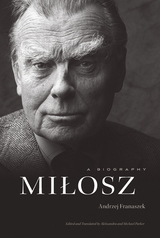 Milosz: A Biography
Andrzej Franaszek
Harvard University Press, 2017 Andrzej Franaszek’s award-winning biography of Czeslaw Milosz—the great Polish poet and winner of the Nobel Prize in Literature in 1980—offers a rich portrait of the writer and his troubled century, providing context for a larger appreciation of his work. This English-language edition, translated by Aleksandra Parker and Michael Parker, contains a new introduction by the translators, along with historical explanations, maps, and a chronology.
Franaszek recounts the poet’s personal odyssey through the events that convulsed twentieth-century Europe: World War I, the Bolshevik revolution, the Nazi invasion and occupation of Poland, and the Soviet Union’s postwar dominance of Eastern Europe. He follows the footsteps of a perpetual outsider who spent much of his unsettled life in Lithuania, Poland, and France, where he sought political asylum. From 1960 to 1999, Milosz lived in the United States before returning to Poland, where he died in 2004.
Franaszek traces Milosz’s changing, constantly questioning, often skeptical attitude toward organized religion. In the long term, he concluded that faith performed a positive role, not least as an antidote to the amoral, soulless materialism that afflicts contemporary civilization. Despite years of hardship, alienation, and neglect, Milosz retained a belief in the transformative power of poetry, particularly its capacity to serve as a source of moral resistance and a reservoir of collective hope. Seamus Heaney once said that Milosz’s poetry is irradiated by wisdom. Milosz reveals how that wisdom was tempered by experience even as the poet retained a childlike wonder in a misbegotten world.
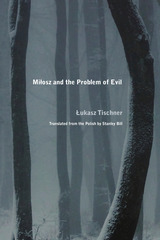 Milosz and the Problem of Evil
Lukasz Tischner; Translated from the Polish by Stanley Bill
Northwestern University Press, 2015 While scholars have chronicled Czesław Miłosz’s engagement with religious belief, no previous book-length treatment has focused on his struggles with theodicy in both poetry and thought. Miłosz wrestled with the problem of believing in a just God given the powerful evidence to the contrary in the natural world as he observed it and in the horrors of World War II and its aftermath in Poland. Rather than attempt to survey Miłosz’s vast oeuvre, Łukasz Tischner focuses on several key works—The Land of Ulro, The World, The Issa Valley, A Treatise on Morals, A Treatise on Poetry, and From the Rising of the Sun—carefully tracing the development of Miłosz’s moral arguments, especially in relation to the key texts that influenced him, among them the Bible, the Gnostic writings, and the works of Blake, Hegel, Kierkegaard, and Schopenhauer. The result is a book that examines Miłosz as both a thinker and an artist, shedding new light on all aspects of his oeuvre.
 Mi-Lou: Poetry and the Labyrinth of Desire
Stephen Owen
Harvard University Press, 1989 Mi-Lou is literally “The Palace of Going Astray,” a pleasure labyrinth built by a Chinese emperor in the early seventh century; whoever entered the Mi-Lou became so entranced that he never wanted to leave. On that architectural model, Stephen Owen's new book explores poetry from various cultures and historical periods, addressing issues of eros in both Chinese and Western poetry, putting poems together that have no right to be together but are somehow more vivid for their conjunction.
In passing from poem to poem, Mi-Lou: Poetry and the Labyrinth of Desire traces the hopes of lyric poetry, along with its compromises and failures. It begins with poems that try to seduce us, to catch us up in their world with visions that provoke desire, an intent embodied in the courtship poem. Owen's work strays through fantasies of replacement and comes finally to Eden and visions of nakedness, both of body and heart. If there is to be a comparative literature that goes beyond the familiar works of the European tradition, illicit conjunctions of works from strange and familiar, ancient and recent writings must be made—otherwise, works that are foreign to the traditional categories will be forced into categories not their own, or left aside as exotic minorities. Mi-Lou's success will not be in any conceptual structure it proposes, but in the pleasure of the poems and the pleasure of slowing down to reflect upon them.
Milton Among Spaniards
Angelica Duran
University of Delaware Press, 2011 Firmly grounded in literary studies but drawing on religious studies, translation studies, drama, and visual art, Milton among Spaniards is the first book-length exploration of the afterlife of John Milton in Spanish culture, illuminating underexamined Anglo-Hispanic cultural relations. This study calls attention to a series of powerful engagements by Spaniards with Milton’s works and legend, following a general chronology from the eighteenth to the early twenty-first century, tracing the overall story of Milton’s presence from indices of prohibited works during the Inquisition, through the many Spanish translations of Paradise Lost, to the author’s depiction on stage in the nineteenth-century play Milton, and finally to the representation of Paradise Lost by Spanish visual artists.
Published by University of Delaware Press. Distributed worldwide by Rutgers University Press.
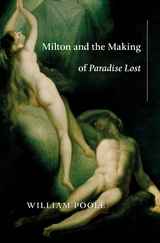 Milton and the Making of Paradise Lost
William Poole
Harvard University Press, 2017 Milton and the Making of Paradise Lost tells the story of John Milton's life as England’s self-elected national poet and explains how the single greatest poem of the English language came to be written.
In early 1642 Milton—an obscure private schoolmaster—promised English readers a work of literature so great that “they should not willingly let it die.” Twenty-five years later, toward the end of 1667, the work he had pledged appeared in print: the epic poem Paradise Lost. In the interim, however, the poet had gone totally blind and had also become a controversial public figure—a man who had argued for the abolition of bishops, freedom of the press, the right to divorce, and the prerogative of a nation to depose and put to death an unsatisfactory ruler. These views had rendered him an outcast.
William Poole devotes particular attention to Milton’s personal situation: his reading and education, his ambitions and anxieties, and the way he presented himself to the world. Although always a poet first, Milton was also a theologian and civil servant, vocations that informed the composition of his masterpiece. At the emotional center of this narrative is the astounding fact that Milton lost his sight in 1652. How did a blind man compose this staggeringly complex, intensely visual work? Poole opens up the epic worlds and sweeping vistas of Milton’s masterpiece to modern readers, first by exploring Milton’s life and intellectual preoccupations and then by explaining the poem itself—its structure, content, and meaning.
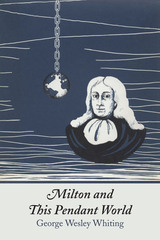 Milton and This Pendant World
By George W. Whiting
University of Texas Press, 1958 Milton and This Pendant World is an interpretation of the great English poet “in an age increasingly skeptical, in a culture dominated by the assumptions of the natural and historical sciences and by the illusions of progress and enlightenment.” Those are the words of the author of this book, George Wesley Whiting, an eminent and devoted Miltonian. Believing that Milton has a vital message for the modern world, Whiting has abandoned the usual pattern for examining a poet—study of versification, meter, and other poetic devices. Instead, he presents an exposition of the spiritual and moral meaning of Milton’s poetry, which can still have truth and beauty for this doubting age. The literary image of the pendant world was familiar in Milton’s seventeenth century, but is meaningless to most people of our day. The comforting picture of the world hanging from heaven on a golden chain signifies God’s close watchfulness over humanity and the inseparable bond which links us to the spiritual kingdom. The author declares that the search for God and the struggle to overcome the spiritual and material forces that impede the search represent the most vital of all human efforts; for unless this search is our primary motivation, life is without meaning, without final purpose. Whiting also observes that true Christianity stands not for the impoverishment of humanity and our enslavement to the Deity, but rather for human moral health, harmonious development, and spiritual welfare. In order to save civilization from destruction at the hands of its friends—secularists, specialists, militarists, and politicians—we must have a renaissance of the spirit, a cultural synthesis in which a revitalized religion, enriched by philosophy and science, renews the ideals of Christianity.
 Milton Babbitt: Words About Music
Stephen Dembski
University of Wisconsin Press, 1987 Many consider Pulitzer Prize-winning composer Milton Babbitt to be the preeminent figure in post-World War II American music. Beyond the extraordinary power of his music, he is also, as he says, “somewhat known as a talker.” In fact, he is renowned as an energetic teacher and inspired lecturer.
In 1983 at the University of Wisconsin–Madison, Babbitt presented a concise summary of his most essential musical insights in a series of lectures and seminars. These are gathered here, presenting for the first time in book form a comprehensive overview of the subjects that have formed the core of his teaching for the past forty years.
Babbitt’s central concern in these lectures is the twelve-tone tradition with which he is so closely identified. His discussion of this tradition ranges from close consideration of specific compositional problems to frank evaluation of his own position in that tradition. In his characteristically penetrating way, Babbitt discusses the most controversial issues in twentieth-century music, from serialism and atonality to the responsibility of the listener and the place of music in the university.
Until now, few have had direct exposure to Babbitt’s ideas. In Madison, he spoke to a variety of audiences and, because of the pedagogical context, his presentation was direct and explanatory. This volume preserves the dazzling constructions and spontaneous excitement of his spoken language.
At the time of publication, Milton Babbitt was William Shubael Conant Professor of Music Emeritus at Princeton University. He has been showered with awards during his long and distinguished career, including the Pulitzer Prize (1982) and a prestigious MacArthur Fellowship (1986). He was a member of the National Institute of Arts and Letters and a Fellow of the American Academy of Arts and Sciences.
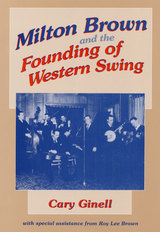 Milton Brown and the Founding of Western Swing
Cary Ginell
University of Illinois Press, 1994 A few weeks before his death in an auto accident, Milton Brown and his band the Musical Brownies recorded forty-nine songs in a single three-day session. That prolific output was a testament to Brown's enormous popularity not only on record but as head of the premier touring act in the Southwest. Cary Ginell draws on interviews and his own musical knowledge to chart Brown's too-short career. Ginell sees Brown as the first key figure to merge blues, jazz, and country into the genre that artists like Bob Wills and Spade Cooley later popularized as Western Swing. Following Brown from his early years to his rise via the Fort Worth dance hall scene, Ginell traces the evolution of the singer-bandleader's musical innovations like adding vocals to dance music and his band's adoption of a style heavy with rhythm and blues. In 1936, Brown and his band stood at the brink of national stardom when Brown's car hit a telephone pole. He died five days later.
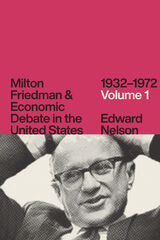 Milton Friedman and Economic Debate in the United States, 1932–1972, Volume 1
Edward Nelson
University of Chicago Press, 2020 Milton Friedman is widely recognized as one of the most influential economists of the twentieth century. Yet no previous study has distilled Friedman’s vast body of writings into an authoritative account of his research, his policy views, and his interventions in public debate. With this ambitious new work, Edward Nelson closes the gap: Milton Friedman and Economic Debate in the United States is the defining narrative on the famed economist, the first to grapple comprehensively with Friedman’s research output, economic framework, and legacy.
This two-volume account provides a foundational introduction to Friedman’s role in several major economic debates that took place in the United States between 1932 and 1972. The first volume, which takes the story through 1960, covers the period in which Friedman began and developed his research on monetary policy. It traces Friedman’s thinking from his professional beginnings in the 1930s as a combative young microeconomist, to his wartime years on the staff of the US Treasury, and his emergence in the postwar period as a leading proponent of monetary policy. The second volume covers the years between 1960 and 1972— years that saw the publication of Friedman and Anna Schwartz’s Monetary History of the United States. The book also covers Friedman’s involvement in a number of debates in the 1960s and 1970s, on topics such as unemployment, inflation, consumer protection, and the environment.
As a fellow monetary economist, Nelson writes from a unique vantage point, drawing on both his own expertise in monetary analysis and his deep familiarity with Friedman’s writings. Using extensive documentation, the book weaves together Friedman’s research contributions and his engagement in public debate, providing an unparalleled analysis of Friedman’s views on the economic developments of his day.
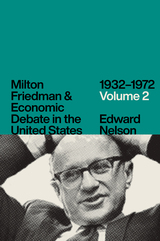 Milton Friedman and Economic Debate in the United States, 1932–1972, Volume 2
Edward Nelson
University of Chicago Press, 2020 Milton Friedman is widely recognized as one of the most influential economists of the twentieth century. Yet no previous study has distilled Friedman’s vast body of writings into an authoritative account of his research, his policy views, and his interventions in public debate. With this ambitious new work, Edward Nelson closes the gap: Milton Friedman and Economic Debate in the United States is the defining narrative on the famed economist, the first to grapple comprehensively with Friedman’s research output, economic framework, and legacy.
This two-volume account provides a foundational introduction to Friedman’s role in several major economic debates that took place in the United States between 1932 and 1972. The first volume, which takes the story through 1960, covers the period in which Friedman began and developed his research on monetary policy. It traces Friedman’s thinking from his professional beginnings in the 1930s as a combative young microeconomist, to his wartime years on the staff of the US Treasury, and his emergence in the postwar period as a leading proponent of monetary policy. The second volume covers the years between 1960 and 1972— years that saw the publication of Friedman and Anna Schwartz’s Monetary History of the United States. The book also covers Friedman’s involvement in a number of debates in the 1960s and 1970s, on topics such as unemployment, inflation, consumer protection, and the environment.
As a fellow monetary economist, Nelson writes from a unique vantage point, drawing on both his own expertise in monetary analysis and his deep familiarity with Friedman’s writings. Using extensive documentation, the book weaves together Friedman’s research contributions and his engagement in public debate, providing an unparalleled analysis of Friedman’s views on the economic developments of his day.
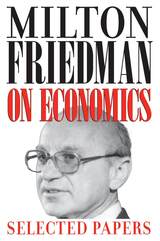 Milton Friedman on Economics: Selected Papers
Milton Friedman
University of Chicago Press, 2007 On his death in the autumn of 2006, Milton Friedman was lauded as “the grandmaster of free-market economic theory in the postwar era” by the New York Times and “the most influential economist of the second half of the 20th century” by the Economist. Winner of the Nobel Prize in Economics in 1976, Friedman was both a highly respected economist and a prominent public intellectual, the leader of a revolution in economic and political thought that argued robustly in favor of virtues of free markets and laissez-faire policies.
Milton Friedman on Economics: Selected Papers collects a variety of Friedman’s papers on topics in economics that were originally published in the Journal of Political Economy. Opening with Friedman’s 1977 Nobel Lecture, the volume spans nearly the whole of his career, incorporating papers from as early as 1948 and as late as 1990. An excellent introduction to Friedman’s economic thought, Milton Friedman will be essential for anyone tracing the course of twentieth-century economics and politics.
 Milton Friedman's Monetary Framework: A Debate with His Critics
Edited by Robert J. Gordon, with essays by Milton Friedman, Karl Brunner and All
University of Chicago Press, 1975 In response to widespread interest in a formal complete statement analyzing aspects of the money-income relationship and clarification of his quantity theory, Milton Friedman in 1970 published "A Theoretical Framework for Monetary Analysis," and a year later "A Monetary Theory of Nominal Income," both in the Journal of Political Economy. A combined version of these essays, first published by the National Bureau of Economic Research, begins this volume.
Because his statement was important and controversial both as a commentary on the history of economic thought and as a theoretical contribution in its own right, the Journal of Political Economy in 1972 presented critical reviews from noted monetary theorists, including Karl Brunner and Allan H. Meltzer, James Tobin, Paul Davidson, and Don Patinkin. Their studies, which are printed in the present volume, focus on substantive issues, covering a variety of topics. All of their major points are discussed in Friedman's reply, which clarifies and expands upon his original themes and introduces interesting new material. Thus the synthesis of his two articles, the critical comments, and his response, together with an introduction by Robert J. Gordon, are combined in one volume for the convenience of scholars and students.
 Milton’s Earthly Paradise: A Historical Study of Eden
Joseph E. Duncan
University of Minnesota Press, 1972 Milton's Earthly Paradise was first published in 1972. Minnesota Archive Editions uses digital technology to make long-unavailable books once again accessible, and are published unaltered from the original University of Minnesota Press editions. This study provides a history of the changing interpretations of the first earthly paradise—the garden of Eden—in Western thought and relates Paradise Lost and other literary works to this paradise tradition. The author traces the beginnings of the tradition as they appear in the Bible and in classical literature and shows how these two strains were joined in early Christian and medieval literature. His emphasis, however, is on the relation of Paradise Lost to Renaissance commentary and to other literary works of the period dealing with the paradise story. Professor Duncan views Paradise Lost as one of many Renaissance works that reveal an untiring effort to understand and explain the first chapters of Genesis. In the rational and humanistic commentary of the Renaissance, he explains, the aim was to provide an interpretation of the literal sense of the Scriptural account that was credible, detailed, and historically valid. He finds that the cumulative influence of the commentary is reflected in Milton's attention to the location of paradise, the emphasis on the natural and the rational in his description of paradise, and in the importance of the typological relationship between the terrestrial and celestial paradises. This illuminating discussion makes it clear that Milton's re-creation of paradise is not only superb poetry but also a penetrating account of the origins of man, involving highly complex and controversial issues.
Milton's Epic Voice: The Narrator in Paradise Lost
Anne Ferry
University of Chicago Press, 1983 Although Paradise Lost is one of the greatest poems in the English language, it is also among the most difficult and intimidating, especially to unsophisticated readers. One of the most accessible critical studies of Paradise Lost—and one frequently recommended by those teaching Milton—is Anne Ferry's Milton's Epic Voice.
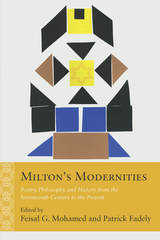 Milton's Modernities: Poetry, Philosophy, and History from the Seventeenth Century to the Present
Edited by Feisal G. Mohamed and Patrick Fadely
Northwestern University Press, 2017 The phrase “early modern” challenges readers and scholars to explore ways in which that period expands and refines contemporary views of the modern. The original essays in Milton’s Modernities undertake such exploration in the context of the work of John Milton, a poet whose prodigious energies simultaneously point to the past and future.
Bristling with insights on Milton’s major works, Milton’s Modernities offers fresh perspectives on the thinkers central to our theorizations of modernity: from Lucretius and Spinoza, Hegel and Kant, to Benjamin and Deleuze. At the volume's core is an embrace of the possibilities unleashed by current trends in philosophy, variously styled as the return to ethics, or metaphysics, or religion. These make all the more visible Milton’s dialogues with later modernity, dialogues that promise to generate much critical discussion in early modern studies and beyond.
Such approaches necessarily challenge many prevailing assumptions that have guided recent Milton criticism—assumptions about context and periodization, for instance. In this way, Milton’s Modernities powerfully broadens the historical archive beyond the materiality of events and things, incorporating as well intellectual currents, hybrids, and insights.
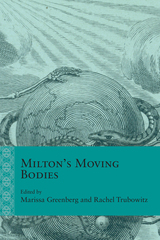 Milton’s Moving Bodies
Marissa Greenberg and Rachel Trubowitz
Northwestern University Press, 2024 A collection of innovative examinations of embodiment in Milton’s oeuvre that challenge assumptions about disciplinary boundaries This volume brings unprecedented focus to the forms, spaces, and implications of embodied motion in Milton’s writing and its afterlives to explore how and why he privileges the body—human and textual—as a site of dynamic movement. The contributors bring a variety of lenses to Milton’s moving bodies: political history, kinematics, mathematics, cosmology, translation, illustration, anatomies of racialized and disabled bodies, and twenty-first-century pedagogies. From these wide-ranging vantage points, they consider anew Milton’s contributions to the histories of scientific development, global exploration and imperial expansion, migration and diaspora, and translation and adaptation in England, Europe, and the Americas, from the early modern period to today. Milton’s Moving Bodies draws together established and emerging scholars, offering fresh analyses of the poet’s legacy for multiple traditions within and beyond Milton studies.
Milton’s Scriptural Theology: Confronting De Doctrina Christiana
John K. Hale
Arc Humanities Press, 2019 Milton spoke of <i>De Doctrina</i> as “my best and most precious possession.” Through close reading of the Latin itself, John K. Hale assesses the work and its aim, its degrees of success and its by-products, as these reveal Milton at his “personal best.” While to historians or methodologists of theology his best might not seem the very best ever, this work was unutterably precious to Milton, and close reading reveals the personal dimension of Milton’s theology and the passion and energy of his mind in its acts of thought.
Milton's Use of Du Bartas
George Coffin Taylor
Harvard University Press This work undertakes to remove a misconception prevailing during the past one hundred and eighty-four years among Milton scholars and the historians of English literature in regard to Milton’s relation to Du Bartas. It presents evidence as to details of language and thought, as to structure, and as to philosophical intentions, upon which is based the conclusion that Du Bartas is the most significant of the sources of Paradise Lost. It offers the student of Milton perhaps his best opportunity to follow Milton in his workshop transmuting his material under our very eyes.
 Milwaukee: A City Built on Water
John Gurda
Wisconsin Historical Society Press, 2026 Paddle through the watery history of the Midwest’s Cream City.
The success and survival of Milwaukee lies in the rivers that meander through its streets and the great lake at its shore. The area’s earliest inhabitants recognized the value of an abundant, clean water supply for food and transportation. Settlers, shipbuilders, and city leaders used the same waters to travel greater distances, power million-dollar industries, and even have a bit of fun.
In Milwaukee: A City Built on Water, celebrated historian John Gurda expands on his popular Milwaukee Public Television documentary, relating the mucky history of the waters that gave Milwaukee life—and occasionally threatened the city through erosion, invasive species, and water-borne diseases.
Telling tales of brewers, brickmakers, ecologists, and engineers, Gurda explores the city’s complicated connection with its most precious resource and greatest challenge. You’ll meet the generations of people, from a Potawatomi chief to fur traders and fishermen, who settled on the small spit of land known as Jones Island; learn how Milwaukee’s unique water composition creates its distinct cream-colored bricks; visit Wisconsin’s first waterparks; and see how city leaders transformed the Milwaukee River—once described as a “vast sewer” with an “odorous tide”—into today’s lively and lovely Riverwalk.
 Milwaukee Braves: Heroes and Heartbreak
William Povletich
Wisconsin Historical Society Press, 2009 During their thirteen years in Wisconsin, the Milwaukee Braves never endured a losing season, won two National League pennants, and in 1957 brought Milwaukee its only World Series championship. With a lineup featuring future Hall of Famers Henry Aaron, Warren Spahn, Eddie Matthews, Red Schoendienst, and Phil Niekro, the team immediately brought Milwaukee "Big League" credentials, won the hearts of fans, and shattered attendance records. The Braves' success in Milwaukee prompted baseball to redefine itself as a big business—resulting in franchises relocating west, multi-league expansion, and teams leveraging cities for civically funded stadiums. But the Braves' instant success and accolades made their rapid fall from grace after winning the 1957 world championship all the more stunning, as declining attendance led the team to Atlanta in one of the ugliest divorces between a city and baseball franchise in sports history. Featuring more than 100 captivating photos, many published here for the first time, Milwaukee Braves preserves the Braves' legacy for the team's many fans and introduces new generations to a fascinating chapter in sports history.
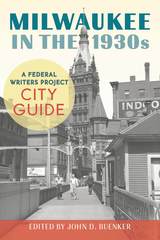 Milwaukee in the 1930s: A Federal Writers Project City Guide
John D. Buenker
Wisconsin Historical Society Press, 2016 What would it be like to take an intensive tour of Milwaukee as it was during the late 1930s—at the confluence of the Great Depression, the New Deal, and the run-up to World War II? That is precisely what the participants in the Federal Writers Project did while researching their Guide to Milwaukee. The fruits of their labors were ready for publication by 1940, but for a number of reasons the finished product never saw the light of day—until now. Fortunately, the manuscript has been carefully preserved in the Wisconsin Historical Society Archives . Seventy-five years after the work’s completion, the Wisconsin Historical Society Press and historian John D. Buenker present this guide—now serving as a time machine, ready to transport readers back to the Milwaukee of the 1930s, neighborhood by neighborhood, building by building. Much more than a nostalgic snapshot, the book examines Milwaukee’s history from its earliest days to 1940. Buenker’s thoughtful introduction provides historical context, detailing the FWP’s development of this guide, as well as Milwaukee’s political climate leading up to, and during, the 1930s. Next, essays on thirteen "areas," ranging from Civic Center to Bay View, delve deeper into the geography, economy, and culture of old Milwaukee’s neighborhoods, and simulated auto tours take readers to locales still familiar today, exploring the city’s most celebrated landmarks and institutions. With a calendar of annual events and a list of public services and institutions, plus dozens of photographs from the era, Milwaukee in the 1930s provides a unique record of a pre–World War II American city.
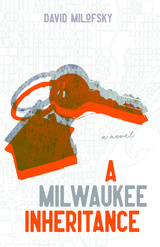 A Milwaukee Inheritance
David Milofsky
University of Wisconsin Press, 2019 Successful Yale Law School grad Andy Simonson returns to Milwaukee if not in triumph, at least thinking he is better off than his blue-collar upbringing. However, coming home again proves to be less than it’s cracked up to be. A childhood friend lands him an associate gig at a big downtown firm. He settles into a lakeside mansion with his mercurial wife, Moira. Then his mother exacts a deathbed promise that he take over as landlord of her rundown duplex on the East Side—complete with delinquent occupants.
Moira is becoming obsessed with starting a family; Andy is becoming obsessed by thoughts of her friend Patsy. An unwinnable domestic dispute involving his shady tenant (and former classmate) Frankie “The Pin” Pignatano takes over more and more of his life. As tensions rise at home, at work, and in the duplex, Andy is forced to decide which vows he can honor.
This slow-burning, finely textured portrait of family dynamics pivots on secrets between generations and how the shadows of the past can darken the future.
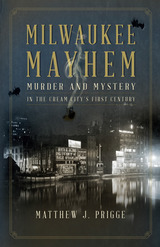 Milwaukee Mayhem: Murder and Mystery in the Cream City's First Century
Matthew J. Prigge
Wisconsin Historical Society Press, 2015 From murder and matchstick men to all-consuming fires, painted women, and Great Lakes disasters--and the wide-eyed public who could not help but gawk at it all--"Milwaukee Mayhem" uncovers the little-remembered and rarely told history of the underbelly of a Midwestern metropolis. "Milwaukee Mayhem" offers a new perspective on Milwaukee's early years, forgoing the major historical signposts found in traditional histories and focusing instead on the strange and brutal tales of mystery, vice, murder, and disaster that were born of the city's transformation from lakeside settlement to American metropolis. Author Matthew J. Prigge presents these stories as they were recounted to the public in the newspapers of the era, using the vivid and often grim language of the times to create an engaging and occasionally chilling narrative of a forgotten Milwaukee. Through his thoughtful introduction, Prigge gives the work context, eschewing assumptions about "simpler times" and highlighting the mayhem that the growth and rise of a city can bring about. These stories are the orphans of Milwaukee's history, too unusual to register in broad historic narratives, too strange to qualify as nostalgia, but nevertheless essential to our understanding of this American city.
The Milwaukee Road: Its First Hundred Years
August Derleth
University of Iowa Press, 2002 From its incorporation in 1847 in Wisconsin Territory to its first run in 1851—twenty miles between Milwaukee and Waukesha—to its later position of far-flung power, the Chicago, Milwaukee, St. Paul &Pacific Railroad Company had a vivid history. By 1948, the Milwaukee Road had more than 40,000 employees and maintained more than 10,000 miles of line in twelve states from Indiana to Washington. Also in 1948, August Derleth's popular and well-crafted corporate history celebrated the strength and status of this mighty carrier. On February 19, 1985, the railroad became a subsidiary of Soo Line Corporation and its identity vanished overnight. Nonetheless, it remains a romantic memory, and Derleth's book remains the only complete history of this innovative and dynamic railroad.
 Milwaukee Through History: A Young Reader's Guide to the People and Events That Shaped a City
James K. Nelsen
Wisconsin Historical Society Press, 2025 New perspectives on state and national history through the lens of Wisconsin's oldest city
This richly illustrated book for middle grade and high school learners uses primary sources and archival photos to explore Milwaukee’s role in Wisconsin and US history. Available in print or accessibility-enhanced e-book format, Milwaukee Through History highlights the city’s multiple transformations—from a resource-rich homeland of several Native nations to an immigrant hub to an industrial boomtown and, finally, to a vibrant tourist destination that continues to grapple with issues of systemic poverty and segregation.
Readers will discover key people, places, events, and innovations that made Milwaukee—and national—history, including:
• Freedom seeker Joshua Glover
• Whitnall Park and the James E. Groppi Unity Bridge
• Labor movements and the fair housing marches
• Industrial giants such as Harley Davidson and Allen Bradley
• Civil rights leader Vel Phillips
Author James K. Nelsen sheds new light on important events and milestones in history, including the American Revolution, the War of 1812, the Civil War, and the Great Migration. Written with students in mind and featuring a glossary and discussion questions, Milwaukee Through History is both an engaging supplement to Wisconsin and US history curricula and a great read for anyone seeking a deeper understanding of a diverse and dynamic city.
A Milwaukee Woman's Life on the Left: The Autobiography of Meta Berger
Meta Berger
Wisconsin Historical Society Press, 2001 Wife, mother, schoolteacher, and politician, Meta Schlichting Berger became an activist at a time when women's role in public life -- indeed, evne their right to vote -- was hotly contested. Telling her story in her own words, Meta Berger reveals her transformation from a traditional wife and mother to an activist who held elective office for thirty years.
Mimbres Archaeology of the Upper Gila, New Mexico
Stephen H. Lekson
University of Arizona Press, 1990 This reappraisal of archaeology conducted at the Saige-McFarland site presents for the first time a substantial body of comparative data from a Mimbres period site in the Gila drainage. Lekson offers a new and controversial interpretation of the Mimbres sequence, reintroducing the concept of the Mangas phase first proposed by the Gila Pueblo investigations of the 1930s and demonstrating a more gradual shift from pithouse to pueblo occupance than has been suggested previously.
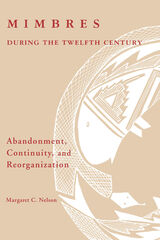 Mimbres during the Twelfth Century: Abandonment, Continuity, and Reorganization
Margaret C. Nelson
University of Arizona Press, 1999 During the mid twelfth century, villages that had been occupied by the Mimbres people in what is now southwestern New Mexico were depopulated and new settlements were formed. While most scholars view abandonment in terms of failed settlements, Margaret Nelson shows that, for the Mimbres, abandonment of individual communities did not necessarily imply abandonment of regions. By examining the economic and social reasons for change among the Mimbres, Nelson reconstructs a process of shifting residence as people spent more time in field camps and gradually transformed them into small hamlets while continuing to farm their old fields. Challenging current interpretations of abandonment of the Mimbres area through archaeological excavation and survey, she suggests that agricultural practices evolved toward the farming of multiple fields among which families moved, with small social groups traveling frequently between small pueblos rather than being aggregated in large villages. Mimbres during the Twelfth Century is the first book-length contribution on this topic for the Classic Mimbres period and also addresses current debates on the role of Casas Grandes in these changes. By rethinking abandonment, Nelson shows how movement by prehistoric cultivators maintained continuity of occupation within a region and invites us to reconsider the dynamic relationship between people and their land.
 Mimbres Far from the Heartland: Identity at the Powers Ranch Site of East-Central Arizona
Mary E. Whisenhunt and Patricia A. Gilman
University of Arizona Press, 2025 This new work offers a unique investigation into the complexities of Mimbres identity and social dynamics beyond the traditional Mimbres Valley heartland. Situated at the western edge of the Mimbres region, the Powers Ranch site represents a professionally excavated Classic period settlement in Arizona’s Gila River Valley. Through excavation and analysis of architecture and a rich array of artifacts, including ceramic sherds, projectile points, and shell artifacts, the authors provide a detailed look at the lives of Mimbres people on the periphery.
This work compares findings from Powers Ranch with those from neighboring sites in the Gila River Valley and further east in the Mimbres Valley, unraveling patterns of identity and affiliation that challenge previous understandings. The study is guided by three key research questions: the extent of affiliation between the community at the Powers Ranch site and Mimbres communities to the east, patterns that suggest Powers Ranch was a habitation and not a limited activity site, and whether the site was unique in comparison with Mimbres occupations situated to the south in the Gila River Valley. Contributions from scholars M. Steven Shackley, Martin H. Welker, and Arthur W. Vokes further enrich this volume, ensuring a comprehensive and authoritative exploration of the Powers Ranch site.
Mimbres Far from the Heartland is an invaluable addition to Southwest archaeology, shedding light on how people constructed unique identities in edge communities and how these identities were expressed through material culture and social networks. Whisenhunt and Gilman’s work significantly advances our understanding of Mimbres communities, offering new insights into the social resilience and cultural affiliations of people living far from their cultural heartland.
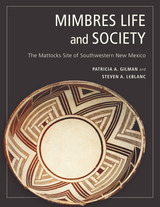 Mimbres Life and Society: The Mattocks Site of Southwestern New Mexico
Patricia A. Gilman and Steven A. LeBlanc
University of Arizona Press, 2017 A thousand years ago, village farmers in the Mimbres Valley of what is now southwestern New Mexico created stunning black-on-white pottery. Mimbres pottery has added a fascinating dimension to southwestern archaeology, but it has also led to the partial or total destruction of most Mimbres sites. The Mimbres Foundation, in one of the few modern investigations of a Mimbres pueblo, excavated the Mattocks site, containing about 180 surface rooms in addition to pit structures. Mimbres Life and Society details the Mattocks site’s architecture and artifacts, and it includes 160 figures, showing more than 400 photographs of painted vessels from the site.
Mimbres pueblos, as early examples of people using surface room blocks, are ideal for investigating questions about how and why people moved from earlier subterranean pit structures to aboveground room blocks. The authors consider the number of households living at the site before and after the transition, as well as the lack of evidence for subsistence intensification and population growth as causes of this transition. These analyses suggest that each room block on the site housed a single family as opposed to multiple families, the more common interpretation. There were not necessarily more households on the site during the Classic period than earlier.
Patricia A. Gilman and Steven A. LeBlanc spent five seasons excavating at the Mattocks site and many more analyzing and writing about Mattocks site data. They note that subtle social differences among people were at play, and they emphasize that the Mattocks site may be unique among Mimbres pueblos in many aspects. Mimbres Life and Society reveals broad-ranging implications for southwestern archaeologists and anyone interested in understanding the ancient Southwest and early village societies.
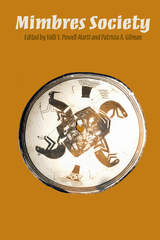 Mimbres Society
Edited by Valli S. Powell-Marti and Patricia A. Gilman
University of Arizona Press, 2006 The enchanting pottery created by the Mimbres people of southwestern New Mexico is considered by many scholars to be unique among all the ancient art traditions of North America. Distinguished by their elaborate hand-painted black-on-white designs, Mimbres vessels have inspired artists and collectors, and many insist that they are unrivaled in several millennia of pottery making.
While the attention to the extraordinary Mimbres painted pottery is well merited, the focus on its artistry alone has obscured other equally remarkable achievements and compelling questions about this unique and sophisticated society. Was the society as truly egalitarian as it has often been suggested? Was the pottery produced by specialists? How did Mimbres architecture—among the first to break living spaces into apartment-style room blocks—reflect the relationships among individuals, families, and communities? Did aggregate housing units translate into social equality, or did subtle hierarchies exist?
Tracing the way technology evolved in ceramic decoration, architecture, and mortuary practices, this collection of eight original contributions brings new insights into previously unexplored dimensions of Mimbres society. The contributors also provide vivid examples of how today’s archaeologists are linking field data to social theory.
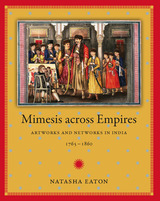 Mimesis across Empires: Artworks and Networks in India, 1765-1860
Natasha Eaton
Duke University Press, 2013 In Mimesis Across Empires, Natasha Eaton examines the interactions, attachments, and crossings between the visual cultures of the Mughal and British Empires during the formative period of British imperial rule in India. Eaton explores how the aesthetics of Mughal "vernacular" art and British "realist" art mutually informed one another to create a hybrid visual economy. By tracing the exchange of objects and ideas—between Mughal artists and British collectors, British artists and Indian subjects, and Indian elites and British artists—she shows how Mughal artists influenced British conceptions of their art, their empire, and themselves, even as European art gave Indian painters a new visual vocabulary with which to critique colonial politics and aesthetics. By placing her analysis of visual culture in relation to other cultural encounters—ethnographic, legislative, diplomatic—Eaton uncovers deeper intimacies and hostilities between the colonizer and the colonized, linking artistic mimesis to the larger colonial project in India.
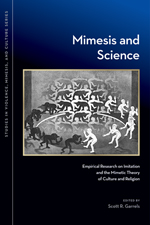 Mimesis and Science: Empirical Research on Imitation and the Mimetic Theory of Culture and Religion
Scott R. Garrels
Michigan State University Press, 2011 This exciting compendium brings together, for the first time, some of the foremost scholars of René Girard’s mimetic theory, with leading imitation researchers from the cognitive, developmental, and neuro sciences. These chapters explore some of the major discoveries and developments concerning the foundational, yet previously overlooked, role of imitation in human life, revealing the unique theoretical links that can now be made from the neural basis of social interaction to the structure and evolution of human culture and religion. Together, mimetic scholars and imitation researchers are on the cutting edge of some of the most important breakthroughs in understanding the distinctive human capacity for both incredible acts of empathy and compassion as well as mass antipathy and violence. As a result, this interdisciplinary volume promises to help shed light on some of the most pressing and complex questions of our contemporary world.
Mimesis and the Human Animal: On the Biogenetic Foundations of Literary Representation
Robert Storey
Northwestern University Press, 1996 In Mimesis and the Human Animal, Robert Storey argues that human culture derives from human biology and that literary representation therefore must have a biological basis. As he ponders the question "What does it mean to say that art imitates life?" he must consider both "What is life?" and "What is art?"
A unique approach to the subject of mimesis, Storey's book goes beyond the politicizing of literature grounded in literary theory to develop a scientific basis for the creation of literature and art.
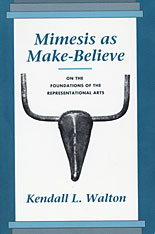 Mimesis as Make-Believe: On the Foundations of the Representational Arts
Kendall L. Walton
Harvard University Press, 1993 Representations—in visual arts and in fiction—play an important part in our lives and culture. Kendall Walton presents here a theory of the nature of representation, which illuminates its many varieties and goes a long way toward explaining its importance. Drawing analogies to children’s make believe activities, Walton constructs a theory that addresses a broad range of issues: the distinction between fiction and nonfiction, how depiction differs from description, the notion of points of view in the arts, and what it means for one work to be more “realistic” than another. He explores the relation between appreciation and criticism, the character of emotional reactions to literary and visual representations, and what it means to be caught up emotionally in imaginary events.
Walton’s theory also provides solutions to the thorny philosophical problems of the existence—or ontological standing—of fictitious beings, and the meaning of statements referring to them. And it leads to striking insights concerning imagination, dreams, nonliteral uses of language, and the status of legends and myths.
Throughout Walton applies his theoretical perspective to particular cases; his analysis is illustrated by a rich array of examples drawn from literature, painting, sculpture, theater, and film. Mimesis as Make-Believe is important reading for everyone interested in the workings of representational art.
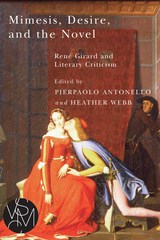 Mimesis, Desire, and the Novel: Rene Girard and Literary Criticism
Pierpaolo Antonello
Michigan State University Press, 2015 Fifty years after its publication in English, René Girard’s Deceit, Desire, and the Novel (1965) has never ceased to fascinate, challenge, inspire, and sometimes irritate, literary scholars. It has become one of the great classics of literary criticism, and the notion of triangular desire is now part of the theoretical parlance among critics and students. It also represents the genetic starting point for what has become one of the most encompassing, challenging, and far-reaching theories conceived in the humanities in the last century: mimetic theory. This book provides a forum for new generations of scholars and critics to reassess, challenge, and expand the theoretical and hermeneutical reach of key issues brought forward by Girard’s book, including literary knowledge, realism and representation, imitation and the anxiety of influence, metaphysical desire, deviated transcendence, literature and religious experience, individualism and modernity, and death and resurrection. It also provides a more extensive and detailed historical understanding of the representation of desire, imitation, and rivalry within European and world literature, from Dante to Proust and from Dickens to Jonathan Littell.
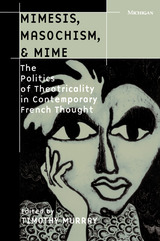 Mimesis, Masochism, and Mime: The Politics of Theatricality in Contemporary French Thought
Timothy Murray, Editor
University of Michigan Press, 1997 In the first collection of its kind, Timothy Murray brings together writing by leading French thinkers on the political effects of theatricality on theater, film, literature, philosophy, and psychoanalysis. In addition to recently translated work by Cixous and Deleuze, the collection features English translations of essays by Althusser, Derrida, Durand, Fanon, Féral, Foucault, Girard, Green, Irigaray, Kristeva, Lacoue-Labarthe, Lyotard, and Marin.
Mimesis, Masochism, & Mime provides a welcome theoretical contribution to recent theories of performance and to the development of French cultural studies. Its emphasis on the politics of theatricality lends unprecedented focus to French theorizations of the body, gender, sight, screen, voice, territoriality, otherness, and diversity. In so doing, the volume provides an intellectual context and theoretical blueprint for future work in the cultural study of mimesis, masochism, and mime. The collection highlights the importance of theatricality to the theory and practice of aesthetics as well as to French debates over patriarchy, absolutism, and metaphysics. In turn, wide-ranging analyses provide a range of approaches to the politics of identity, feminism, marginality, and postcoloniality. Timothy Murray's introduction makes clear the theoretical context of the volume, and situates the book in relation to recent Anglo-American debates over realism, multiculturalism, and identity politics.
The contributors are especially helpful in linking varying political accounts of ideology, philosophy, and psychoanalysis to historical and contemporary work in performance, film, and video. Astute commentaries on Sophocles, Shakespeare, and Artaud are combined with fascinating analyses of more recent mixed-media performance, from the European stage (Duras, Théâtre du Soleil, Bene, and Strehler), to the site of North American performance (Snow, Mabou Mines, Wilson, and Rainer).
Mimesis, Masochism, & Mime provides a stunning account of the political importance of theatricality to contemporary French thought and will be welcomed by readers in French studies, theory, theater, cultural studies, film, women's studies, aesthetics, and psychoanalysis.
"The essays . . .are judiciously chosen, accurately justified, wide in range within the dispensation of post-structuralist thought--that is, they touch on everything from the question of origins to the libidinal economy of performance to post- Brechtian staging to the ineliminable shadow play of tragedy through its ideological demystification by schizoanalysis to feminism in the theater." --Herbert Blau, University of Wisconsin, Milwaukee
Timothy Murray is Professor of English at Cornell University and former Editor of Theatre Journal. He is the author of Theatrical Legitimation: Allegories of Genius in Seventeenth-Century England and France and Like a Film: Ideological Fantasy on Screen, Camera, and Canvas.
The Mimetic Brain
Jean-Michel Oughourlian
Michigan State University Press, 2016 The discovery of mirror neurons in the 1990s led to an explosion of research and debate about the imitative capacities of the human brain. Some herald a paradigm shift on the order of DNA in biology, while others remain skeptical. In this revolutionary volume Jean- Michel Oughourlian shows how the hypotheses of René Girard can be combined with the insights of neuroscientists to shed new light on the “mimetic brain.”
Offering up clinical studies and a complete reevaluation of classical psychiatry, Oughourlian explores the interaction among reason, emotions, and imitation and reveals that rivalry—the blind spot in contemporary neuroscientific understandings of imitation—is a misunderstood driving force behind mental illness. Oughourlian’s analyses shake the very foundations of psychiatry as we know it and open up new avenues for both theoretical research and clinical practice.
 Mimetic Disillusion: Eugene O'Neill, Tennessee Williams, and U.S. Dramatic Realism
Anne Fleche
University of Alabama Press, 1997 Mimetic Disillusion reevaluates the history of modern U.S. drama, showing that at mid-century it turned in the direction of a poststructuralist "disillusionment with mimesis" or mimicry.
This volume focuses on two major writers of the 1930s and 1940s--Eugene O'Neill and Tennessee Williams--one whose writing career was just ending and the other whose career was just beginning. In new readings of their major works from this period, Long Day's Journey into Night, The Iceman Cometh, The Glass Menagerie, and A Streetcar Named Desire, Fleche develops connections to the writings of Jacques Derrida, Paul de Man, and Michel Foucault, among others, and discusses poststructuralism in the light of modern writers such as Bertolt Brecht, Antonin Artaud, and Walter Benjamin. Fleche also extends this discussion to the work of two contemporary playwrights, Adrienne Kennedy and Tony Kushner. The aim of Mimetic Disillusion is not to reject "mimetic" and "realistic" readings but to explore the rich complexities of these two ideas and the fruit of their ongoing relevance to U.S. theatre.
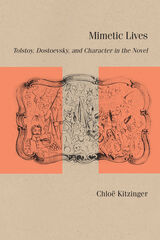 Mimetic Lives: Tolstoy, Dostoevsky, and Character in the Novel
Chloë Kitzinger
Northwestern University Press, 2021 What makes some characters seem so real? Mimetic Lives: Tolstoy, Dostoevsky, and Character in the Novel explores this question through readings of major works by Leo Tolstoy and Fyodor Dostoevsky. Working at the height of the Russian realist tradition, Tolstoy and Dostoevsky each discovered unprecedented techniques for intensifying the aesthetic illusion that Chloë Kitzinger calls mimetic life—the reader’s sense of a character’s autonomous, embodied existence. At the same time, both authors tested the practical limits of that illusion by extending it toward the novel’s formal and generic bounds: philosophy, history, journalism, theology, myth.
Through new readings of War and Peace, Anna Karenina, The Brothers Karamazov, and other novels, Kitzinger traces a productive tension between mimetic characterization and the author’s ambition to transform the reader. She shows how Tolstoy and Dostoevsky create lifelike characters and why the dream of carrying the illusion of “life” beyond the novel consistently fails. Mimetic Lives challenges the contemporary truism that novels educate us by providing enduring models for the perspectives of others, with whom we can then better empathize. Seen close, the realist novel’s power to create a world of compelling fictional persons underscores its resources as a form for thought and its limits as a direct source of spiritual, social, or political change.
Drawing on scholarship in Russian literary studies as well as the theory of the novel, Kitzinger’s lucid work of criticism will intrigue and challenge scholars working in both fields.
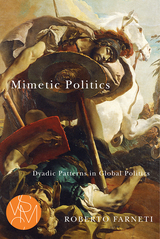 Mimetic Politics: Dyadic Patterns in Global Politics
Roberto Farneti
Michigan State University Press, 2015 War, violence, and the disruption of social orders are critical areas of focus in mimetic theory, and a mimetic perspective applied to the study of politics illuminates social processes and phenomena over and beyond typical explanations offered by mainstream political science. Unlike traditional political science ontology, the mimetic perspective highlights neither individuals nor groups, but “doubles,” or “mimetic twins.” According to this perspective, in order to grasp the fundamental rationales of political processes, we need to concentrate on the distinctive propensity of either individuals or groups to engage in mimetic contests resulting from their unreflective disposition to imitate each other’s desire. This disposition has been strikingly described by the French-American anthropologist Rene Girard: “Once his basic needs are satisfied (indeed sometimes even before), man is subject to intense desires, though he may not know precisely for what.” Via mimetic theory, Farneti highlights phenomena that political scientists have consistently failed to notice, such as reciprocal imitation as the fundamental cause of human discord, the mechanisms of spontaneous polarization in human conflicts (i.e., the emergence of dyads or “doubles”), and the strange and ever-growing resemblance of the mimetic rivals, which is precisely what pushes them to annihilate each other.
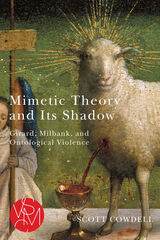 Mimetic Theory and Its Shadow: Girard, Milbank, and Ontological Violence
Scott Cowdell
Michigan State University Press, 2023 Leading Girardian theologian Scott Cowdell seeks to resolve a long-standing challenge to mimetic theory: that it entails a fundamental brutishness—an ontological violence. Girard’s account of scapegoating violence, seen as providing the initial stability for our species to emerge and consolidate, hardly seems compatible with Christian belief in God’s good creation, with violence only appearing after a subsequent Fall. The brilliant but controversial theologian John Milbank has long raised this concern about Girard, grounded in a remarkably sophisticated (though seldom fathomed) philosophical theology. Unpacking Milbank’s program, along with Girard’s recasting of Continental philosophy in light of mimetic theory, Cowdell finds a way between two apparently irreconcilable positions. With irenic spirit but analytic tenacity, he probes for ways through Milbank’s arguments while pressing on growth points in Girard’s. Cowdell’s proposals involve reframing divine creation in light of salvation history, reimagining divine participation by thinking Christ and evolution together, and developing a semiotic approach to mimetic theory that delivers ontological peace hermeneutically. Cowdell shows how Girard’s vision of human transformation through faith in Christ reveals a different world beyond ontological violence while preserving the divine participation that Milbank champions.
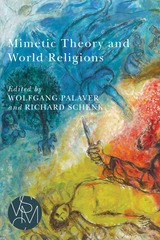 Mimetic Theory and World Religions
Wolfgang Palaver
Michigan State University Press, 2017 Those who anticipated the demise of religion and the advent of a peaceful, secularized global village have seen the last two decades confound their predictions. René Girard’s mimetic theory is a key to understanding the new challenges posed by our world of resurgent violence and pluralistic cultures and traditions. Girard sought to explain how the Judeo-Christian narrative exposes a founding murder at the origin of human civilization and demystifies the bloody sacrifices of archaic religions. Meanwhile, his book Sacrifice, a reading of conflict and sacrificial resolution in the Vedic Brahmanas, suggests that mimetic theory’s insights also resonate with several non-Western religious and spiritual traditions. This volume collects engagements with Girard by scholars of Judaism, Christianity, Islam, Hinduism, and Buddhism and situates them within contemporary theology, philosophy, and religious studies.
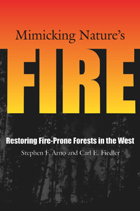 Mimicking Nature's Fire: Restoring Fire-Prone Forests In The West
Stephen F. Arno and Carl E. Fiedler
Island Press, 2005 The magnificent stands of old-growth trees that characterize the forests of western North America depend on periodic fires for their creation or survival. Deprived of that essential disturbance process eventually they die, leaving an overcrowded growth of smaller trees vulnerable to intense blazes and epidemics of insects and disease. In Mimicking Nature's Fire, forest ecologists Stephen Arno and Carl Fiedler present practical solutions to the pervasive problem of deteriorating forest conditions in western North America. Advocating a new direction in forest management, they explore the promise of "restoration forestry" -- an ecologically based approach that seeks to establish forest structures in which fire can once again serve as a beneficial process rather than as a destructive aberration. The book begins with an overview of fundamentals: why traditional forestry tried to exclude fire from forests, why that attempt failed, and why foresters and ecologists now recognize the need for management based on how natural ecosystems operate. Subsequent chapters consider: how fire's historic role provides a foundation for designing restoration strategies; why a hands-off approach will not return forests to their historical condition; how management goals influence the strategies used in restoration forestry. The second part of the book presents case studies of restoration projects in the western United States and Canada, representing different forest types, different historic fire regimes, and contrasting management goals. For each project, the authors describe why and how the project is being conducted, profile forest conditions, and describe methods of treatment. They also report what has been accomplished, identify obstacles to restoration, and offer their candid but understanding evaluation. Mimicking Nature's Fire concludes by placing restoration forestry in the broad context of conserving forests worldwide and outlining factors critical for its success.
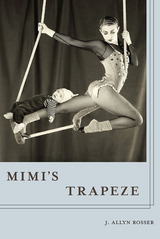 Mimi's Trapeze
J. Allyn Rosser
University of Pittsburgh Press, 2014 Rosser’s poems have always given a squinty sideways glance at cultural foibles and assumptions. Her distinctive brand of cheery skepticism implies that the genuine pursuit of truth is a virtue that renders tolerable the intolerable. These poems achieve a lyricism that gives free reign to the lush energies of language while remaining transparent enough to communicate something precise, fresh, and unsettling.
A driving force behind the poems in Mimi’s Trapeze is Rosser’s profound curiosity about all forms and conditions of life. Without distorting fact or motive, her speakers seek to navigate the mazes of our messy quotidian infelicities, ranging from imperfect love to squashing turtles on the road—from the history of artistic misrepresentations of women to global warming—attempting to calibrate the beautifully complex balance between desire and responsibility.
This collection dwells more on mortality and the lamentable state of the planet (and the spiritual unsoundness of its denizens) than her previous work. Another new vein can be traced in several poems that seek to distill a state like adolescence into a single word (“Dyahe”), reduce vast movements and disciplines into epigrammatic nutshells (Miniature Histories of the World”), or isolate a condition like grief in an element as simple as salt (“After the Service, the Widow Considers the Etymology of Salary”).
In Mimi’s Trapeze, her fourth book, Rosser takes a lighthearted view of dark subjects (see “Final Invitation”), and a dark view of light ones (“Intro to Happiness”). She has refined her vision, reaffirming her belief that poetry is the most direct and effective way for humans to alleviate their loneliness.
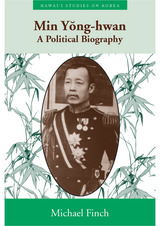 Min Yong-hwan: A Political Biography
Michael Finch
University of Hawaii Press, 2002 The diplomat and scholar-official Min Yông-hwan (1861-1905), described by one contemporary Western observer as "undoubtably the first Korean after the emperor," is best remembered in Korean historiography for his pioneering diplomacy at the courts of Tsar Nicholas II and Queen Victoria in the late 1890s. Furthermore, he is considered to be the foremost patriot of Korea's Taehan era (1897-1907). This pioneering study of Min Yông-hwan is long overdue and provides us with a new perspective on a period of Korean history that still casts its shadow over the region today.
This new biography of Min contributes substantially to our understanding of this period by looking beyond the established view of Korea as being polarized between reformists and reactionaries in the late Choson era. In doing so, it provides us with deeper insight into the full range of responses of the late Choson leadership to the dual challenges of internal stagnation and external intervention at the juncture of the nineteenth and twentieth centuries. It will be essential reading for anyone interested in the recent history of Korea, late nineteenth century imperialism, and Russian, Japanese, American, and British foreign policy in northeast Asia.
Minamata: Pollution and the Struggle for Democracy in Postwar Japan
Timothy S. George
Harvard University Press, 2001 Nearly forty years after the outbreak of the “Minamata Disease,” it remains one of the most horrific examples of environmental poisoning. Based on primary documents and interviews, this book describes three rounds of responses to this incidence of mercury poisoning, focusing on the efforts of its victims and their supporters, particularly the activities of grassroots movements and popular campaigns, to secure redress.
Timothy S. George argues that Japan’s postwar democracy is ad hoc, fragile, and dependent on definition through citizen action and that the redress effort is exemplary of the great changes in the second and third postwar decades that redefined democracy in Japan.
 The Mind and Art of Victorian England
Josef L. Altholz, Editor
University of Minnesota Press, 1976
The Mind and Art of Victorian England was first published in 1976. Minnesota Archive Editions uses digital technology to make long-unavailable books once again accessible, and are published unaltered from the original University of Minnesota Press editions.
In a series of ten essays and a generous selection of illustrations, many in color, this volume depicts and assesses the mind and art of Victorian England. Multidisciplinary in approach, the essays deal with a variety of aspects in the history of the Victorian age.
Professor Altholz, the volume editor, writes: "It was an age not of revolution but of reform; political reform which admitted first the middle and then the working classes to the dominant share of the suffrage; economic and social reforms which proclaimed the triumph of laissez-faire while laying the foundations of the welfare state; moral reforms attempted if not achieved through education and religious revival; aesthetic reforms proposed if not achieved and, even in their failure, adding to the richness and diversity of Victorian England. It was an age whose problems cried out for reform; and, despite the prevailing complacency, virtually all the great Victorians were critics of their age. Their criticisms were diverse and often mutually incompatible, with each other -- and their public -- but they shared a high seriousness which gave character and substance to the flowering of their culture. Such was the Victorian age: the high-water mark of English history, the maturation of British culture, and the seedbed of our problems and our discontents."
The illustrations include color reproductions of some of the works discussed by Melvin Waldfogel in his essay "Narrative Painting," and a selection of architectural engravings and photographs.
 Mind and Context in Adult Second Language Acquisition: Methods, Theory, and Practice
Cristina Sanz, Editor
Georgetown University Press, 2005 How do people learn nonnative languages? Is there one part or function of our brains solely dedicated to language processing, or do we apply our general information-processing abilities when learning a new language? In this book, an interdisciplinary collaboration of scholars and researchers presents an overview of the latter approach to adult second language acquisition and brings together, for the first time, a comprehensive picture of the latest research on this subject. Clearly organized into four distinct but integrated parts, Mind and Context in Adult Second Language Acquisition first provides an introduction to information-processing approaches and the tools for students to understand the data. The next sections explain factors that affect language learning, both internal (attention and awareness, individual differences, and the neural bases of language acquisition) and external (input, interaction, and pedagogical interventions). It concludes by looking at two pedagogical applications: processing instruction and content based instruction. This important and timely volume is a must-read for students of language learning, second language acquisition, and linguists who want to better understand the information-processing approaches to learning a non-primary language. This book will also be of immense interest to language scholars, program directors, teachers, and administrators in both second language acquisition and cognitive psychology.
The Mind and Its Depths
Richard Wollheim
Harvard University Press, 1993 The mind as it is manifested in philosophy and art, in the moral life and psychoanalysis, has always been at the core of Richard Wollheim’s celebrated work. This book brings together Wollheim’s broad and abiding concerns to illuminate human thought at its furthest reaches of introspection and expression. Interweaving philosophy, psychoanalysis, and aesthetics, these essays reveal the critical connections between ideas and disciplines too often regarded as separate and distinct.
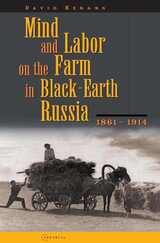 Mind and Labor on the Farm in Black-Earth Russia, 1861-1914
David Kerans
Central European University Press, 2001 Did Tsarist Russia's political and industrial backwardness result from its rigid and archaic agrarian structure? Did the Russian revolution stem in large part from a parasitical elite's exploitation of an enormous peasant class? Was the Russian peasantry itself backward and 'dark' as a result? The attention contemporaries and historians have lavished on these questions has enshrined them as fundamental issues in Russian history. This text endeavours to recast our understanding of the agrarian problem by uncovering the history of both the physical and mental dimensions of agriculture. Employing literary, agronomic and statistical information on peasant labour and culture, this book also offers new perspectives on the limitations of traditional agriculture to adapt to a rapidly changing economic geography, such as that of late nineteenth and early twentieth century Russia. By taking a ground level view of the evolution of Russian agricultural technique, the author arrives at a very different understanding of the agrarian problem. The book identifies both the achievements and limitations of peasant farmers in adapting farming practices to the economic and technological challenges of the half century preceding the revolution. Most importantly, the book delves deeply into peasant life and culture to demonstrate how and why farming imrovements did not pass determinable levels.
 Mind and Media: The Effects of Television, Video Games, and Computers
Patricia Marks Greenfield
Harvard University Press, 1984 Video games, television, and computers are facts of life for today's children. Anxious parents and teachers, concerned with maintaining the intellectual and social richness of childhood, need to understand their effects. Are we producing a generation of passive children who can't read, who require constant visual and aural stimulation, and who prefer the company of technical instruments to friends and family?
Greenfield believes that to answer this question we should not cling to old and elitist assumptions about the value of literacy. Instead she urges that we explore the results of the new research to discover how the various media can be used to promote social growth and thinking skills. She finds that each medium can make a contribution to development, that each has strengths and weaknesses, and that the ideal childhood environment includes a multimedia approach to learning.
Current studies show us, for example, that television may indeed hinder reading ability under some circumstances. Yet it may also be used to enhance and motivate reading. Television can foster visual literacy, teaching children how to interpret close-ups, zooms, and cutting, and beyond this, how to pick up visual details, orient oneself in space, and anticipate formats and patterns of behavior. Video games teach spatial skills and inductive thinking, and classroom computers, contrary to the popular stereotype, encourage cooperative enterprise.
Timely and optimistic, Mind and Media is filled with unexpected conclusions and practical suggestions for helping our children to thrive in a technological world.
Mind and Philosophers
John Lachs
Vanderbilt University Press, 1987 The essays collected in this volume and written between 1959-1980 clearly belong to professional philosophy in both tone and context. Yet their ultimate aim is to explore larger problems and to set the groundwork for dealing with them. For the focus of attention throughout is human nature, not so much in the details of its structure or its social and moral manifestations as in its most general features and constituents. What sort of beings we are and how mind and body are related is the question at the very core of all inquiries into human nature.
 Mind and World
John McDowell
Harvard University Press, 1994 Modern philosophy finds it difficult to give a satisfactory picture of the place of minds in the world. In Mind and World, based on the 1991 John Locke Lectures, one of the most distinguished philosophers writing today offers his diagnosis of this difficulty and points to a cure. In doing so, he delivers the most complete and ambitious statement to date of his own views, a statement that no one concerned with the future of philosophy can afford to ignore.
John McDowell amply illustrates a major problem of modern philosophy—the insidious persistence of dualism—in his discussion of empirical thought. Much as we would like to conceive empirical thought as rationally grounded in experience, pitfalls await anyone who tries to articulate this position, and McDowell exposes these traps by exploiting the work of contemporary philosophers from Wilfrid Sellars to Donald Davidson. These difficulties, he contends, reflect an understandable—but surmountable—failure to see how we might integrate what Sellars calls the “logical space of reasons” into the natural world. What underlies this impasse is a conception of nature that has certain attractions for the modern age, a conception that McDowell proposes to put aside, thus circumventing these philosophical difficulties. By returning to a pre-modern conception of nature but retaining the intellectual advance of modernity that has mistakenly been viewed as dislodging it, he makes room for a fully satisfying conception of experience as a rational openness to independent reality. This approach also overcomes other obstacles that impede a generally satisfying understanding of how we are placed in the world.
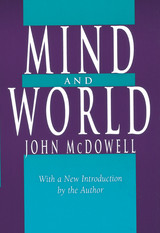 Mind and World: With a New Introduction by the Author
John McDowell
Harvard University Press, 1996 Modern philosophy finds it difficult to give a satisfactory picture of the place of minds in the world. In Mind and World, based on the 1991 John Locke Lectures, one of the most distinguished philosophers writing today offers his diagnosis of this difficulty and points to a cure. In doing so, he delivers the most complete and ambitious statement to date of his own views, a statement that no one concerned with the future of philosophy can afford to ignore.
John McDowell amply illustrates a major problem of modern philosophy—the insidious persistence of dualism—in his discussion of empirical thought. Much as we would like to conceive empirical thought as rationally grounded in experience, pitfalls await anyone who tries to articulate this position, and McDowell exposes these traps by exploiting the work of contemporary philosophers from Wilfrid Sellars to Donald Davidson. These difficulties, he contends, reflect an understandable—but surmountable—failure to see how we might integrate what Sellars calls the “logical space of reasons” into the natural world. What underlies this impasse is a conception of nature that has certain attractions for the modern age, a conception that McDowell proposes to put aside, thus circumventing these philosophical difficulties. By returning to a pre-modern conception of nature but retaining the intellectual advance of modernity that has mistakenly been viewed as dislodging it, he makes room for a fully satisfying conception of experience as a rational openness to independent reality. This approach also overcomes other obstacles that impede a generally satisfying understanding of how we are placed in the world.
The Mind behind the Musical Ear: How Children Develop Musical Intelligence
Jeanne Bamberger
Harvard University Press, 1991 In The Mind behind the Musical Ear, Jeanne Bamberger focuses on the earliest stages in the development of musical cognition. Beginning with children’s invention of original rhythm notations, she follows eight-year-old Jeff as he reconstructs and invents descriptions of simple melodies. In a running commentary on Jeff’s discoveries and a series of dialogues between herself and two imaginary college students who take different approaches to music, Bamberger reflects on the thinking strategies that guide Jeff at various moments in his musical development.
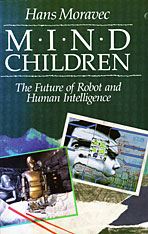 Mind Children: The Future of Robot and Human Intelligence
Hans Moravec
Harvard University Press, 1988 Imagine attending a lecture at the turn of the twentieth century in which Orville Wright speculates about the future of transportation, or one in which Alexander Graham Bell envisages satellite communications and global data banks. Mind Children, written by an internationally renowned roboticist, offers a comparable experience—a mind-boggling glimpse of a world we may soon share with our artificial progeny. Filled with fresh ideas and insights, this book is one of the most engaging and controversial visions of the future ever written by a serious scholar.
Hans Moravec convincingly argues that we are approaching a watershed in the history of life—a time when the boundaries between biological and postbiological intelligence will begin to dissolve. Within forty years, Moravec believes, we will achieve human equivalence in our machines, not only in their capacity to reason but also in their ability to perceive, interact with, and change their complex environment. The critical factor is mobility. A computer rooted to one place is doomed to static iterations, whereas a machine on the prowl, like a mobile organism, must evolve a richer fund of knowledge about an ever-changing world upon which to base its actions.
In order to achieve anything near human equivalence, robots will need, at the least, the capacity to perform ten trillion calculations per second. Given the trillion-fold increase in computational power since the end of the nineteenth century, and the promise of exotic technologies far surpassing the now-familiar lasers and even superconductors, Moravec concludes that our hardware will have no trouble meeting this forty-year timetable.
But human equivalence is just the beginning, not an upper bound. Once the tireless thinking capacity of robots is directed to the problem of their own improvement and reproduction, even the sky will not limit their voracious exploration of the universe. In the concluding chapters Moravec challenges us to imagine with him the possibilities and pitfalls of such a scenario. Rather than warning us of takeover by robots, the author invites us, as we approach the end of this millennium, to speculate about a plausible, wonderful postbiological future and the ways in which our minds might participate in its unfolding.
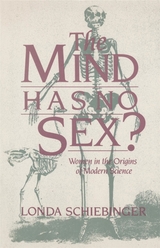 The Mind Has No Sex?: Women in the Origins of Modern Science
Londa Schiebinger
Harvard University Press, 1989 As part of his attempt to secure a place for women in scientific culture, the Cartesian François Poullain de la Barre asserted as long ago as 1673 that “the mind has no sex.” In this rich and comprehensive history of women’s contributions to the development of early modern science, Londa Schiebinger examines the shifting fortunes of male and female equality in the sphere of the intellect. Schiebinger counters the “great women” mode of history and calls attention to broader developments in scientific culture that have been obscured by time and changing circumstance. She also elucidates a larger issue: how gender structures knowledge and power.
It is often assumed that women were automatically excluded from participation in the scientific revolution of early modern Europe, but in fact powerful trends encouraged their involvement. Aristocratic women participated in the learned discourse of the Renaissance court and dominated the informal salons that proliferated in seventeenth-century Paris. In Germany, women of the artisan class pursued research in fields such as astronomy and entomology. These and other women fought to renegotiate gender boundaries within the newly established scientific academies in order to secure their place among the men of science. But for women the promises of the Enlightenment were not to be fulfilled. Scientific and social upheavals not only left women on the sidelines but also brought about what the author calls the “scientific revolution in views of sexual difference.”
While many aspects of the scientific revolution are well understood, what has not generally been recognized is that revolution came also from another quarter—the scientific understanding of biological sex and sexual temperament (what we today call gender). Illustrations of female skeletons of the ideal woman—with small skulls and large pelvises—portrayed female nature as a virtue in the private realm of hearth and home, but as a handicap in the world of science. At the same time, seventeenth- and eighteenth-century women witnessed the erosion of their own spheres of influence. Midwifery and medical cookery were gradually subsumed into the newly profess ionalized medical sciences. Scientia, the ancient female personification of science, lost ground to a newer image of the male researcher, efficient and solitary—a development that reflected a deeper intellectual shift. By the late eighteenth century, a self-reinforcing system had emerged that rendered invisible the inequalities women suffered. In reexamining the origins of modern science, Schiebinger unearths a forgotten heritage of women scientists and probes the cultural and historical forces that continue to shape the course of scientific scholarship and knowledge.
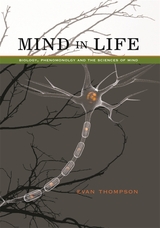 Mind in Life: Biology, Phenomenology, and the Sciences of Mind
Evan Thompson
Harvard University Press, 2010 How is life related to the mind? The question has long confounded philosophers and scientists, and it is this so-called explanatory gap between biological life and consciousness that Evan Thompson explores in Mind in Life.
Thompson draws upon sources as diverse as molecular biology, evolutionary theory, artificial life, complex systems theory, neuroscience, psychology, Continental Phenomenology, and analytic philosophy to argue that mind and life are more continuous than has previously been accepted, and that current explanations do not adequately address the myriad facets of the biology and phenomenology of mind. Where there is life, Thompson argues, there is mind: life and mind share common principles of self-organization, and the self-organizing features of mind are an enriched version of the self-organizing features of life. Rather than trying to close the explanatory gap, Thompson marshals philosophical and scientific analyses to bring unprecedented insight to the nature of life and consciousness. This synthesis of phenomenology and biology helps make Mind in Life a vital and long-awaited addition to his landmark volume The Embodied Mind: Cognitive Science and Human Experience (coauthored with Eleanor Rosch and Francisco Varela).
Endlessly interesting and accessible, Mind in Life is a groundbreaking addition to the fields of the theory of the mind, life science, and phenomenology.
 Mind in Society: Development of Higher Psychological Processes
L. S. Vygotsky
Harvard University Press, 1978 Vygotsky’s sociocultural theory of cognitive development in his own words—collected and translated by an outstanding group of scholars.
“A landmark book.” —Contemporary Psychology
The great Russian psychologist L. S. Vygotsky has long been recognized as a pioneer in developmental psychology. But his theory of development has never been well understood in the West. Mind in Society corrects much of this misunderstanding. Carefully edited by a group of outstanding Vygotsky scholars, the book presents a unique selection of Vygotsky’s important essays, most of which have previously been unavailable in English.
The mind, Vygotsky argues, cannot be understood in isolation from the surrounding society. Humans are the only animals who use tools to alter their own inner world as well as the world around them. Vygotsky characterizes the uniquely human aspects of behavior and offers hypotheses about the way these traits have been formed in the course of human history and the way they develop over an individual's lifetime.
From the handkerchief knotted as a simple mnemonic device to the complexities of symbolic language, society provides the individual with technology that can be used to shape the private processes of the mind. In Mind in Society Vygotsky applies this theoretical framework to the development of perception, attention, memory, language, and play, and he examines its implications for education. The result is a remarkably interesting book that makes clear Vygotsky’s continuing influence in the areas of child development, cognitive psychology, education, and modern psychological thought.
Chapters include:
1. Tool and Symbol in Child Development
2. The Development of Perception and Attention
3. Mastery of Memory and Thinking
4. Internalization of Higher Psychological Functions
5. Problems of Method
6. Interaction between Learning and Development
7. The Role of Play in Development
8. The Prehistory of Written Language
The Mind is Not the Heart: Recollections of a Woman Physician
Eva J. Salber
Duke University Press, 1993 Available for the first time in paperback, Eva Salber's The Mind Is Not the Heart (originally published in 1989), is the personal and political story of a white, Jewish, South African woman who practiced medicine for over fifty years among the impoverished—both rural and urban, black and white, in South Africa and later in the United States. Her lifelong dedication to providing health care to poor people was informed by a passionate vision of the link between social problems and medicine, accompanied by an embracing involvement with the communities in which she served. In this warm clear-eyed account, Dr. Salber presents not only her own personal journey, that of a professional woman, teacher, wife, and mother, but also the story of the people on the margins of society among whom she worked.
 Mind, Matter, and Method: Essays in Philosophy and Science in Honor of Herbert Feigl
Paul K. Feyerabend and Grover Maxwell, Editors
University of Minnesota Press, 1966
Mind, Matter, and Method was first published in 1966. Minnesota Archive Editions uses digital technology to make long-unavailable books once again accessible, and are published unaltered from the original University of Minnesota Press editions.
This volume of twenty-six essays by as many contributors is published in honor of Herbert Feigl, professor of philosophy at the University of Minnesota and director of the Minnesota Center for the Philosophy of Science. Though the majority of the contributors are philosophers, there are also -- as benefits Mr. Feigl's varied intellectual interests -- representatives of psychology, psychoanalysis, and physics.
The first group of ten essays deals with the philosophy of mind, particularly with the mind-body problem, to which Mr. Feigl has devoted much attention. The eleven essays in the second part are concerned with problems of philosophical method, especially with induction and confirmation. The third part is comprised of five essays on the philosophy of the physical sciences. A biographical sketch of Mr. Feigl and a bibliography of his writings are also provided.
Mind, Matter, and Nature
James D. Madden
Catholic University of America Press, 2013 Written for students, Mind, Matter, and Nature presumes no prior philosophical training on the part of the reader. The book nevertheless holds the arguments discussed to rigorous standards and is conversant with recent literature, thus making it useful as well to more advanced students and professionals interested in a resource on Thomistic hylomorphism in the philosophy of mind.
 Mind, Modernity, Madness: The Impact of Culture on Human Experience
Liah Greenfeld
Harvard University Press, 2013 It’s the American dream—unfettered freedom to follow our ambitions, to forge our identities, to become self-made. But what if our culture of limitless self-fulfillment is actually making millions desperately ill? One of our leading interpreters of modernity and nationalism, Liah Greenfeld argues that we have overlooked the connection between egalitarian society and mental illness. Intellectually fearless, encompassing philosophy, psychology, and history, Mind, Modernity, Madness challenges the most cherished assumptions about the blessings of living in a land of the free.
Modern nationalism, says Greenfeld, rests on bedrock principles of popular sovereignty, equality, and secularism. Citizens of the twenty-first century enjoy unprecedented freedom to become the authors of their personal destinies. Empowering as this is, it also places them under enormous psychic strain. They must constantly appraise their identities, manage their desires, and calibrate their place within society. For vulnerable individuals, this pressure is too much. Training her analytic eye on extensive case histories in manic depression and schizophrenia, Greenfeld contends that these illnesses are dysfunctions of selfhood caused by society’s overburdening demands for self-realization. In her rigorous diagnosis, madness is a culturally constituted malady.
The culminating volume of Greenfeld’s nationalism trilogy, Mind, Modernity, Madness is a tour de force in the classic tradition of Émile Durkheim—and a bold foray into uncharted territory. Often counter-intuitive, always illuminating, Mind, Modernity, Madness presents a many-sided view of humanity, one that enriches our deepest understanding of who we are and what we aspire to be.
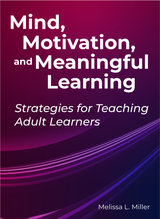 Mind, Motivation, and Meaningful Learning
Melissa L. Miller
Association of College & Research Libraries, 2021 Adults are attending college in record numbers every year. These students, many with families and careers, may have been away from an academic environment for many years and have unique needs in developing lifelong learning skills. Academic librarians have an important role as change agents in this dynamic learning environment through information literacy instruction, workshops, and individual consultations.
Mind, Motivation, and Meaningful Learning: Strategies for Teaching Adult Learners provides a blueprint that academic librarians can apply to their instructional design that facilitates a change in students’ motivation and learning strategies. It provides the tools necessary to teach learners to identify, evaluate, and apply appropriate cognitive, learning, and motivation strategies based on course content and a deeper understanding of the metacognitive component of meaningful learning. Five chapters explore the theories behind adult learning, culminating in a seven-unit curriculum scalable to a variety of learning domains complete with lesson plans, activities, assessments of the learning goals, and student reflections.
Mind, Motivation, and Meaningful Learning can help you identify the components of academic learning that contribute to high achievement; help students learn and practice effective learning and study strategies that lead to improved self-efficacy, self-regulation, and knowledge transfer; and improve instructional design for student, instructor, and academic teaching librarian success.
The Mind of a Mnemonist: A Little Book about a Vast Memory, With a New Foreword by Jerome S. Bruner
A. R. Luria
Harvard University Press, 1968 This study explores the inner world of a rare human phenomenon—a man who was endowed with virtually limitless powers of memory. From his intimate knowledge of S., the mnemonist, gained from conversations and testing over a period of almost thirty years, A. R. Luria is able to reveal in rich detail not only the obvious strengths of S.’s astonishing memory but also his surprising weaknesses: his crippling inability to forget, his pattern of reacting passively to life, and his uniquely handicapped personality.
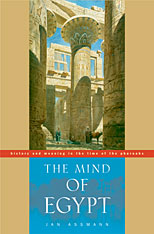 The Mind of Egypt: History and Meaning in the Time of the Pharaohs
Jan Assmann
Harvard University Press, 2003 The Mind of Egypt presents an unprecedented account of the mainsprings of Egyptian civilization--the ideals, values, mentalities, belief systems, and aspirations that shaped the first territorial state in human history. Drawing on a range of literary, iconographic, and archaeological sources, the renowned historian Jan Assmann reconstructs a world of unparalleled complexity, a culture that, long before others, possessed an extraordinary degree of awareness and self-reflection.
Reviews of this book:
Magnificent' Assmann asks what meaning Egyptians obtained from their own constructions of their history. How did they incorporate the legacy of the past into the present. Using three approaches - archeological, mythic, and epigraphic or iconographic - Assmann takes us a chronological journey, starting with the formation of the unified state in about 3100 BC and going through the three great kingdoms. He ends in the late period with the final whimpers of Egyptian civilization. Assmann has looked closely into the mirror of the ancient intangible with telling effect. Every student of early civilization has something to learn from these pages, which will help cure us of intellectual myopia.
--Brian Fagan, The Los Angeles Times
Reviews of this book:
Assmann is attempting something far more ambitious than all the conventional books on Egypt. What he attempts to do is pen a psychological portrait of Egyptian culture. He asks questions that are normally avoided by ancient historians: What motivated the culture? How did it view the relationship between the individual and the universe surrounding him or her? What explanations did it provide for worldly events and reversals of fortune? The result is impressive. The Mind of Egypt marks the culmination of years of questioning about the past and the ways it can be conceptualized. Jan Assmann is close in some ways to being the Beethoven of Egyptology. The Mind of Egypt is a singular book that will provoke debate for a generation to come. It is essential reading for those who wish to call themselves Egyptologists, and it is an important intellectual contribution to the whole question of what constitutes history and historiography.
--John Ray, The American Scholar
Reviews of this book:
[This book's] aim--to examine the mainsprings of Egyptian civilisation and thereby to provide a 'psychological' portrait of Egyptian culture--is truly fascinating.
--History Today
A Mind of Her Own: Helen Connor Laird and Family, 1888–1982
Helen L. Laird
University of Wisconsin Press, 2006 A Mind of Her Own: Helen Connor Laird and Family 1888–1982 captures the public achievement and private pain of a remarkable Wisconsin woman and her family, whose interests and influence extended well beyond the borders of the state. Spanning almost a century, the history speaks to the way we were and are: a stridently materialistic nation with a deep and persistent spiritual component.
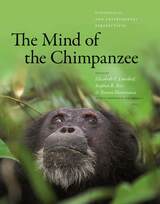 The Mind of the Chimpanzee: Ecological and Experimental Perspectives
Edited by Elizabeth V. Lonsdorf, Stephen R. Ross, and Tetsuro Matsuzawa
University of Chicago Press, 2010 Understanding the chimpanzee mind is akin to opening a window onto human consciousness. Many of our complex cognitive processes have origins that can be seen in the way that chimpanzees think, learn, and behave. The Mind of the Chimpanzee brings together scores of prominent scientists from around the world to share the most recent research into what goes on inside the mind of our closest living relative. Intertwining a range of topics—including imitation, tool use, face recognition, culture, cooperation, and reconciliation—with critical commentaries on conservation and welfare, the collection aims to understand how chimpanzees learn, think, and feel, so that researchers can not only gain insight into the origins of human cognition, but also crystallize collective efforts to protect wild chimpanzee populations and ensure appropriate care in captive settings. With a breadth of material on cognition and culture from the lab and the field, The Mind of the Chimpanzee is a first-rate synthesis of contemporary studies of these fascinating mammals that will appeal to all those interested in animal minds and what we can learn from them.
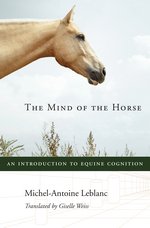 The Mind of the Horse: An Introduction to Equine Cognition
Michel-Antoine Leblanc
Harvard University Press, 2013 Horses were first domesticated about 6,000 years ago on the vast Eurasian steppe extending from Mongolia to the Carpathian Mountains. Yet only in the last two decades have scientists begun to explore the specific mental capacities of these animals. Responding to a surge of interest in fields from ethology to comparative psychology and evolutionary biology, Michel-Antoine Leblanc presents an encyclopedic synthesis of scientific knowledge about equine behavior and cognition. The Mind of the Horse provides experts and enthusiasts alike with an up-to-date understanding of how horses perceive, think about, and adapt to their physical and social worlds.
Much of what we know--or think we know--about "the intelligence of the horse" derives from fragmentary reports and anecdotal evidence. Putting this accumulated wisdom to the test, Leblanc introduces readers to rigorous experimental investigations into how horses make sense of their world under varying conditions. He describes the anatomical and neurophysiological characteristics of the horse's brain, and offers an evolutionary perspective by comparing these features with those of other species. A horseman himself, Leblanc also considers the opinions of renowned riding masters, as well as controversies surrounding the extraordinary powers of the horse's mind that have stirred in equestrian and scientific circles.
Although scientists understand more today about how horses think than at any time in our species' long acquaintance with these animals, much remains in the dark. The Mind of the Horse brings together the current state of equine research and will likely stimulate surprising new discoveries.
The Mind of the Middle Ages: An Historical Survey
Frederick B. Artz
University of Chicago Press, 1980 "This is the third edition of a near standard survey of the intellectual life of the age of faith. Artz on the arts, as on philosophy, politics and other aspects of culture, makes lively and informative reading."—The Washington Post
 The Mind of the Slave: The Limits of Ownership in Roman Law and Society
Nicole J. Giannella
University of Michigan Press, 2026 The Mind of the Slave untangles the double nature of slaves as property and as human beings under the law in the Roman world. As human beings, slaves had free will and legally recognized autonomy while acting for their owner. Although their autonomy was fundamental to the Roman economy, it had the potential to lead to insecurity in the day-to-day experiences of the owner and enslaved person. Will an enslaved agent decide to act in the best interest of their owner? To sell their secrets? To run away? These moments of insecurity are the subject of this book; they reveal an owner’s struggle to know the mind of the slave and to reconcile ownership over a reasoning, emotional, and purposive human being. Nicole J. Giannella argues that this reliance on the mind of the slave reveals fault lines in the ownership of the enslaved. This is where we can glimpse beyond the trappings of law and see the need for negotiation, incentives, and ultimately, the trust that the owner puts in their slave.
In order to place Roman jurists in conversation with both technical and literary sources, Giannella grounds this study in philology and argues that conceptions of the mind of the slave were at the heart of legal and cultural debates about the nature of slavery and ownership. It also contributes to a wider debate about selfhood and autonomy, since philosophers often used the figure of the slave as a representation of humanity as its limits.
The Mind of the Trout: A Cognitive Ecology for Biologists and Anglers
Thomas C. Grubb, Jr.
University of Wisconsin Press, 2003 How and why do trout think? How do they decide where to eat and which food to eat? Why do they refuse to behave as predicted, stumping anglers by rejecting a larger fly for a smaller one or not responding at all to anything in an angler’s box? How do trout know to bolt to one particular covered area after being hooked or flushed? Why can trout smell better than humans but not remember as well? Citing the most recent scientific findings in a readily understandable form, Thomas C. Grubb, Jr. addresses these questions and more in The Mind of the Trout. It is the first book to bring together many varied concepts of cognitive ecology as applied to trout and their salmonid relatives: char, salmon, grayling, and whitefish.
Mind of Winter: Wallace Stevens, Meditation, and Literature
William W. Bevis
University of Pittsburgh Press, 1988
Bevis addresses the most puzzling and least studied aspect of Wallace Stevens’ poetry: detachment. Stevens’ detachment, often associated by readers with asceticism, bareness, or withdrawal, is one of the distinguishing and pervasive characteristics of Stevens’ poetic work. Bevis agues that this detachment is meditative and therefore experiential in origin. Moreover, the meditative Stevens of spare syntax and clear image is in constant tension with the romantic, imaginative Stevens of dazzling metaphors and exuberant flight. Indeed, for Bevis, Stevens is a poet not of imagination and reality, but of imagination and reality, but of imagination and meditation in relation to reality.
Mind, Self, and Society: From the Standpoint of a Social Behaviorist
George Herbert Mead
University of Chicago Press, 1967 Written from the standpoint of the social behaviorist, this treatise contains the heart of Mead's position on social psychology. The analysis of language is of major interest, as it supplied for the first time an adequate treatment of the language mechanism in relation to scientific and philosophical issues.
"If philosophical eminence be measured by the extent to which a man's writings anticipate the focal problems of a later day and contain a point of view which suggests persuasive solutions to many of them, then George Herbert Mead has justly earned the high praise bestowed upon him by Dewey and Whitehead as a 'seminal mind of the very first order.'"—Sidney Hook, The Nation
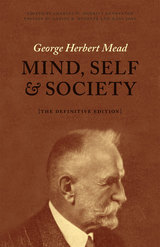 Mind, Self, and Society: The Definitive Edition
George Herbert Mead
University of Chicago Press, 2015 George Herbert Mead is widely recognized as one of the most brilliantly original American pragmatists. Although he had a profound influence on the development of social philosophy, he published no books in his lifetime. This makes the lectures collected in Mind, Self, and Society all the more remarkable, as they offer a rare synthesis of his ideas.
This collection gets to the heart of Mead’s meditations on social psychology and social philosophy. Its penetrating, conversational tone transports the reader directly into Mead’s classroom as he teases out the genesis of the self and the nature of the mind. The book captures his wry humor and shrewd reasoning, showing a man comfortable quoting Aristotle alongside Alice in Wonderland.
Included in this edition are an insightful foreword from leading Mead scholar Hans Joas, a revealing set of textual notes by Dan Huebner that detail the text’s origins, and a comprehensive bibliography of Mead’s other published writings. While Mead’s lectures inspired hundreds of students, much of his brilliance has been lost to time. This new edition ensures that Mead’s ideas will carry on, inspiring a new generation of thinkers.
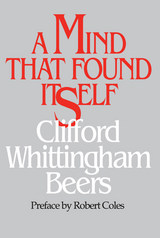 A Mind That Found Itself
Clifford W. Beers
University of Pittsburgh Press, 1981
At once a classic account of the ravages of mental illness and a major American autobiography, A Mind That Found Itself tells the story of a young man who is gradually enveloped by a psychosis. His well-meaning family commits him to a series of mental hospitals, but he is brutalized by the treatment, and his moments of fleeting sanity become fewer and fewer. His ultimate recovery is a triumph of the human spirit.
The publication of A Mind That Found Itself did for the American mental health movement what Thomas Paineís Common Sense did for the American Revolution. Moreover, it grips the imagination of readers not because it is a document of social reform but because it is a superb narrative. As the distinguished psychiatrist and writer Robert Coles has noted, the book ìprovides the virtues of clinical analysis, as well as personal reminiscence, all rendered with a novelistís eye for the particular, for emotional nuance, for chronological progression. . . . Steadily, forthrightly, we come in touch with the nature of delusions and hallucinations: the complex, symbolically charged, nightmarish world of fear, suspicion, irritability and truculence.î
Recovered from his illness, Beers began a lifelong crusade, through the National Committee for Mental Hygiene and the American Foundation for Mental Hygiene, to revolutionize the care and treatment of the mentally ill. The persuasive chronicler of mental illness became a sophisticated, pragmatic organizer and reformer.
A Mind That Found Itself was first published in 1908 but remains compelling and clinically accurate—an unforgettable reading experience.
The Mind That Is Catholic: Philosophical and Political Essays
James V. Schall
Catholic University of America Press, 2008 The Mind That Is Catholic, he presents a retrospective collection of his academic and literary essays written in the past fifty years. In each essay, he exemplifies the Catholic mind at its best--seeing the whole, leaving nothing out.
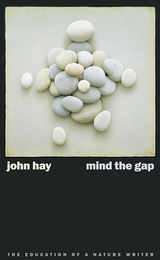 Mind The Gap: The Education Of A Nature Writer
John Hay
University of Nevada Press, 2006 John Hay has been acclaimed as one of the most significant contemporary nature writers and environmentalists. In Mind the Gap, an autobiographic memoir and a passionate commentary on our place in the natural world, he retraces the paths that led to his career and explores the literary and environmental influences that shaped his interest in nature. Born into a respected old New York family, Hay grew up in upper-class Manhattan and rural New Hampshire, between the rigid proprieties of society and the delicious freedoms he discovered during his outdoor adventures. Travel, education, and his own sensitivity and curiosity helped to open the world to him. Shortly after World War II, he moved to a desolate, sandy lot on Cape Cod. Much of the book deals with his life in a small rural community on the Cape, addressing such subjects as the annual herring spawn, resident and migratory birds, local wildlife, his human neighbors, and the complex rhythms of life in this region of wind and sea. Hay’s closely observed descriptions of his surroundings support his insightful comments on nature and our relationship to it. He warns us that “in setting ourselves apart from the rest of living creatures, we fall victim to our own ice-bound conceit. It is only in sharing that we know anything at all.” Hay shares his knowledge generously, and as readers we are thereby enriched. Available in Hardcover and Paperback.
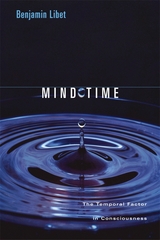 Mind Time: The Temporal Factor in Consciousness
Benjamin Libet
Harvard University Press, 2005 Our subjective inner life is what really matters to us as human beings--and yet we know relatively little about how it arises. Over a long and distinguished career Benjamin Libet has conducted experiments that have helped us see, in clear and concrete ways, how the brain produces conscious awareness. For the first time, Libet gives his own account of these experiments and their importance for our understanding of consciousness.
Most notably, Libet's experiments reveal a substantial delay--the "mind time" of the title--before any awareness affects how we view our mental activities. If all conscious awarenesses are preceded by unconscious processes, as Libet observes, we are forced to conclude that unconscious processes initiate our conscious experiences. Freely voluntary acts are found to be initiated unconsciously before an awareness of wanting to act--a discovery with profound ramifications for our understanding of free will.
How do the physical activities of billions of cerebral nerve cells give rise to an integrated conscious subjective awareness? How can the subjective mind affect or control voluntary actions? Libet considers these questions, as well as the implications of his discoveries for the nature of the soul, the identity of the person, and the relation of the non-physical subjective mind to the physical brain that produces it. Rendered in clear, accessible language, Libet's experiments and theories will allow interested amateurs and experts alike to share the experience of the extraordinary discoveries made in the practical study of consciousness.
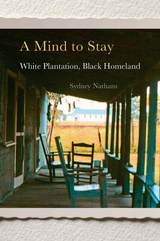 A Mind to Stay: White Plantation, Black Homeland
Sydney Nathans
Harvard University Press, 2017 The exodus of millions of African Americans from the rural South is a central theme of black life and liberation in the twentieth century. A Mind to Stay offers a counterpoint to the narrative of the Great Migration. Sydney Nathans tells the rare story of people who moved from being enslaved to becoming owners of the very land they had worked in bondage, and who have held on to it from emancipation through the Civil Rights era.
The story began in 1844, when North Carolina planter Paul Cameron bought 1,600 acres near Greensboro, Alabama, and sent out 114 enslaved people to cultivate cotton and enlarge his fortune. In the 1870s, he sold the plantation to emancipated black families who worked there. Drawing on thousands of letters from the planter and on interviews with descendants of those who bought the land, Nathans unravels how and why the planter’s former laborers purchased the site of their enslavement, kept its name as Cameron Place, and defended their homeland against challengers from the Jim Crow era to the present day.
Through the prism of a single plantation and the destiny of black families that dwelt on it for over a century and a half, A Mind to Stay brings to life a vivid cast of characters and illuminates the changing meaning of land and landowning to successive generations of rural African Americans. Those who remained fought to make their lives fully free—for themselves, for their neighbors, and for those who might someday return.
Mind, Value, and Reality
John McDowell
Harvard University Press, 2001 This volume collects some of John McDowell's influential papers, written at various times over the last two decades. One group of essays deals mainly with issues in the interpretation of the ethical writings of Aristotle and Plato. A second group of papers contains more direct treatments of questions in moral philosophy that arise naturally out of reflection on the Greek tradition. Some of the essays in the second group exploit Wittgensteinian ideas about reason in action, and they open into the third group of papers, which contains readings of central elements in Wittgenstein's difficult later work. A fourth group deals with issues in the philosophy of mind and with questions about personal identity and the special character of first-personal thought and speech.
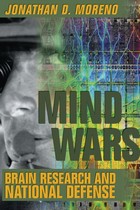 Mind Wars: Brain Research and National Defense
Jonathan D. Moreno
Dana Press, 2006 In his fascinating new book, Jonathan D. Moreno investigates the deeply intertwined worlds of cutting-edge brain science, U.S. defense agencies, and a volatile geopolitical landscape where a nation's weaponry must go far beyond bombs and men. The first-ever exploration of the connections between national security and brain research, Mind Wars: Brain Research and National Defense reveals how many questions crowd this gray intersection of science and government and urges us to begin to answer them.
From neuropharmacology to neural imaging to brain-machine interface devices that relay images and sounds between human brains and machines, Moreno shows how national security entities seek to harness the human nervous system in a multitude of ways as a potent weapon against the enemy soldier. Moreno charts such projects as monkeys moving robotic arms with their minds, technology to read the brain’s thought patterns at a distance, the development of "anti-sleep" drugs to enhance soldiers’ battle performance and others to dampen their emotional reactions to the violence, and advances that could open the door to "neuroweapons"—virus-transported molecules to addle the brain.
"As new kinds of weapons are added to the arsenal already at the disposal of fallible human leaders," Moreno writes, "we need to find new ways to address the problem"--of the ethical military application of so powerful and intimate a science. This book is the first step in confronting the quandaries inherent in this partnership of government and neuroscience, serves as a compelling wake-up call for scientists and citizens, and suggests that, with imagination, we might meet the needs of both security and civil liberty.
The Mindful Medical Student: A Psychiatrist’s Guide to Staying Who You Are While Becoming Who You Want to Be
Jeremy Spiegel
Dartmouth College Press, 2009 Four years in medical school are not only demanding and competitive in a strictly academic sense, but they may bring students face-to-face with perfectionism, anxiety, obsessions, power plays, difficult patients, ethical dilemmas, identity crises, sleep deprivation, financial strain, and—perhaps for the first time in their lives—confrontations with disease, suffering, and death. The Mindful Medical Student will broaden readers’ perspectives and cultivate their ability to respond to the extreme emotional, psychological, and spiritual challenges posed by medical school and, eventually, a medical career. Jeremy Spiegel, MD, tackled these issues head on, prevailed, and became a first-rate psychiatrist. Now, in a vital book, he shares what he has learned.
Mindful Movement: The Evolution of the Somatic Arts and Conscious Action
Martha Eddy
Intellect Books, 2016 In Mindful Movement, exercise physiologist, somatic therapist, and advocate Martha Eddy uses original interviews, case studies, and practice-led research to define the origins of a new holistic field—somatic movement education and therapy—and its impact on fitness, ecology, politics, and performance. The book reveals the role dance has played in informing and inspiring the historical and cultural narrative of somatic arts. Providing an overview of the antecedents and recent advances in somatic study and with contributions by diverse experts, Eddy highlights the role of Asian movement, the European physical culture movement and its relationship to the performing arts, and female perspectives in developing somatic movement, somatic dance, social somatics, somatic fitness, somatic dance and spirituality, and ecosomatics.
Mindful of Famine: Religious Climatology of the Warao Indians
Johannes Wilbert
Harvard University Press, 1996 For the Warao of the Venezuelan Orinoco Delta, survival under the extreme ecological conditions of the deltaic marshland requires exceptional adaptive agility. Johannes Wilbert presents the Warao's response to the climatological challenge of their homeland, deftly weaving the strands of geographic, atmospheric, biological, and cultural lore and learning into a rich tapestry of environmental wisdom.
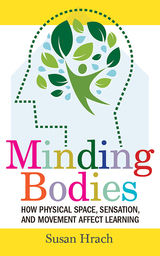 Minding Bodies: How Physical Space, Sensation, and Movement Affect Learning
Susan Hrach
West Virginia University Press, 2021 What happens to teaching when you consider the whole body (and not just “brains on sticks”)?
Starting from new research on the body—aptly summarized as “sitting is the new smoking”—Minding Bodies aims to help instructors improve their students’ knowledge and skills through physical movement, attention to the spatial environment, and sensitivity to humans as more than “brains on sticks.” It shifts the focus of adult learning from an exclusively mental effort toward an embodied, sensory-rich experience, offering new strategies to maximize the effectiveness of time spent learning together on campus as well as remotely. Minding Bodies draws from a wide range of body/mind research in cognitive psychology, kinesiology, and phenomenology to bring a holistic perspective to teaching and learning. The embodied learning approaches described by Susan Hrach are inclusive, low-tech, low-cost strategies that deepen the development of disciplinary knowledge and skills. Campus change-makers will also find recommendations for supporting a transformational mission through an attention to students’ embodied learning experiences.
 Minding Justice: Laws That Deprive People with Mental Disability of Life and Liberty
Christopher Slobogin
Harvard University Press, 2006 Minding Justice offers a comprehensive examination of the laws governing the punishment, detention, and protection of people with mental disabilities. Using famous cases such as those of John Hinckley, Andrea Yates, and Theodore Kaczynski, the book analyzes the insanity defense and related doctrines, the role of mental disability in sentencing, the laws that authorize commitment of "sexual predators" and others thought to be a threat to society, and the rules that restrict participation of mentally compromised individuals in the criminal and treatment decision-making processes.
Arguing that current legal doctrines are based on flawed premises and ignorance of the impairments caused by mental disability, Christopher Slobogin makes a case for revamping the insanity defense, abolishing the "guilty but mentally ill" verdict, prohibiting execution of people with mental disability, restructuring preventive detention, and redefining incompetency. A milestone in criminal mental health law, Minding Justice provides innovative solutions to ancient problems associated with criminal responsibility, protection of society from "dangerous" individuals, and the state's authority to act paternalistically.
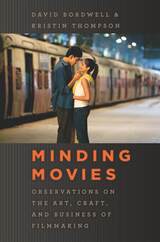 Minding Movies: Observations on the Art, Craft, and Business of Filmmaking
David Bordwell and Kristin Thompson
University of Chicago Press, 2011 David Bordwell and Kristin Thompson are two of America’s preeminent film scholars. You would be hard pressed to find a serious student of the cinema who hasn’t spent at least a few hours huddled with their seminal introduction to the field—Film Art, now in its ninth edition—or a cable television junkie unaware that the Independent Film Channel sagely christened them the “Critics of the Naughts.” Since launching their blog Observations on Film Art in 2006, the two have added web virtuosos to their growing list of accolades, pitching unconventional long-form pieces engaged with film artistry that have helped to redefine cinematic storytelling for a new age and audience. Minding Movies presents a selection from over three hundred essays on genre movies, art films, animation, and the business of Hollywood that have graced Bordwell and Thompson’s blog. Informal pieces, conversational in tone but grounded in three decades of authoritative research, the essays gathered here range from in-depth analyses of individual films such as Slumdog Millionaire and Inglourious Basterds to adjustments of Hollywood media claims and forays into cinematic humor. For Bordwell and Thompson, the most fruitful place to begin is how movies are made, how they work, and how they work on us. Written for film lovers, these essays—on topics ranging from Borat to blockbusters and back again—will delight current fans and gain new enthusiasts. Serious but not solemn, vibrantly informative without condescension, and above all illuminating reading, Minding Movies offers ideas sure to set film lovers thinking—and keep them returning to the silver screen.
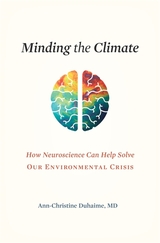 Minding the Climate: How Neuroscience Can Help Solve Our Environmental Crisis
Ann-Christine Duhaime, MD
Harvard University Press, 2022 A neurosurgeon explores how our tendency to prioritize short-term consumer pleasures spurs climate change, but also how the brain’s amazing capacity for flexibility can—and likely will—enable us to prioritize the long-term survival of humanity.
Increasingly politicians, activists, media figures, and the public at large agree that climate change is an urgent problem. Yet that sense of urgency rarely translates into serious remedies. If we believe the climate crisis is real, why is it so difficult to change our behavior and our consumer tendencies?
Minding the Climate investigates this problem in the neuroscience of decision-making. In particular, Ann-Christine Duhaime, MD, points to the evolution of the human brain during eons of resource scarcity. Understandably, the brain adapted to prioritize short-term survival over more uncertain long-term outcomes. But the resulting behavioral architecture is poorly suited to the present, when scarcity is a lesser concern and slow-moving, novel challenges like environmental issues present the greatest danger. Duhaime details how even our acknowledged best interests are thwarted by the brain’s reward system: if a behavior isn’t perceived as immediately beneficial, we probably won’t do it—never mind that we “know” we should. This is what happens when we lament climate change while indulging the short-term consumer satisfactions that ensure the disaster will continue.
Luckily, we can sway our brains, and those of others, to alter our behaviors. Duhaime describes concrete, achievable interventions that have been shown to encourage our neurological circuits to embrace new rewards. Such small, incremental steps that individuals take, whether in their roles as consumers, in the workplace, or in leadership positions, are necessary to mitigate climate change. The more we understand how our tendencies can be overridden by our brain’s capacity to adapt, Duhaime argues, the more likely we are to have a future.
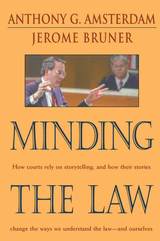 Minding the Law
Anthony G. Amsterdam and Jerome Bruner
Harvard University Press, 2000 In this remarkable collaboration, one of the nation's leading civil rights lawyers joins forces with one of the world's foremost cultural psychologists to put American constitutional law into an American cultural context. By close readings of key Supreme Court opinions, they show how storytelling tactics and deeply rooted mythic structures shape the Court's decisions about race, family law, and the death penalty.
Minding the Law explores crucial psychological processes involved in the work of lawyers and judges: deciding whether particular cases fit within a legal rule ("categorizing"), telling stories to justify one's claims or undercut those of an adversary ("narrative"), and tailoring one's language to be persuasive without appearing partisan ("rhetorics"). Because these processes are not unique to the law, courts' decisions cannot rest solely upon legal logic but must also depend vitally upon the underlying culture's storehouse of familiar tales of heroes and villains.
But a culture's stock of stories is not changeless.
Amsterdam and Bruner argue that culture itself is a dialectic constantly in progress, a conflict between the established canon and newly imagined "possible worlds." They illustrate the swings of this dialectic by a masterly analysis of the Supreme Court's race-discrimination decisions during the past century.
A passionate plea for heightened consciousness about the way law is practiced and made, Minding the Law will be welcomed by a new generation concerned with renewing law's commitment to a humane justice.
 Minding the Modern: Human Agency, Intellectual Traditions, and Responsible Knowledge
Thomas Pfau
University of Notre Dame Press, 2013
In this brilliant study, Thomas Pfau argues that the loss of foundational concepts in classical and medieval Aristotelian philosophy caused a fateful separation between reason and will in European thought. Pfau traces the evolution and eventual deterioration of key concepts of human agency—will, person, judgment, action—from antiquity through Scholasticism and on to eighteenth-century moral theory and its critical revision in the works of Samuel Taylor Coleridge. Featuring extended critical discussions of Aristotle, Gnosticism, Augustine, Aquinas, Ockham, Hobbes, Shaftesbury, Mandeville, Hutcheson, Hume, Adam Smith, and Coleridge, this study contends that humanistic concepts they seek to elucidate acquire meaning and significance only inasmuch as we are prepared positively to engage (rather than historicize) their previous usages. Beginning with the rise of theological (and, eventually, secular) voluntarism, modern thought appears increasingly reluctant and, in time unable to engage the deep history of its own underlying conceptions, thus leaving our understanding of the nature and function of humanistic inquiry increasingly frayed and incoherent. One consequence of this shift is to leave the moral self-expression of intellectual elites and ordinary citizens alike stunted, which in turn has fueled the widespread notion that moral and ethical concerns are but a special branch of inquiry largely determined by opinion rather than dialogical reasoning, judgment, and practice.
A clear sign of this regression is the present crisis in the study of the humanities, whose role is overwhelmingly conceived (and negatively appraised) in terms of scientific theories, methods, and objectives. The ultimate casualty of this reductionism has been the very idea of personhood and the disappearance of an adequate ethical language. Minding the Modern is not merely a chapter in the history of ideas; it is a thorough phenomenological and metaphysical study of the roots of today's predicaments.
“[A] learned, deeply important, and accomplished study . . . that calls upon a set of interpretive and communal traditions that, far from being fossilized, contain radical and renovating power, but whose power can be called on, extended, elaborated, and applied to the present and future only if one knows that those traditions can and do remain alive and available, and that we ignore or pronounce them 'past' at our peril. The sweep and comprehensiveness of the work are remarkable. This is not a history of philosophy at all. It is a call for us to rededicate ourselves to a serious, demanding practice of humanistic studies.” —James Engell, Gurney Professor of English and Professor of Comparative Literature, Harvard University
"Minding the Modern is comparable to Alasdair MacIntyre’s Whose Justice? Which Rationality? and Charles Taylor’s A Secular Age. With extraordinary erudition, Pfau locates the philosophical developments that contributed to the agony of the modern mind. Moreover, he helps us see why many who exemplify that intellectual stance do not recognize their own despair. Suffice it to say, this is an immensely important book that hopefully will be read widely and across the disciplines." —Stanley Hauerwas, Gilbert T. Rowe Professor of Theological Ethics, Duke Divinity School
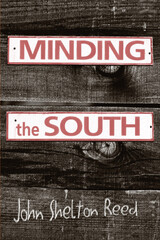 Minding the South
John Shelton Reed
University of Missouri Press, 2003
You're in the American South now, a proud region with a distinctive history and culture. A place that echoes with names like Thomas Jefferson and Robert E. Lee, Scarlett O'Hara and Uncle Remus, Martin Luther King and William Faulkner, Billy Graham, Mahalia Jackson, Muhammad Ali, Elvis Presley. Home of the country blues and country music, bluegrass and Dixieland jazz, gospel music and rock and roll. Where menus offer both down-home biscuits and gravy and uptown shrimp and grits. Where churches preach against "cigarettes, whiskey, and wild, wild women" (all Southern products) and where American football is a religion.
For more than thirty years John Shelton Reed has been “minding” the South—watching over it, providing commentary upon it. He is the author or editor of thirteen books about the South, and despite his disclaimer regarding formal study of Southern history, Reed has read widely and in depth about the South. His primary focus is upon Southerners’ present-day culture and consciousness, but he knows that one must approach the South historically in order to understand the place and its people.
Why is the South so different from the rest of the country? Rupert Vance, Reed’s predecessor in sociology at Chapel Hill, once observed that the very existence of the South is a triumph of history over geography and economics. The South has resisted being assimilated by the larger United States and has kept a personality that is distinctly its own.
That is why Reed celebrates the South. His essays cover everything from great thinkers about the South—Eugene D. Genovese, C. Vann Woodward, M. E. Bradford—to the uniqueness of a region that was once a hotbed of racism, but has recently attracted hundreds of thousands of blacks transplanted from the North. There are even a few chapters about Southerners who have devoted their talents to different subjects altogether, from politics or soft drinks to rock and roll or the design of silver jewelry. Reed writes with wit and Southern charm, never afraid to speak his mind, even when it comes to taking his beloved South to task. While readers may not share all his opinions, most will agree that John Shelton Reed is one of the best “South watchers” there is.
 Minding the Sun
Robert Pack
University of Chicago Press, 1996 With characteristic sensitivity and intelligence, Robert Pack reflects on man's relation to and responsibilities toward nature. Throughout, his verses are informed with an ecological vigilance born of his devotion to the New England landscape.
The opening section marks a return for Pack to the musical sensuality of the lyric. These short lyrics are uniquely his: the sequence begins in Vermont and concludes in the Andromeda galaxy, providing an opportunity to hold in mind the nurturing sun of our solar system.
The poems of the collection's middle section, written in the flowing narrative and meditative mode familiar to Pack's many admirers, take up the themes of human sexuality and consciousness. And the final section, replete with puns and paradoxes, shows Pack at his most playful as he muses on art, technology, romantic and marital desire, and the stubborn longing for transcendence. The poet concludes the volume with a sobering plea, "The Trees Will Die," to heed the sun's example, to cherish and protect our planet and all its living things.
Mindprints: Thoreau's Material Worlds
Ivan Gaskell
University of Chicago Press, 2024 A rediscovery of Thoreau’s interactions with everyday objects and how they shaped his thought.
Though we may associate Henry David Thoreau with ascetic renunciation, he accumulated a variety of tools, art, and natural specimens throughout his life as a homebuilder, surveyor, and collector. In some of these objects, particularly Indigenous artifacts, Thoreau perceived the presence of their original makers, and he called such objects “mindprints.” Thoreau believed that these collections could teach him how his experience, his world, fit into the wider, more diverse (even incoherent) assemblage of other worlds created and re-created by other beings every day. In this book, Ivan Gaskell explores how a profound environmental aesthetics developed from this insight and shaped Thoreau’s broader thought.
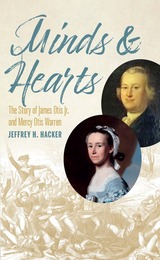 Minds and Hearts: The Story of James Otis Jr. and Mercy Otis Warren
Jeffrey H. Hacker
University of Massachusetts Press, 2021 As a firebrand attorney and political agitator, James Otis Jr. helped to shape colonial resistance in the decades leading up to the American Revolution, establishing individual rights and "no taxation without representation" as cornerstones of the patriot cause. After his violent coffeehouse altercation and bouts with mental illness, his younger sister, Mercy Otis Warren, took up his cause. Her incendiary plays and poems rallied colonial opinion in the lead-up to the war, and her chronicle of the period established her as America's first female historian.
Minds and Hearts is the dual biography of these remarkable siblings, placing James and Mercy in the spotlight together for the first time, amid the rush of events, competing ideologies, and changing social conditions of eighteenth-century America. Jeffrey H. Hacker crafts a compelling narrative that focuses on the Otises' unique and dramatic relationship and traces their impact on the Revolutionary movement in Massachusetts. If the real American Revolution took place "in the minds and hearts of the people," as John Adams claimed, then the Otises were among the nation's true patriots.
The Mind's Best Work
D. N. Perkins
Harvard University Press, 1981 Over the years, tales about the creative process have flourished-tales of sudden insight and superior intelligence and personal eccentricity. Coleridge claimed that he wrote "Kubla Khan" in one sitting after an opium-induced dream. Poe declared that his "Raven" was worked out "with the precision and rigid consequence of a mathematical problem."
D. N. Perkins discusses the creative episodes of Beethoven, Mozart, Picasso, and others in this exploration of the creative process in the arts, sciences, and everyday life.
Minds, Brains and Science
John Searle
Harvard University Press, 2005 Minds, Brains and Science takes up just the problems that perplex people, and it does what good philosophy always does: it dispels the illusion caused by the specious collision of truths. How do we reconcile common sense and science? John Searle argues vigorously that the truths of common sense and the truths of science are both right and that the only question is how to fit them together.
Searle explains how we can reconcile an intuitive view of ourselves as conscious, free, rational agents with a universe that science tells us consists of mindless physical particles. He briskly and lucidly sets out his arguments against the familiar positions in the philosophy of mind, and details the consequences of his ideas for the mind-body problem, artificial intelligence, cognitive science, questions of action and free will, and the philosophy of the social sciences.
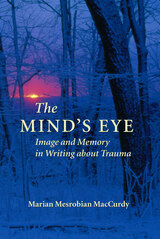 The Mind's Eye: Image and Memory in Writing about Trauma
Marian Mesrobian MacCurdy
University of Massachusetts Press, 2007 In the post-September 11 world, therapeutic writing has become a topic of heightened interest in both academic circles and the popular press, reflecting a growing awareness that writing can have a beneficial effect on the emotional and cognitive lives of survivors of traumatic experiences. Yet teachers and others who encounter such writing often are unsure how to deal with it. In The Mind's Eye: Image and Memory in Writing about Trauma, Marian Mesrobian MacCurdy investigates the relationship between writing and trauma, examines how we process difficult experiences and how writing can help us to integrate them, and provides a pedagogy to deal with the difficult life stories that often surface in the classroom.
MacCurdy begins by discussing what trauma is, how traumatic memories are stored and accessed, and how writing affects them. She then focuses on the processes involved in translating traumatic images into narrative form, showing how the same patterns and problems emerge whether the writers are students or professionals. Using examples drawn from the classroom, MacCurdy investigates the beneficial effects of the study of trauma on communities as well as individuals, witnesses as well as writers, and explores the implications of these relationships for the world at large, particularly as they pertain to issues of justice, retribution, and forgiveness.
Throughout the volume the author draws on her own experience as teacher, writer, survivor, and descendant of survivors to explain how one can engage student work on difficult subjects without appropriating the texts or getting lost in the emotions generated by them. She further shows how appropriate safeguards can be put in place to protect both teacher and student writer. The end result of such a pedagogy, MacCurdy demonstrates, is not simply better writers but more integrated people, capable of converting their own losses and griefs into compassion for others.
 Minds on Fire: How Role-Immersion Games Transform College
Mark C. Carnes
Harvard University Press, 2014 A Choice Outstanding Academic Title of the Year
In Minds on Fire, Mark C. Carnes shows how role-immersion games channel students’ competitive (and sometimes mischievous) impulses into transformative learning experiences. His discussion is based on interviews with scores of students and faculty who have used a pedagogy called Reacting to the Past, which features month-long games set during the French Revolution, Galileo’s trial, the partition of India, and dozens of other epochal moments in disciplines ranging from art history to the sciences. These games have spread to over three hundred campuses around the world, where many of their benefits defy expectations.
“[Minds on Fire is] Carnes’s beautifully written apologia for this fascinating and powerful approach to teaching and learning in higher education. If we are willing to open our minds and explore student-centered approaches like Reacting [to the Past], we might just find that the spark of student engagement we have been searching for in higher education’s mythical past can catch fire in the classrooms of the present.”
—James M. Lang, Chronicle of Higher Education
“This book is a highly engaging and inspirational study of a ‘new’ technique that just might change the way educators bring students to learning in the 21st century.”
—D. D. Bouchard, Choice
 Minds Online: Teaching Effectively with Technology
Michelle D. Miller
Harvard University Press, 2014 From wired campuses to smart classrooms to massive open online courses (MOOCs), digital technology is now firmly embedded in higher education. But the dizzying pace of innovation, combined with a dearth of evidence on the effectiveness of new tools and programs, challenges educators to articulate how technology can best fit into the learning experience. Minds Online is a concise, nontechnical guide for academic leaders and instructors who seek to advance learning in this changing environment, through a sound scientific understanding of how the human brain assimilates knowledge.
Drawing on the latest findings from neuroscience and cognitive psychology, Michelle Miller explores how attention, memory, and higher thought processes such as critical thinking and analytical reasoning can be enhanced through technology-aided approaches. The techniques she describes promote retention of course material through frequent low‐stakes testing and practice, and help prevent counterproductive cramming by encouraging better spacing of study. Online activities also help students become more adept with cognitive aids, such as analogies, that allow them to apply learning across situations and disciplines. Miller guides instructors through the process of creating a syllabus for a cognitively optimized, fully online course. She presents innovative ideas for how to use multimedia effectively, how to take advantage of learners’ existing knowledge, and how to motivate students to do their best work and complete the course.
For a generation born into the Internet age, educational technology designed with the brain in mind offers a natural pathway to the pleasures and rewards of deep learning.
Mindscapes: Philosophy, Science, and the Mind
Martin Carrier
University of Pittsburgh Press, 1997 Leading scholars in the fields of philosophy and the sciences of the mind have contributed to this newest volume in the prestigious Pittsburgh-Konstanz series. Among the problem areas discussed are folk psychology, meanings as conceptual structures, functional and qualitative properties of colors, the role of conscious mental states, representation and mental content, the impact of connectionism on the philosophy of the mind, and supervenience, emergence, and realization. Most of the essays are followed by commentaries that reflect ongoing debates in the philosophy of the mind and often develop a counterpoint to the claims of the essayists.
Mindscapes: The Geographies of Imagined Worlds
Edited by George E. Slusser and Eric S. Rabkin
Southern Illinois University Press, 1989 Eighteen essays plus four examples from the ninth annual J. Lloyd Eaton Conference on Science Fiction and Fantasy Literature at the University of California, Riverside. The concept of mindscape, Slusser and Rabkin explain, allows critics to focus on a single fundamental problem: "The constant need for a relation between mind and some being external to mind." The essayists are Poul Anderson, Wendy Doniger O’Flaherty, Ronald J. Heckelman, David Brin, Frank McConnell, George E. Slusser, James Romm, Jack G. Voller, Peter Fitting, Michael R. Collings, Pascal J. Thomas, Reinhart Lutz, Joseph D. Miller, Gary Westfahl, Bill Lee, Max P. Belin, William Lomax, and Donald M. Hassler. The book concludes with four authors discussing examples of mindscape. The participants are Jean-Pierre Barricelli, Gregory Benford, Gary Kern, and David N. Samuelson.
 Mindsight: Image, Dream, Meaning
Colin McGinn
Harvard University Press, 2006 How to imagine the imagination is a topic that draws philosophers the way flowers draw honeybees. From Plato and Aristotle to Wittgenstein and Sartre, philosophers have talked and written about this most elusive of topics--that is, until contemporary analytic philosophy of mind developed. Perhaps it is the vast range of the topic that has scared off our contemporaries, ranging as it does from mental images to daydreams.
The guiding thread of this book is the distinction Colin McGinn draws between perception and imagination. Clearly, seeing an object is similar in certain respects to forming a mental image of it, but it is also different. McGinn shows what the differences are, arguing that imagination is a sui generis mental faculty. He goes on to discuss the nature of dreaming and madness, contending that these are primarily imaginative phenomena. In the second half of the book McGinn focuses on what he calls cognitive (as opposed to sensory) imagination, and investigates the role of imagination in logical reasoning, belief formation, the understanding of negation and possibility, and the comprehension of meaning. His overall claim is that imagination pervades our mental life, obeys its own distinctive principles, and merits much more attention.
 Mine Towns: Buildings for Workers in Michigan’s Copper Country
Alison K. Hoagland
University of Minnesota Press, 2010 During the nineteenth century, the Keweenaw Peninsula of Northern Michigan was the site of America’s first mineral land rush as companies hastened to profit from the region’s vast copper deposits. In order to lure workers to such a remote location—and work long hours in dangerous conditions—companies offered not just competitive wages but also helped provide the very infrastructure of town life in the form of affordable housing, schools, health-care facilities, and churches. The first working-class history of domestic life in Copper Country company towns during the boom years of 1890 to 1918, Alison K. Hoagland’s Mine Towns investigates how the architecture of a company town revealed the paternal relationship that existed between company managers and workers—a relationship that both parties turned to their own advantage. The story of Joseph and Antonia Putrich, immigrants from Croatia, punctuates and illustrates the realities of life in a booming company town. While company managers provided housing as a way to develop and control a stable workforce, workers often rejected this domestic ideal and used homes as an economic resource, taking in boarders to help generate further income. Focusing on how the exchange between company managers and a largely immigrant workforce took the form of negotiation rather than a top-down system, Hoagland examines surviving buildings and uses Copper Country’s built environment to map this remarkable connection between a company and its workers at the height of Michigan’s largest land rush.
A Minefield of Dreams: Triumphs and Travails of Independent Writing Programs
Justin Everett
University Press of Colorado, 2017 In A Minefield of Dreams: Triumphs and Travails of Independent Writing Programs, Justin Everett and Cristina Hanganu-Bresch highlight both cautionary tales and stories of resounding success that can inspire and provide paths toward addressing the challenges faced by faculty who lead independent writing programs (IWPs). More than a decade after O'Neill, Crow, and Burton's survey of IWPs—and with attention to some of the same programs addressed in that collection—the contributors to this collection assess the state of IWPs at a variety of American and Canadian institutions. The four sections in the book address key issues faced by IWPs: the quest for independence; disciplinarity, labor, and professionalization; curricular reforms, program design, and faculty training and empowerment; and rhetorics of transformation and justice.
 Mineral Point: A History
George Fiedler
Wisconsin Historical Society Press, 1973 In 1827, almost overnight, the lead-bearing region of southwestern Wisconsin was flooded by English-speaking miners and settlers who founded the settlement of Mineral Point. Originally known as Shake Rag Under the Hill, it quickly became the booming capital of the mining area. In a few years’ time the outpost’s fame had spread throughout the upper Mississippi Valley, bringing English miners emigrating from Cornwall to set their stamp forever on the architecture and the social life of Mineral Point. Eventually lead mining gave way to zinc, and Mineral Point was surpassed in size and importance by other Wisconsin towns; but the charm of its hills and the grace of its houses remained, a historical legacy from the settlers of territorial Wisconsin. This is the story of Mineral Point from its origins to the mid-twentieth century, when a rekindled interest in the area’s storied past began with the restoration of Pendarvis House.
Mineralogy of Arizona
John W. Anthony, Sidney A. Williams, Richard A. Bideaux, and Raymond W. Grant
University of Arizona Press, 1995
Long awaited by professional geologists and amateur rockhounds alike, the new Mineralogy of Arizona is a completely revised and greatly expanded edition of a book first published in 1977 and updated in 1982. New material covers 232 minerals discovered in Arizona since the first edition, including 28 first identified in the state. Also new is a section on the history of Arizona mining and mineralogy, which provides context for understanding the significance of mineral discoveries and production since prehistoric times.
For nearly 20 years, Mineralogy of Arizona has been respected as the definitive reference on Arizona minerals. Now completely revised and greatly expanded with breathtaking new color photographs, the third edition covers 232 minerals discovered in Arizona since the first edition, including 28 first identified in the state.
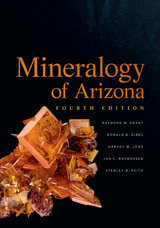 Mineralogy of Arizona, Fourth Edition
Raymond W. Grant, Ronald B. Gibbs, Harvey W. Jong, Jan C. Rasmussen, and Stanley B. Keith
University of Arizona Press, 2022 Completely revised and expanded, this fourth edition covers the 986 minerals found in Arizona, showcased with breathtaking new color photographs throughout the book. The new edition includes more than 200 new species not reported in the third edition and previously unknown in Arizona.
Chapters in this fourth edition of Mineralogy of Arizona cover gemstones and lapidary materials, fluorescent minerals, and an impressive catalog of mineral species. The authors also discuss mineral districts, including information about the geology, mineralogy, and age of mineral occurrences throughout the state. The book includes detailed maps of each county, showing the boundaries and characteristics of the mineral districts present in the state.
Arizona’s rich mineral history is well illustrated by the more than 300 color photographs of minerals, gemstones, and fluorescent minerals that help the reader identify and understand the rich and diverse mineralogy of Arizona. Anyone interested in the mineralogy and geology of the state will find this the most up-to-date compilation of the minerals known to occur in Arizona.
Minerals of Nevada
Stephen B. Castor
University of Nevada Press, 2012 Nevada has an extraordinary diversity of minerals, some of them unique to the state and some the focus of human exploitation for millennia. Minerals of Nevada is the first synoptic catalog of Nevada minerals, listing every mineral found in the state along with the places where they occur. The book includes the geologic history of the state, the history of mining in Nevada, descriptions of significant mineral deposits and mining districts, maps, and an album of striking color photographs of rare and important minerals.
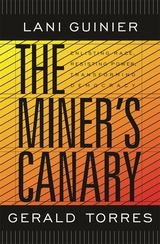 The Miner’s Canary: Enlisting Race, Resisting Power, Transforming Democracy
Lani Guinier and Gerald Torres
Harvard University Press, 2002 Like the canaries that alerted miners to a poisonous atmosphere, issues of race point to underlying problems in society that ultimately affect everyone, not just minorities. Addressing these issues is essential. Ignoring racial differences--race blindness--has failed. Focusing on individual achievement has diverted us from tackling pervasive inequalities. Now, in a powerful and challenging book, Lani Guinier and Gerald Torres propose a radical new way to confront race in the twenty-first century.
Given the complex relationship between race and power in America, engaging race means engaging standard winner-take-all hierarchies of power as well. Terming their concept "political race," Guinier and Torres call for the building of grass-roots, cross-racial coalitions to remake those structures of power by fostering public participation in politics and reforming the process of democracy. Their illuminating and moving stories of political race in action include the coalition of Hispanic and black leaders who devised the Texas Ten Percent Plan to establish equitable state college admissions criteria, and the struggle of black workers in North Carolina for fair working conditions that drew on the strength and won the support of the entire local community.
The aim of political race is not merely to remedy racial injustices, but to create truly participatory democracy, where people of all races feel empowered to effect changes that will improve conditions for everyone. In a book that is ultimately not only aspirational but inspirational, Guinier and Torres envision a social justice movement that could transform the nature of democracy in America.
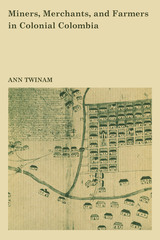 Miners, Merchants, and Farmers in Colonial Colombia
By Ann Twinam
University of Texas Press, 1982 The inhabitants of the department of Antioquía in north-central Colombia have played a unique role in that country’s economic history. During the colonial period Antioqueño placer miners supplied a substantial portion of New Granada’s gold exports. Their nineteenth-century descendants pioneered investments in lode mining, colonization, international commerce, banking, stock raising, tobacco, and coffee. In the twentieth century, Antioqueños initiated the industrialization of the regional capital, Medellín. Many theories have been set forth to account for the special energy and initiative of Antioqueños. They range from ethnic and psychological interpretations (Antioqueños are descended from Jews or Basques; they are driven to succeed because of status deprivation) to historical explanations that emphasize their geographic isolation, mining heritage, or the coffee-export economy. In Miners, Merchants, and Farmers in Colonial Colombia, Ann Twinam critiques these theories and sets forth her own revisionist interpretation of Antioqueño enterprise. Rather than emphasize the alien or deviant in Antioqueño psychology or culture, Twinam re-creates the region’s late colonial economic and social structure and attributes the origins of Antioqueño enterprise to a particular mix of human and natural resources that directed the region’s development toward capital accumulation and reinvestment. Although the existing limitations of their colonial environment may have forced Antioqueños along enterprising pathways initially, the continuation of Antioqueño investments to the present day suggests that their adaptation to a specific economic reality became a way of life transcending the historical conditions that created it.
Minerva and the Muse: A Life of Margaret Fuller
Doe Coover Agency
University of Massachusetts Press, 1996 Writer, teacher, and outspoken feminist, Fuller (1810-1850) was a dynamic presence in American intellectual life through her work as the editor of The Dial, the first woman journalist for the New York Tribune, author of the influential Woman in the 19th Century, and her relationships with Emerson, Thoreau, Sand, and others. This biography follows her on her journey through Boston's social and intellectual circles, New York's literary world, to Rome as an expatriate journalist, and to her untimely demise in a shipwreck at age 40.
 Minerva’s Owl: The Tradition of Western Political Thought
Jeffrey Abramson
Harvard University Press, 2009 Informal in tone yet serious in content, this book serves as a lively and accessible guide for readers discovering the tradition of political thought that dates back to Socrates and Plato. Because the arguments of the great philosophers are nearly eternal, even those long schooled on politics will find that this book calls on recurring questions about morality and power, justice and war, the risk of democracy, the necessity for evil, the perils of tolerance, and the meaning of happiness. Jeffrey Abramson argues politics with the classic writers and draws the reader into a spirited conversation with contemporary examples that illustrate the enduring nature of political dilemmas. As the discussions deepen, the voices of Abramson’s own teachers, and of the students he has taught, enter into the mix, and the book becomes a tribute not just to the great philosophers but also to the special bond between teacher and student.
As Hegel famously noted, referring to the Roman goddess Minerva, her owl brought back wisdom only at dusk, when it was too late to shine light on actual politics. Abramson reminds us that there are real political problems to confront, and in a book filled with grace and passion, he captures just how exciting serious learning can be.
The Ming Dynasty: Its Origins and Evolving Institutions
Charles O. Hucker
University of Michigan Press, 1978 In the latter half of the fourteenth century, at one end of the Eurasian continent, the stage was not yet set for the emergence of modern nation-states. At the other end, the Chinese drove out their Mongol overlords, inaugurated a new native dynasty called Ming (1368–1644), and reasserted the mastery of their national destiny. It was a dramatic era of change, the full significance of which can only be perceived retrospectively. With the establishment of the Ming dynasty, a major historical tension rose into prominence between more absolutist and less absolutist modes of rulership. This produced a distinctive style of rule that modern students have come to call Ming despotism. It proved a capriciously absolutist pattern for Chinese government into our own time. [1, 2 ,3]
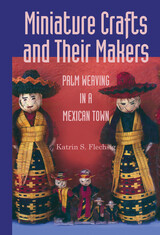 Miniature Crafts and Their Makers: Palm Weaving in a Mexican Town
Katrin Flechsig
University of Arizona Press, 2004 Picture a throng of tiny devils and angels, or a marching band so small it can fit in the palm of your hand. In a Mixtec town in the Mexican state of Puebla, craftspeople have been weaving palm since before the Spanish Conquest, but over the past forty years that art has become more finely tuned and has won national acceptance in a market nostalgic for an authentic Indian past. In this book, Katrin Flechsig offers the first in-depth ethnographic and historical examination of the miniature palm craft industry, taking readers behind the scenes of craft production in order to explain how and why these folk arts have undergone miniaturization over the past several decades. In describing this "Lilliputization of Mexico," she discusses the appeal of miniaturization, revealing how such factors as tourism and the construction of national identity have contributed to an ongoing demand for the tiny creations. She also contrasts the playfulness of the crafts with the often harsh economic and political realities of life in the community. Flechsig places the crafts of Chigmecatitlán within the contexts of manufacturing, local history, religion, design and technique, and selling. She tells how innovation is introduced into the craft, such as through the modification of foreign designs in response to market demands. She also offers insights into capitalist penetration of folk traditions, the marketing of folk arts, and economic changes in modern Mexico. And despite the fact that the designations "folk" and "Indian" help create a romantic fiction surrounding the craft, Flechsig dispels common misperceptions of the simplicity of this folk art by revealing the complexities involved in its creation. More than thirty illustrations depict not only finished miniatures but also the artists and their milieu. Today miniatures serve not only the tourist market; middle-class Mexicans also collect miniatures to such an extent that it has been termed a national pastime. Flechsig’s work opens up this miniature world and shows us the extent to which it has become a lasting and important facet of contemporary Mexican culture.
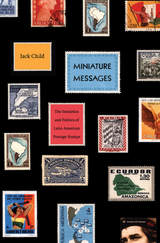 Miniature Messages: The Semiotics and Politics of Latin American Postage Stamps
Jack Child
Duke University Press, 2008 In Miniature Messages, Jack Child analyzes Latin American postage stamps, revealing the messages about history, culture, and politics encoded in their design and disseminated throughout the world. While postage stamps are a sanctioned product of official government agencies, Child argues that they accumulate popular cultural value and take on new meanings as they circulate in the public sphere. As he demonstrates in this richly illustrated study, the postage stamp conveys many of the contestations and triumphs of Latin American history. Child combines history and political science with philatelic research of nearly forty thousand Latin American stamps. He focuses on Argentina and the Southern Cone, highlighting stamps representing the consolidation of the Argentine republic and those produced under its Peronist regime. He compares Chilean stamps issued by the leftist government of Salvador Allende and by Augusto Pinochet’s dictatorship. Considering postage stamps produced under other dictatorial regimes, he examines stamps from the Dominican Republic, Guatemala, Nicaragua, and Paraguay. Child studies how international conflicts have been depicted on the stamps of Argentina, Chile, and Peru, and he pays particular attention to the role of South American and British stamps in establishing claims to the Malvinas/Falkland Islands and to Antarctica. He also covers the cultural and political history of stamps in Bolivia, Brazil, Colombia, Cuba, Grenada, Mexico, Uruguay, Venezuela and elsewhere. In Miniature Messages, Child finds the political history of modern Latin America in its “tiny posters.”
 Miniature Metropolis: Literature in an Age of Photography and Film
Andreas Huyssen
Harvard University Press, 2015 In the late nineteenth and early twentieth centuries, Europe’s modernizing metropolises offered a sensory experience unlike anything that had come before. Cities became laboratories bubbling with aesthetic experimentation in old and new media, and from this milieu emerged metropolitan miniatures—short prose pieces about the experiences of urban life written for European newspapers. Miniature Metropolis explores the history and theory of this significant but misrecognized achievement of literary modernism.
Andreas Huyssen shows how writers from Baudelaire and Kafka to Benjamin, Musil, and Adorno created the miniature to record their reflections of Paris, Brussels, Prague, Vienna, Berlin, and Los Angeles. Contesting photography and film as competing media, the metropolitan miniature sought to capture the visceral feeling of acceleration and compression that defined urban existence. But the form did not merely imitate visual media—it absorbed them, condensing objective and subjective perceptions into the very structure of language and text and asserting the aesthetic specificity of literary language without resort to visual illustration. Huyssen argues that the miniature subverted the expectations of transparency, easy understanding, and entertainment that mass circulation newspapers depended upon. His fine-grained readings open broad vistas into German critical theory and the history of visual arts, revealing the metropolitan miniature to be one of the few genuinely innovative modes of spatialized writing created by modernism.
The Miniaturists
Barbara Browning
Duke University Press, 2022 In The Miniaturists Barbara Browning explores her attraction to tininess and the stories of those who share it. Interweaving autobiography with research on unexpected topics and letting her voracious curiosity guide her, Browning offers a series of charming short essays that plumb what it means to ponder the minuscule. She is as entranced by early twentieth-century entomologist William Morton Wheeler, who imagined corresponding with termites, as she is by Frances Glessner Lee, the “mother of forensic science,” who built intricate dollhouses to solve crimes. Whether examining Honey, I Shrunk the Kids, the Schoenhut toy piano dynasty, portrait miniatures, diminutive handwriting, or Jonathan Swift’s and Lewis Carroll’s preoccupation with tiny people, Browning shows how a preoccupation with all things tiny can belie an attempt to grasp vast---even cosmic---realities.
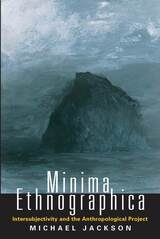 Minima Ethnographica: Intersubjectivity and the Anthropological Project
Michael Jackson
University of Chicago Press, 1998 The postmodern opposition between theory and lived reality has led in part to an anthropological turn to "dialogic" or "reflexive" approaches. Michael Jackson claims these approaches are hardly radical as they still drift into such abstractions as "society" or "culture." His Minima Ethnographica proposes an existential anthropology that recognizes even abstract relationships as modalities of interpersonal life.
Written in the style of Theodor Adorno's Minima Moralia, Jackson's work shows how general ideas are always anchored in particular social events and critical concerns. Emphasizing the intersubjective encounter over objective descriptions of the whole historical and contemporary situation of a given people, he illustrates the power and originality of existential anthropology through a series of vignettes from his fieldwork in Sierra Leone and Australia. An award-winning poet, novelist, and anthropologist, Jackson offers a timely critique of conventions that dull our sense of the links between academic study and lived experience.
 Minimal Damage: Stories of Veterans
H. Lee Barnes
University of Nevada Press, 2013 In the seven stories and novella of Minimal Damage, veterans search for dignity in a civilian life that has no need for men who were soldiers. Finding themselves psychically scarred, in crisis, on the fringes of society, or in battle with their memories, these men are living "like warts on America's ass." The characters range from the enigmatic Mr. K, who runs a reality television show and once led an escape from a Korean pow camp, to the doomed Billy Debecki, who regains his dignity in the last minutes of his life by remembering that he once willingly risked his life to save an enemy soldier. In one story, a man who was never a soldier finds a path toward reconciliation with his brother, a former Marine. In another, a man recalls becoming a soldier by watching the humanity of a fellow recruit disintegrate in basic training. In the novella "Snake Boy," a homeless Vietnam vet is kidnapped by a snake-handling evangelist. In proper, upstanding lives and lost, drifting ones, the depth of damage is never immediately apparent for these men. In war, chance, luck, and arbitrary timing conspire to determine a soldier's fate. As civilians, the same uncontrollable forces influence who finds a place in society and who is doomed to keep searching. With emotion, humor, and clarity, Barnes creates characters who show us what it is to live with the trauma of having experienced combat. The fractured souls and lives of these men remind us that the damage doesn't remain on the battlefield. Western Literature Series.
Minimal Ethics for the Anthropocene
Joanna Zylinska
Michigan Publishing, 2014 Minimal Ethics for the Anthropocene considers our human responsibility for the world, at a time when life finds itself under a unique threat. Its goal is to rethink “life” and what we can do with it, in whatever time we have left—as individuals and as a species. This speculative, poetic book also includes a photographic project by the author.
Minimum Wages in Central and Eastern Europe: From Protection to Destitution
Guy Standing
Central European University Press, 1995 Since the late 1980s, incomes have fallen sharply in most countries of Central and Eastern Europe, while unemployment and poverty rates have risen dramatically. In most countries during that period, the statutory minimum wage has been supposed to be an anchor of the social protection system and the wage structure, protecting the low-paid and those dependent on state benefits. Unfortunately for those affected, the level of the minimum wage has been allowed to drop to well below the "poverty level" and has ceased to protect anyone. This book considers the evidence and the implications of this development, and recommends a series of reforms.
Mining America: The Industry and the Environment, 1800-1980
Duane A. Smith
University Press of Colorado, 1994 Mining America is a vivid account of the damage wrought by almost two centuries of mining, but its main focus is on the conflicting attitudes behind the destruction and on society's responses. Veteran author and historian Duane Smith asserts that the marriage of mining and environmental issues was bound to touch America's sensitive pocketbook nerve - but the question now is, are all groups willing to pay the price?
Mining among the Clouds: The Mosquito Range and the Origins of Colorado's Silver Boom
Harvey N. Gardiner
University Press of Colorado, 2002 In Mining Among the Clouds, Harvey N. Gardiner examines what one reporter dubbed "aerial" mining - silver mining at such high altitudes that the miners were literally working among the clouds. In the summer of 1871, two prospectors ventured high up Mount Bross in Colorado's Mosquito Range. There they discovered an outcropping of silver ore in blue limestone. An unprecedented find, it set off strike after strike in Park County. Thus began the silver boom that gave rise to Leadville, laying the foundation for Colorado's Silver Decade.
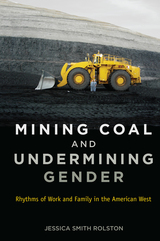 Mining Coal and Undermining Gender: Rhythms of Work and Family in the American West
Jessica Smith Rolston
Rutgers University Press, 2014 Winner of the 2018 Distinguished Book Award from the Western Social Science Association
Though mining is an infamously masculine industry, women make up 20 percent of all production crews in Wyoming’s Powder River Basin—the largest coal-producing region in the United States. How do these women fit into a working culture supposedly hostile to females? This is what anthropologist Jessica Smith Rolston, herself a onetime mine worker and the daughter of a miner, set out to discover. Her answers, based on years of participant-observation in four mines and extensive interviews with miners, managers, engineers, and the families of mine employees, offer a rich and surprising view of the working “families” that miners construct. In this picture, gender roles are not nearly as straightforward—or as straitened—as stereotypes suggest.
Gender is far from the primary concern of coworkers in crews. Far more important, Rolston finds, is protecting the safety of the entire crew and finding a way to treat each other well despite the stresses of their jobs. These miners share the burden of rotating shift work—continually switching between twelve-hour day and night shifts—which deprives them of the daily rhythms of a typical home, from morning breakfasts to bedtime stories. Rolston identifies the mine workers’ response to these shared challenges as a new sort of constructed kinship that both challenges and reproduces gender roles in their everyday working and family lives.
Crews’ expectations for coworkers to treat one another like family and to adopt an “agricultural” work ethic tend to minimize gender differences. And yet, these differences remain tenacious in the equation of masculinity with technical expertise, and of femininity with household responsibilities. For Rolston, such lingering areas of inequality highlight the importance of structural constraints that flout a common impulse among men and women to neutralize the significance of gender, at home and in the workplace.
At a time when the Appalachian region continues to dominate discussion of mining culture, this book provides a very different and unexpected view—of how miners live and work together, and of how their lives and work reconfigure ideas of gender and kinship.
Mining Cultures: Men, Women, and Leisure in Butte, 1914-41
Mary Murphy
University of Illinois Press, 1997 Butte, Montana, long deserved its reputation as a wide-open town. Mining Cultures shows how the fabled Montana city evolved from a male-dominated mining enclave to a community in which men and women participated on a more equal basis as leisure patterns changed and consumer culture grew. Mary Murphy looks at how women worked and spent their leisure time in a city dominated by the quintessential example of "men's work": mining. Bringing Butte to life, she adds in-depth research on church weeklies, high school yearbooks, holiday rituals, movie plots, and news of local fashion to archival material and interviews. A richly illustrated jaunt through western history, Mining Cultures is the never-told chronicle of how women transformed the richest hill on earth.
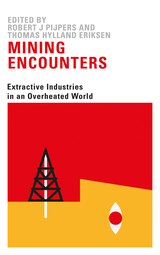 Mining Encounters: Extractive Industries in an Overheated World
Edited by Thomas Hylland Eriksen and Robert J. Pijpers
Pluto Press, 2018 We live in a fast-changing world, where the extraction of natural resources is both the key to development and at the same times is a source of environmental and social disasters. Understanding how landscapes, people, and politics are shaped by the mining industries in today’s world is crucial.
Mining Encounters paints a broad picture, looking at resource extraction in numerous locations at different stages of development—covering coal, natural gas, gold, and cement mining in North, West, and South Africa, as well as in India, Kazakhstan, and Australia. The chapters answer key questions: How does mining transform the physical landscape? What are the value systems underlying the world’s mining industries? And how does the process of extracting resources determine which stakeholders become dominant and which marginalized?
Uncovering the tensions, negotiations, and disparities among different actors in the extractive industries, Mining Encounters will make a vital contribution to policy debates moving forward.
Mining in a Medieval Landscape: The Royal Silver Mines of the Tamar Valley
Stephen Rippon, Peter Claughton, and Christopher Smart
University of Exeter Press, 2009
Mining in a Medieval Landscape explores the history and archaeology of the late medieval royal silver mines at Bere Ferrers in Devon’s Tamar Valley and examines their significance for mining history as a whole. Comparing their impact on the landscape with that of less intensive, traditional mining industries, this authoritative volume analyzes maps and documents together in light of recent archaeological field surveys, allowing the mining landscape to be reconstructed in remarkable detail.
Mining in Africa: Regulation and Development
Bonnie Campbell
Pluto Press, 2009 The continent of Africa is rich in minerals needed by Western economies, but rather than forming the basis for economic growth the mining industry contributes very little to African development
Investigating the impact of the 2003 Extractive Industries Review on a number of African countries, the contributors find that a key dimension of the problem lies in the regulatory frameworks imposed on the African countries by the IMF and World Bank. They aim to convince academics, governments and industry that regulation needs to be reformed to create a mining industry favourable to social and economic development and environmental protection.
The book takes a multidisciplinary approach and provides a historical perspective of each country, making it ideal for students of development studies and development organisations.
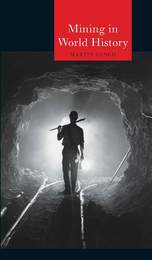 Mining in World History
Martin Lynch
Reaktion Books, 2004 This book deals with the history of mining and smelting from the Renaissance to the present. Martin Lynch opens with the invention, sometime before 1453, of a revolutionary technique for separating silver from copper. It was this invention which brought back to life the rich copper-silver mines of central Europe, in the process making brass cannon and silver coin available to the ambitious Habsburg emperors, thereby underpinning their quest for European domination. Lynch also discusses the Industrial Revolution and the far-reaching changes to mining and smelting brought about by the steam engine; the era of the gold rushes; the massive mineral developments and technological leaps forward which took place in the USA and South Africa at the end of the 19th century; and, finally, the spread of mass metal-production techniques amid the violent struggles of the 20th century. In an engaging, concise and fast-paced text, he presents the interplay of personalities, politics and technology that have shaped the metallurgical industries over the last 500 years.
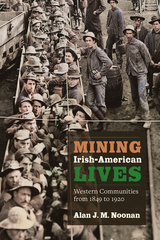 Mining Irish-American Lives: Western Communities from 1849 to 1920
Alan J. M. Noonan
University Press of Colorado, 2022 Mining Irish-American Lives focuses on the importance and influence of the Irish within the mining frontier of the American West. Scholarship of the West has largely ignored the complicated lives of the Irish people in mining towns, whose life details are often kept to a bare minimum. This book uses individual stories and the histories of different communities—Randsburg, California; Virginia City, Nevada; Leadville, Colorado; Butte, Montana; Idaho’s Silver Valley; and the Comstock Lode, for example—to explore Irish and Irish-American lives.
Historian Alan J. M. Noonan uses a range of previously overlooked sources, including collections of emigrant letters, hospital logbooks, private detective reports, and internment records, to tell the stories of Irish men and women who emigrated to mining towns to search for opportunity. Noonan details the periods, the places, and the experiences over multiple generations in the late nineteenth and early twentieth centuries. He carefully examines their encounters with nativists, other ethnic groups, and mining companies to highlight the contested emergence of a hyphenated Irish-American identity.
Unearthing personal details along with the histories of different communities, the book investigates Irish immigrants and Irish-Americans through the prism of their own experiences, significantly enriching the history of the period.
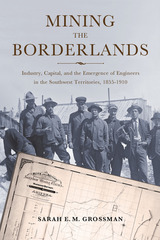 Mining the Borderlands: Industry, Capital, and the Emergence of Engineers in the Southwest Territories, 1855-1910
Sarah E. M. Grossman
University of Nevada Press, 2018 At the dawn of the twentieth century, the US-Mexico border was home to some of the largest and most technologically advanced industrial copper mines. This despite being geographically, culturally, and financially far-removed from traditional urban centers of power. Mining the Borderlands argues that this was only possible because of the emergence of mining engineers—a distinct technocratic class of professionals who connected capital, labor, and expertise. Mining engineers moved easily between remote mining camps and the upscale parlors of east coast investors. Working as labor managers and technical experts, they were involved in the daily negotiations, which brought private US capital to the southwestern border. The success of the massive capital-intensive mining ventures in the region depended on their ability to construct different networks, serving as intermediaries to groups that rarely coincided.
Grossman argues that this didn’t just lead to bigger and more efficient mines, but served as part of the ongoing project of American territorial and economic expansion. By integrating the history of technical expertise into the history of the transnational mining industry, this in-depth look at borderlands mining explains how American economic hegemony was established in a border region peripheral to the federal governments of both Washington, D.C. and Mexico City.
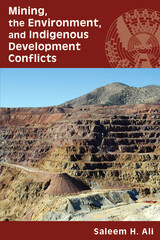 Mining, the Environment, and Indigenous Development Conflicts
Saleem H. Ali
University of Arizona Press, 2003 From sun-baked Black Mesa to the icy coast of Labrador, native lands for decades have endured mining ventures that have only lately been subject to environmental laws and a recognition of treaty rights. Yet conflicts surrounding mining development and indigenous peoples continue to challenge policy-makers.
This book gets to the heart of resource conflicts and environmental impact assessment by asking why indigenous communities support environmental causes in some cases of mining development but not in others. Saleem Ali examines environmental conflicts between mining companies and indigenous communities and with rare objectivity offers a comparative study of the factors leading to those conflicts.
Mining, the Environment, and Indigenous Development Conflicts presents four cases from the United States and Canada: the Navajos and Hopis with Peabody Coal in Arizona; the Chippewas with the Crandon Mine proposal in Wisconsin; the Chipewyan Inuits, Déné and Cree with Cameco in Saskatchewan; and the Innu and Inuits with Inco in Labrador. These cases exemplify different historical relationships with government and industry and provide an instance of high and low levels of Native resistance in each country. Through these cases, Ali analyzes why and under what circumstances tribes agree to negotiated mining agreements on their lands, and why some negotiations are successful and others not.
Ali challenges conventional theories of conflict based on economic or environmental cost-benefit analysis, which do not fully capture the dynamics of resistance. He proposes that the underlying issue has less to do with environmental concerns than with sovereignty, which often complicates relationships between tribes and environmental organizations. Activist groups, he observes, fail to understand such tribal concerns and often have problems working with tribes on issues where they may presume a common environmental interest.
This book goes beyond popular perceptions of environmentalism to provide a detailed picture of how and when the concerns of industry, society, and tribal governments may converge and when they conflict. As demands for domestic energy exploration increase, it offers clear guidance for such endeavors when native lands are involved.
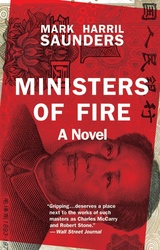 Ministers of Fire: A Novel
Mark Harril Saunders
Ohio University Press, 2012 Kabul, Afghanistan, 1979: CIA station chief Lucius Burling, an idealistic but flawed product of his nation’s intelligence establishment, barely survives the assassination of the American ambassador. Burling’s reaction to the murder, and his desire to understand its larger meaning, propel him on a journey of intrigue and betrayal that will reach its ultimate end in the streets of Shanghai, months after 9/11. A Chinese dissident physicist may (or may not) be planning to sell his country’s nuclear secrets, and in his story Burling, now living quietly as consul, recognizes the fingerprints of a covert operation, one without the obvious sanction of the Agency. The dissident’s escape draws the violent attention of the Chinese internal security service, and as Burling is drawn inexorably into their path, he must face the ghosts of his past misadventures and a present world of global trafficking, fragile alliances, and the human need for connection above all. Reminiscent of the best work of Graham Greene and John le Carré, Ministers of Fire extends the spy thriller into new historical, political, and emotional territory.
Ministers of Reform: The Progressives' Achievement in American Civilization, 1889-1920
Robert M. Crunden
University of Illinois Press, 1982 Ministers of Reform vividly depicts the spiritual odyssey of an entire generation and shows how Protestant roots and a common "climate of creativity" nurtured a host of Progressive leaders from all walks of life. Crunden demonstrates that the same spirit of nnovation and moral rectitude so typical of the era's politics also characterized its artistic endeavors.
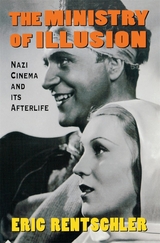 Ministry of Illusion: Nazi Cinema and Its Afterlife
Eric Rentschler
Harvard University Press, 1996 German cinema of the Third Reich, even a half-century after Hitler's demise, still provokes extreme reactions. "Never before and in no other country," observes director Wim Wenders, "have images and language been abused so unscrupulously as here, never before and nowhere else have they been debased so deeply as vehicles to transmit lies." More than a thousand German feature films that premiered during the reign of National Socialism survive as mementoes of what many regard as film history's darkest hour.
As Eric Rentschler argues, however, cinema in the Third Reich emanated from a Ministry of Illusion and not from a Ministry of Fear. Party vehicles such as Hitler Youth Quex and anti-Semitic hate films such as Jew Süss may warrant the epithet "Nazi propaganda," but they amount to a mere fraction of the productions from this era. The vast majority of the epoch's films seemed to be "unpolitical"--melodramas, biopix, and frothy entertainments set in cozy urbane surroundings, places where one rarely sees a swastika or hears a "Sieg Heil."
Minister of propaganda Joseph Goebbels, Rentschler shows, endeavored to maximize film's seductive potential, to cloak party priorities in alluring cinematic shapes. Hitler and Goebbels were master showmen enamored of their media images, the Third Reich was a grand production, the Second World War a continuing movie of the week. The Nazis were movie mad, and the Third Reich was movie made. Rentschler's analysis of the sophisticated media culture of this period demonstrates in an unprecedented way the potent and destructive powers of fascination and fantasy. Nazi feature films--both as entities that unreeled in moviehouses during the regime and as productions that continue to enjoy wide attention today--show that entertainment is often much more than innocent pleasure.
 A Ministry of Presence: Chaplaincy, Spiritual Care, and the Law
Winnifred Fallers Sullivan
University of Chicago Press, 2014 Most people in the United States today no longer live their lives under the guidance of local institutionalized religious leadership, such as rabbis, ministers, and priests; rather, liberals and conservatives alike have taken charge of their own religious or spiritual practices. This shift, along with other social and cultural changes, has opened up a perhaps surprising space for chaplains—spiritual professionals who usually work with the endorsement of a religious community but do that work away from its immediate hierarchy, ministering in a secular institution, such as a prison, the military, or an airport, to an ever-changing group of clients of widely varying faiths and beliefs.
In A Ministry of Presence, Winnifred Fallers Sullivan explores how chaplaincy works in the United States—and in particular how it sits uneasily at the intersection of law and religion, spiritual care, and government regulation. Responsible for ministering to the wandering souls of the globalized economy, the chaplain works with a clientele often unmarked by a specific religious identity, and does so on behalf of a secular institution, like a hospital. Sullivan's examination of the sometimes heroic but often deeply ambiguous work yields fascinating insights into contemporary spiritual life, the politics of religious freedom, and the never-ending negotiation of religion's place in American institutional life.
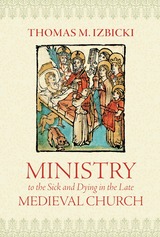 Ministry to the Sick and Dying in the Late Medieval Church
Thomas M. Izbicki
Catholic University of America Press, 2023 The focus of this volume is on ministry to the sick and dying in the later Middle Ages, especially providing them with the sacraments. Medieval writers linked illness to sin and its forgiveness. The priest, as physician of souls, was expected to heal the soul, preparing it for the hereafter. His ministry might also effect healing of bodies, when that healing did not endanger the soul. This book treats how a priest prepared to visit sick persons and went to them in procession with the Eucharist and oil of the sick. The priest was to comfort the patient and, if death was imminent, prepare the soul for the hereafter. Canon law, theology, and ritual sources are employed. Three sacraments, penance, viaticum, (final communion) and extreme unction (anointing of the sick) are treated in detail. Sickbed confession was designed to forgive the ailing person's mortal sins. A priest could absolve a dying person of all sins, even those reserved to a bishop or the pope. Viaticum was to strengthen a suffering Christian for life's last conflict, that between angels and demons for the soul of the dying person. The deathbed thus was a spiritual battlefield. Extreme unction was reserved for those in danger of death, relieving the soul of venial sins or "the remains of sin," even after confession and absolution. The commendatio animae (commendation of the soul) used with the dying was to usher the soul into the afterlife. Many works have been written about attitudes toward death, dying, and the afterlife in the Middle Ages. Likewise, there is a good deal of literature about individual sacraments. This study aims at bridging between these literatures, with a focus on the priest and parishioner in both theory and practice at the sickbed.
 The Minjung Art Movement: Decolonization and Democracy in South Korea
Sohl Lee
Duke University Press, 2026 Emerging as multifaceted cultural activism, the minjung (people’s) art movement defined the aesthetics of the pro-democracy movements in the 1970s and 1980s in South Korea. Tracing minjung art’s history and legacy, Sohl Lee explores how artists associated with the movement mobilized images, print, and performance to build movement publics and reimagine sovereignty. Hundreds of artists questioned the underlying assumptions of liberal democracies and the art-making practices of the global Cold War. Their decolonial critiques of international modernism were inseparable from reimagining democracy and refiguring the relationship between art and democracy. Recuperating overlooked performance-oriented practices and the protest aesthetics that helped usher in parliamentary democracy in 1987, Lee shows that South Korea’s globalization in the 1990s and its rise as cultural soft power in the new millennium cannot be understood apart from a pro-democracy culture that was both political and popular.
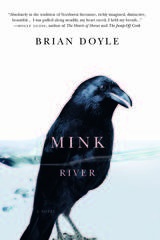 Mink River
Brian Doyle
Oregon State University Press, 2010 Like Dylan Thomas’ Under Milk Wood and Sherwood Anderson’s Winesburg, Ohio, Brian Doyle’s stunning fiction debut brings a town to life through the jumbled lives and braided stories of its people. In a small town on the Oregon coast there are love affairs and almost-love-affairs, mystery and hilarity, bears and tears, brawls and boats, a garrulous logger and a silent doctor, rain and pain, Irish immigrants and Salish stories, mud and laughter. There’s a Department of Public Works that gives haircuts and counts insects, a policeman addicted to Puccini, a philosophizing crow, beer and berries. An expedition is mounted, a crime committed, and there’s an unbelievably huge picnic on the football field. Babies are born. A car is cut in half with a saw. A river confesses what it’s thinking… It’s the tale of a town, written in a distinct and lyrical voice, and readers will close the book more than a little sad to leave the village of Neawanaka, on the wet coast of Oregon, beneath the hills that used to boast the biggest trees in the history of the world.
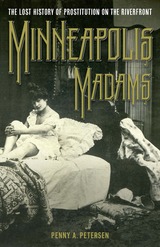 Minneapolis Madams: The Lost History of Prostitution on the Riverfront
Penny A. Petersen
University of Minnesota Press, 2013
Sex, money, and politics—no, it’s not a thriller novel. Minneapolis Madams is the surprising and riveting account of the Minneapolis red-light district and the powerful madams who ran it. Penny Petersen brings to life this nearly forgotten chapter of Minneapolis history, tracing the story of how these “houses of ill fame” rose to prominence in the late nineteenth century and then were finally shut down in the early twentieth century.
In their heyday Minneapolis brothels were not only open for business but constituted a substantial economic and political force in the city. Women of independent means, madams built custom bordellos to suit their tastes and exerted influence over leading figures and politicians. Petersen digs deep into city archives, period newspapers, and other primary sources to illuminate the Minneapolis sex trade and its opponents, bringing into focus the ideologies and economic concerns that shaped the lives of prostitutes, the men who used their services, and the social-purity reformers who sought to eradicate their trade altogether. Usually written off as deviants, madams were actually crucial components of a larger system of social control and regulation. These entrepreneurial women bought real estate, hired well-known architects and interior decorators to design their bordellos, and played an important part in the politics of the developing city. Petersen argues that we cannot understand Minneapolis unless we can grasp the scope and significance of its sex trade. She also provides intriguing glimpses into racial interactions within the vice economy, investigating an African American madam who possibly married into one of the city’s most prestigious families. Fascinating and rigorously researched, Minneapolis Madams is a true detective story and a key resource for anyone interested in the history of women, sexuality, and urban life in Minneapolis.
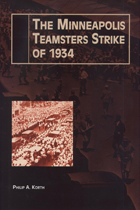 Minneapolis Teamsters Strike of 1934
Philip Korth
Michigan State University Press, 1995
The 1934 Minneapolis Teamsters Strike proved to be a pivotal event in twentieth-century American labor history. The Minneapolis Teamsters challenged the muscle of big business, as well as the authority of local, state, and federal government, and in the process they changed the very nature of labor relations in the United States. In The Minneapolis Teamsters Strike of 1934, Philip Korth's description of events surrounding this landmark labor action are filtered through the recollections of the people who were there. Korth blends historical record with the words of actual participants to draw a thorough and compelling portrait of a labor strike and its consequences. Philip Korth's study illustrates the organizational strategies that made the Minneapolis strike a success, as well as how opposition and public perception defined emerging labor relations practices and public policy. At the same time, the author provides an in-depth examination of the conflict through interviews with witnesses and participants in this pivotal event in labor history.
Minnesota: A History of the State
Theodore C. Blegen
University of Minnesota Press, 2004 In an engaging and readable style, renowned historian Theodore Blegen takes the reader on a tour of Minnesota's development, from the geological events that shaped the land to westward movement to twentieth-century modernization. This second edition includes a concluding chapter by Russell W. Fridley that chronicles the impact of turbulent national politics and cultural changes of the 1960s and 1970s on the state, as well as an extensive reading list and detailed index. Minnesota is a concise yet comprehensive account of the state's progress, highlighting landmarks in politics, technology, the arts, and architecture.
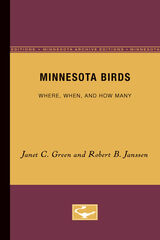 Minnesota Birds: Where, When, and How Many
Janet Green
University of Minnesota Press, 1980
Minnesota Birds was first published in 1975.This is an indispensable guidebook for birders in Minnesota, both amateur and professional, and a useful reference work for naturalists elsewhere as well. It provides information about each of the 374 species sighted in the state -- in what seasons they are present, how abundant they are, and in what areas they are likely to be found. The account for each species is divided in three sections: migration, including distribution, abundance, and dates; summer season, including breeding range and nesting records; and winter season, including distribution and abundance. Both authors are highly experienced ornithologists. Janet C. Green lives in Duluth and does much of her fieldwork on the North Shore of Lake Superior and in the northwoods. Robert B. Janssen, who lives in Chanhassen, is former editor of The Loon, the journal of the Minnesota Ornithologists’ Union, and has done fieldwork throughout the state. Harrison B. Tordoff, former director of the James Ford Bell Museum of Natural History at the University of Minnesota, writes a foreword.
 The Minnesota Department of Taxation: An Administrative History
Lloyd Short
University of Minnesota Press, 1955
The Minnesota Department of Taxation: An Administrative History was first published in 1955. Minnesota Archive Editions uses digital technology to make long-unavailable books once again accessible, and are published unaltered from the original University of Minnesota Press editions. Number 3 in Studies in Administration, a series sponsored by the Public Administration Training Center at the University of Minnesota; established in 1936 to provide instruction, research facilities, and information in the field of public administration.This volume presents an account of tax administration history that seeks to better acquaint the citizens of Minnesota with the origin and development of their tax system and its operation by state government. Topics include: the organization and political framework of the Minnesota tax administration; central staff functions; general and specialized property tax administration; death and gift taxes; and the administration of income, cigarette, and petroleum taxes.
 Minnesota Farmer-Laborism: The Third-Party Alternative
Millard L. Gieske
University of Minnesota Press, 1979 Minnesota Farmer-Laborism was first published in 1979. Minnesota Archive Editions uses digital technology to make long-unavailable books once again accessible, and are published unaltered from the original University of Minnesota Press editions. Minnesota's Farmer-Labor party, a coalition of reformers and radicals ,farmers and unionists, flourished in the state during the years between world wars. Unlike most third parties, it gained political power and for a time virtually displaced the near-moribund Democratic party, vying successfully with Republicans for congressional and state offices. In this book, Millard L. Gieske provides the first detailed history of the Farmer-Labor movement from its inception late in World War I down to its merger with the state Democratic party in 1944. Gieske finds the origins of the Farmer-Labor party in the Populist and Progressive movements, its specific forebears in the farmers' cooperative movement and the Nonpartisan League. Radical union members in Minneapolis, St. Paul, and the Iron Range, dissatisfied with the conservative program of the American Federation of Labor, gave the party an additional economic base. Most Farmer-Labor adherents shared the belief that the political and economic systems were un-responsive and that the two parties were either unwilling to reform them or incapable of doing so. Down the years, the Farmer-Labor movement was subject to mercurial shifts in its strength and effectiveness. Gieske's narrative covers the party's squabbles and near collapse in the late 1920s and its resurgence in the 1930s during the Great Depression. He emphasizes the divergent and often conflicting elements that made up the party, traces its tortuous relation with Communists, and notes that significance of foreign policy issues in a movement concerned for the most part with domestic economic issues. The Farmer-Labor party attracted some of the state's most vivid political figures, whom Gieske skillfully portrays -- Henrik Shipstead, Floyd B. Olson, Elmer Benson, and others. Primarily the story of a specific party, the book also examines the role of the third-party movement in a two-party system. Minnesota Farmer-Laborism is based largely on primary sources and will be a valuable work not only for political historians but also for readers who are interested in Minnesota history or in radical political movements.
Minnesota History: A Study Outline
Theodore C. Blegen
University of Minnesota Press, 1931
Minnesota History was first published in 1931. Minnesota Archive Editions uses digital technology to make long-unavailable books once again accessible, and are published unaltered from the original University of Minnesota Press editions.
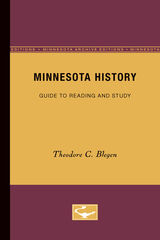 Minnesota History: Guide to Reading and Study
Theodore C. Blegen
University of Minnesota Press, 1960
Minnesota History was first published in 1960. Minnesota Archive Editions uses digital technology to make long-unavailable books once again accessible, and are published unaltered from the original University of Minnesota Press editions.
Anyone interested in Minnesota history, whether as a teacher, as a student, or as a general reader, will find this an invaluable guide to reading and study. The book contains an outline of the state's history, questions and suggestions for the student, and lists of reading material for each of the 42 topical sections into which the outline is divided.
The outline covers the entire history of the state from the time of the Indians, before the French and British explorations, to the present. The reading references include accounts written from the seventeenth through the twentieth centuries. The aim in preparing the reading lists was to include any article or book bearing upon the Minnesota story which met the qualifications of good historical writing and fair accessibility. Materials of particular interest or importance to the topic under consideration are so designated, and there are liberal annotations to help the reader in his choice of readings. References which are particularly appropriate for young readers are also specially designated. A number of maps are provided for additional guidance.
This is a complete revision of a book long out of print, Minnesota History: A Study Outline by Theodore C. Blegen.
|
|
